
www.latticesemi.com
1
orli10g_03
ORCA
ORLI10G
Quad 2.5Gbps, 10Gbps
Quad 3.125Gbps, 12.5Gbps Line Interface FPSC
February 2003
Data Sheet
�
� 2003 Lattice Semiconductor Corp. All Lattice trademarks, registered trademarks, patents, and disclaimers are as listed at www.latticesemi.com/legal. All other
brand or product names are trademarks or registered trademarks of their respective holders. The specifications and information herein are subject to change without
notice.
Introduction
Lattice has developed a new
ORCA
Series 4-based FPSC which combines a high-speed line interface with a flexi-
ble FPGA logic core. Built on the Series 4 reconfigurable embedded System-on-a-Chip (SoC) architecture, the
ORLI10G consists of an OIF standard compliant (OIF-SFI4-01.0) SFI-4.1 or
IEEE
�
802.3ae compliant XSBI, 10
Gbits/s or 12.5 Gbits/s transmit and 10 Gbits/s or 12.5 Gbits/s receive line interface.
Both transmit and receive interfaces consist of 16-bit LVDS data at up to 850 Mbits/s, integrated transmit and
receive programmable PLLs for data rate conversions between the line-side and system-side data rates, and a pro-
grammable logic interface at the system end for use with SONET/SDH, Ethernet, or OTN/digital wrapper with
strong FEC system device data standards. In addition to the embedded functionality, the device includes over 400k
of usable FPGA gates. The line interface includes logic to divide the data rate down to 212 MHz or less (1/4 line
rate) or 106 MHz or less (1/8 line rate) for transfer to the FPGA logic. The ORLI10G is designed to connect to a
plethora of industry standard devices on the line side. The programmable logic interface on the system side allows
direct connection to a 10 Gbits/s Ethernet MAC, a 10 Gbits/s SONET/SDH framer/data engine, or a 10 Gbits/s/12.5
Gbits/s digital wrapper/FEC framer/data engine.
For 10 Gbits/s Ethernet, the ORLI10G supports the Physical Coding Sublayer (PCS), interfaces to the Physical
Media Attachment (PMA), and connects to the system interface (host or switch) for the proposed
IEEE
802.3ae 10
Gbits/s serial LAN PHY.
The ORLI10G FPSC is a high-speed programmable device for 10 Gbits/s data solutions. It can be used as the
interface between the line interface and the system interface in a variety of emerging networks, including 10 Gbits/s
SONET/SDH (OC-192/STM-48), 10 Gbits/s Optical Transport Networks (OTN) using digital wrapper and strong
FEC, or 10 Gbits/s Ethernet. Other functions include use in quad OC-48/ STM-16 SONET/SDH systems, interfaces
between quad OC-48/STM-16 and OC-192/STM-64 components, and use as a generic data transfer mechanism
between two devices at 10 Gbits/s rates. Data is received at the line interface and then sent to either a 4-bit or 8-bit
serial-to-parallel converter. On the transmit interface, either a 4-bit or 8-bit parallel-to-serial converter is used. Thus,
the data rate at the internal FPGA interface is either 1/4 or 1/8 the line rate.
The programmable PLLs on the ORLI10G provide for great flexibility in handling clock rate conversion due to differ-
ing amounts of overhead bits in various system data standards. For example, the ORLI10G can divide down the
STS-192/STM-64 SONET/SDH data line rate of 622 MHz by 4 to synchronize with a 155 MHz system clock, or the
12.5 Gbits/s Super-FEC data line rate of 781 MHz can be divided by 8 MHz to 98 MHz system clock or by 8 x 4/5 to
provide a 78 MHz system data rate.
Table 1. ORCA ORLI10G�Available FPGA Logic (equivalent to ORCA OR4E04)
* 316 are available in the 680 PBGAM package.
Note: The embedded core, embedded system bus, FPGA interface and MPI are not included in the above gate counts. The System Gate
ranges are derived from the following: minimum system gates assumes 100% of the PFUs are used for logic only (no PFU RAM) with
40% EBR usage and 2 PLLs. Maximum system gates assumes 80% of the PFUs are for logic, 20% are used for PFU RAM, with 80%
EBR usage and 6 PLLs.
Device
PFU Rows
PFU Col-
umns
Total PFUs
FPGA Max.
User I/Os*
LUTs
EBR
Blocks
EBR Bits
(k)
FPGA Sys-
tem Gates
(k)
ORLI10G
36
36
1,296
316
10,368
12
111
333--643

Lattice Semiconductor
ORCA ORLI10G Data Sheet
2
Embedded Function Features
� Provides a line-interface to system-interface with various system standards such as OC-192/STM-64
SONET/SDH, quad OC-48/STM-16 10 Gbits/s Ethernet, and 10 Gbits/s OTN (digital wrapper/strong FEC) or
12.5 Gbits/s SuperFEC.
� Embedded PLLs with programmable M/N multiplication/division values provide flexible data rate conversion
between line side and system side.
� Line-side supports 16-bit LVDS data with multiple line frequencies supported up to 850 MHz, depending on sys-
tem standard.
� Line-side interface, including timing and jitter specifications, compliant to OIF 99.102.5 standard.
� Receive-side interface can be split into four separate asynchronous 2.5 Gbits/s interfaces (4-bit LVDS data inter-
face for each) with a separate clock for each for transfer to the FPGA logic.
� Data and clock rates divided by 4 or 8 for use in FPGA logic.
� LVDS I/Os compliant with
EIA
�
-644 support hot insertion. All embedded LVDS I/Os include both input and output
on-board termination to allow high-speed operation.
� Low-power LVDS buffers.
Intellectual Property Features
Programmable logic provides a variety of yet-to-be standardized interface functions, including the following IP core
functions:
� 10 Gbits/s Ethernet Physical Coding Sublayer (PCS), as defined by
IEEE
802.3ae:
� XGMII for interfacing to 10 Gbits/s Ethernet MACs. XGMII is a 156 MHz double data rate parallel short-reach
(typically less than 3 in.) interconnect interface.
� Elastic store buffers for clock domain transfer to/from the XGMII interface.
� X
59
+ X
39
+ X
1
scrambler/descrambler for 10 Gbits/s Ethernet.
� 64b/66b encoders/decoders for 10 Gbits/s Ethernet.
� Idle insertion and deletion.
� SMI interface for control and status.
� Quad 2.5 Gbits/s SONET/SDH to 10 Gbits/s SONET/SDH MUX/deMUX functions.
Programmable Features
� High-performance programmable logic:
� 0.16 �m 7-level metal technology.
� Internal performance of >250 MHz.
� Over 400k usable FPGA system gates.
� Meets multiple I/O interface standards.
� 1.5 V operation (30% less power than 1.8 V operation) translates to greater performance.
� Traditional I/O selections:
� LVTTL (3.3 V) and LVCMOS (2.5 V, and 1.8 V) I/Os.
� Per pin selectable I/O clamping diodes provide 3.3 V PCI compliance.
� Individually programmable drive capability:
24 mA sink/12 mA source, 12 mA sink/6 mA source, or 6 mA sink/3 mA source.
� Two slew rates supported (fast and slew limited).
� Fast-capture input latch and input Flip-Flop latch for reduced input setup time and zero hold time.
� Fast open-drain drive capability.
� Capability to register 3-state enable signal.
� Off-chip clock drive capability.
� Two input function generator in output path.

Lattice Semiconductor
ORCA ORLI10G Data Sheet
3
� New programmable high-speed I/O:
� Single-ended: GTL, GTL+, PECL, SSTL3/2 (class I and II), HSTL (Class I, III, IV), ZBT, and DDR.
� Double-ended: LVDS, bused-LVDS, LVPECL. Programmable (on/off) internal parallel termination (100
)
also supported for these I/Os.
� New capability to (de)multiplex I/O signals:
� New DDR on both input and output at rates up to 350 MHz (700 MHz effective rate).
� New 2x and 4x downlink and uplink capability per I/O (i.e., 50 MHz internal to 200 MHz I/O).
� Enhanced twin-quad Programmable Function Unit (PFU):
� Eight 16-bit Look-Up Tables (LUTs) per PFU.
� Nine user registers per PFU, one following each LUT, organized to allow two nibbles to act independently,
plus one extra for arithmetic operations.
� New register control in each PFU has two independent programmable clocks, clock enables, local set/reset,
and data selects.
� New LUT structure allows flexible combinations of LUT4, LUT5, new LUT6, 4 : 1 MUX, new 8 : 1 MUX, and
ripple mode arithmetic functions in the same PFU.
� 32 x 4 RAM per PFU, configurable as single- or dual-port. Create large, fast RAM/ROM blocks (128 x 8 in
only eight PFUs) using the SLIC decoders as bank drivers.
� Soft-Wired LUTs (SWL) allow fast cascading of up to three levels of LUT logic in a single PFU through fast
internal routing, which reduces routing congestion and improves speed.
� Flexible fast access to PFU inputs from routing.
� Fast-carry logic and routing to all four adjacent PFUs for nibble-wide, byte-wide, or longer arithmetic func-
tions, with the option to register the PFU carry-out.
� Abundant high-speed buffered and nonbuffered routing resources provide 2x average speed improvements over
previous architectures.
� Hierarchical routing optimized for both local and global routing with dedicated routing resources. This results in
faster routing times with predictable and efficient performance.
� SLIC provides eight 3-stable buffers, up to a 10-bit decoder, and
PAL
TM-like AND-OR-INVERT (AOI) in each pro-
grammable logic cell.
� New 200 MHz embedded quad-port RAM blocks, two read ports, two write ports, and two sets of byte lane
enables. Each embedded RAM block can be configured as:
� 1--512 x 18 (quad-port, two read/two write) with optional built-in arbitration.
� 1--256 x 36 (dual-port, one read/one write).
� 1--1k x 9 (dual-port, one read/one write).
� 2--512 x 9 (dual-port, one read/one write for each).
� 2 RAMs with arbitrary number of words whose sum is 512 or less by 18 (dual-port, one read/one write).
� Supports joining of RAM blocks.
� Two 16 x 8-bit Content Addressable Memory (CAM) support.
� FIFO 512 x 18, 256 x 36, 1k x 9, or dual 512 x 9.
� Constant multiply (8 x 16 or 16 x 8).
� Dual variable multiply (8 x 8).
� Embedded 32-bit internal system bus plus 4-bit parity interconnects FPGA logic, MicroProcessor Interface (MPI),
embedded RAM blocks, and embedded standard cell blocks with 100 MHz bus performance. Included are built-
in system registers that act as the control and status center for the device.
� Built-in testability:
� Full boundary scan (
IEEE
1149.1 and draft 1149.2 JTAG) for the programmable I/Os only.
� Programming and readback through boundary-scan port compliant to
IEEE
Draft 1532:D1.7.
� TS_ALL testability function to 3-state all I/O pins.
� New temperature-sensing diode.
� Improved built-in clock management with Programmable Phase-Locked Loops (PPLLs) provides optimum clock
modification and conditioning for phase, frequency, and duty cycle from 20 MHz up to

Lattice Semiconductor
ORCA ORLI10G Data Sheet
4
420 MHz. Multiplication of input frequency up to 64x and division of input frequency down to 1/64x is possible.
� New cycle stealing capability allows a typical 15% to 40% internal speed improvement after final place and route.
This feature also supports compliance with many setup/hold and clock-to-out I/O specifications, and may provide
reduced ground bounce for output buses by allowing flexible delays of switching output buffers.
Programmable Logic System Features
� PCI local bus compliant for FPGA I/Os.
� Improved
PowerPC
�
/PowerQUICC 860, and
PowerPC
/PowerQUICC II MPC8260 high-speed synchronous
microprocessor interface can be used for configuration, readback, device control, and device status, as well as
for a general-purpose interface to the FPGA logic, RAMs, and embedded standard-cell blocks. Glueless interface
to synchronous
PowerPC
processors with user-configurable address space is provided.
� New embedded
AMBA
TM specification 2.0 AHB system bus (
ARM
�
processor) facilitates communication among
the microprocessor interface, configuration logic, embedded block RAM, FPGA logic, and embedded standard
cell blocks.
� Variable-size bused readback of configuration data capability with the built-in microprocessor interface and sys-
tem bus.
� Internal, 3-state, and bidirectional buses with simple control provided by the SLIC.
� New clock routing structures for global and local clocking significantly increases speed and reduces skew (<200
ps for OR4E04).
� New local clock routing structures allow creation of localized clock trees.
� Two new edge clock structures allow up to six highspeed clocks on each edge of the device for improved
setup/hold and clock-to-out performance.
� New Double-Data Rate (DDR) and Zero-Bus Turn-around (ZBT) memory interfaces support the latest high-
speed memory interfaces.
� New 2x/4x uplink and downlink I/O capabilities interface high-speed external I/Os to reduced-speed internal
logic.
� ispLEVER development system software. Supported by industry-standard CAE tools for design entry, synthesis,
simulation, and timing analysis.
� Meets Universal Test and Operations PHY Interface for ATM (UTOPIA) Levels 1, 2, and 3 as well as POS-PHY3.
Also meets proposed specifications for UTOPIA Level 4 and POS-PHY4 for 10 Gbits/s interfaces.
� Meets POS-PHY3 (2.5 Gbits/s) and POS-PHY4 (10 Gbits/s) interface standards for packet-over-SONET as
defined by the Saturn Group.

Lattice Semiconductor
ORCA ORLI10G Data Sheet
5
Description
FPSC Definition
FPSCs, or Field-Programmable System Chips, are devices that combine field-programmable logic with ASIC, or
mask-programmed logic, on a single device. FPSCs provide the time to market and the flexibility of FPGAs, the
design effort savings of using soft intellectual property (IP) cores, and the speed, design density, and economy of
ASICs.
FPSC Overview
Lattice's Series 4 FPSCs are created from Series 4
ORCA
FPGAs. To create a Series 4 FPSC, several columns of
programmable logic cells (see FPGA Logic Overview section for FPGA logic details) are added to an embedded
logic core. Other than replacing some FPGA gates with ASIC gates, at greater than 10:1 efficiency, none of the
FPGA functionality is changed; all of the Series 4 FPGA capability is retained: embedded block RAMs, MPI, PCMs,
boundary scan, etc. Columns of programmable logic are replaced on one side of the device, allowing pins from the
replaced columns to be used as I/O pins for the embedded core. The remainder of the device pins retain their
FPGA functionality.
FPSC Gate Counting
The total gate count for an FPSC is the sum of its embedded core (standard-cell/ASIC gates) and its FPGA gates.
Because FPGA gates are generally expressed as a usable range with a nominal value, the total FPSC gate count
is sometimes expressed in the same manner. Standard-cell ASIC gates are, however, 10 to 25 times more silicon-
area efficient than FPGA gates. Therefore, an FPSC with an embedded function is gate equivalent to an FPGA with
a much larger gate count.
FPGA/Embedded Core Interface
The interface between the FPGA logic and the embedded core has been enhanced to provide a greater number of
interface signals than on previous FPSC architectures. Compared to bringing embedded core signals off-chip, this
on-chip interface is much faster and requires less power. All of the delays for the interface are precharacterized and
accounted for in the ispLEVER Development System.
Series 4-based FPSCs expand this interface by providing a link between the embedded block and the multimaster
32-bit system bus in the FPGA logic. This system bus allows the core easy access to many of the FPGA logic func-
tions, including the embedded block RAMs and the microprocessor interface.
Clock spines also can pass across the FPGA/embedded core boundary. This allows fast, low-skew clocking
between the FPGA and the embedded core. Many of the special signals from the FPGA, such as DONE and global
set/reset, are also available to the embedded core, making it possible to fully integrate the embedded core with the
FPGA as a system.
For even greater system flexibility, FPGA configuration RAMs are available for use by the embedded core. This
supports user-programmable options in the embedded core, in turn allowing greater flexibility. Multiple embedded
core configurations may be designed into a single device with user-programmable control over which configura-
tions are implemented, as well as the capability to change core functionality simply by reconfiguring the device.
ispLEVER Development System
The ispLEVER development system is used to process a design from a netlist to a configured FPGA. This system
is used to map a design onto the
ORCA
architecture and then place and route it using ispLEVER's timing-driven
tools. The development system also includes interfaces to, and libraries for, other popular CAE tools for design
entry, synthesis, simulation, and timing analysis.
The ispLEVER development system interfaces to front-end design entry tools and provides the tools to produce a
configured FPGA. In the design flow, the user defines the functionality of the FPGA at two points in the design flow,
the design entry and the bit stream generation stage. Recent improvements in ispLEVER allow the user to provide

Lattice Semiconductor
ORCA ORLI10G Data Sheet
6
timing requirement information through logical preferences only; thus, the designer is not required to have physical
knowledge of the implementation.
Following design entry, the development system's map, place, and route tools translate the netlist into a routed
FPGA. A floor planner is available for layout feedback and control. A static timing analysis tool is provided to deter-
mine design speed, and a back-annotated netlist can be created to allow simulation and timing.
Timing and simulation output files from ispLEVER are also compatible with many third-party analysis tools. A bit
stream generator is then used to generate the configuration data which is loaded into the FPGAs internal configu-
ration RAM, embedded block RAM, and/or FPSC memory.
When using the bit stream generator, the user selects options that affect the functionality of the FPGA. Combined
with the front-end tools, ispLEVER produces configuration data that implements the various logic and routing
options discussed in this data sheet.
FPSC Design Kit
Development is facilitated by an FPSC design kit which, together with ispLEVER software and third-party synthesis
and simulation engines, provides all software and documentation required to design and verify an FPSC implemen-
tation. Included in the kit are the FPSC configuration manager,
Synopsys Smart Model
�
, and/or compiled
Verilog
�
simulation model,
HSPICE
�
and/or IBIS models for I/O buffers, and complete online documentation. The kit's soft-
ware couples with ispLEVER software, providing a seamless FPSC design environment. More information can be
obtained by visiting the Lattice website at www.latticesemi.com or contacting a local sales office.
FPGA Logic Overview
The
ORCA
Series 4 architecture is a new generation of SRAM-based programmable devices from Lattice. It
includes enhancements and innovations geared toward today's high-speed systems on a single chip. Designed
with networking applications in mind, the Series 4 family incorporates system-level features that can further reduce
logic requirements and increase system speed.
ORCA
Series 4 devices contain many new patented enhance-
ments and are offered in a variety of packages and speed grades.
The hierarchical architecture of the logic, clocks, routing, RAM, and system-level blocks create a seamless merge
of FPGA and ASIC designs. Modular hardware and software technologies enable System-on-a-Chip integration
with true plug-and-play design implementation.
The architecture consists of four basic elements: Programmable Logic Cells (PLCs), Programmable I/O cells
(PIOs), Embedded Block RAMs (EBRs), and system level features. These elements are interconnected with a rich
routing fabric of both global and local wires. An array of PLCs are surrounded by common interface blocks which
provide an abundant interface to the adjacent PLCs or system blocks. Routing congestion around these critical
blocks is eliminated by the use of the same routing fabric implemented within the programmable logic core. Each
PLC contains a PFU, (Supplementary Logic Interconnect) SLIC, local routing resources, and configuration RAM.
Most of the FPGA logic is performed in the PFU, but decoders,
PAL
-like functions, and 3-state buffering can be per-
formed in the SLIC. The PIOs provide device inputs and outputs and can be used to register signals and to perform
input demultiplexing, output multiplexing, uplink and downlink functions, and other functions on two output signals.
Large blocks of 512 x 18 quadport RAM complement the existing distributed PFU memory. The RAM blocks can be
used to implement RAM, ROM, FIFO, multiplier, and CAM. Some of the other system-level functions include the
MPI, PLLs, and the Embedded System Bus (ESB).
PLC Logic
Each PFU within a PLC contains eight 4-input (16-bit) LUTs, eight latches/Flip-Flops, and one additional Flip-Flop
that may be used independently or with arithmetic functions.
The PFU is organized in a twin-quad fashion; two sets of four LUTs and Flip-Flops that can be controlled indepen-
dently. Each PFU has two independent programmable clocks, clock enables, local set/reset, and data selects.
LUTs may also be combined for use in arithmetic functions using fast-carry chain logic in either 4-bit or 8-bit
modes. The carry-out of either mode may be registered in the ninth Flip-Flop for pipelining. Each PFU may also be

Lattice Semiconductor
ORCA ORLI10G Data Sheet
7
configured as a synchronous 32 x 4 single- or dual-port RAM or ROM. The Flip-Flops (or latches) may obtain input
from LUT outputs or directly from invertible PFU inputs, or they can be tied high or tied low. The Flip-Flops also
have programmable clock polarity, clock enables, and local set/reset.
The SLIC is connected from PLC routing resources and from the outputs of the PFU. It contains eight 3-state, bidi-
rectional buffers, and logic to perform up to a 10-bit AND function for decoding, or an AND-OR with optional
INVERT to perform
PAL
-like functions. The 3-state drivers in the SLIC and their direct connections from the PFU
outputs make fast, true, 3-state buses possible within the FPGA, reducing required routing and allowing for real-
world system performance.
Programmable I/O
The Series 4 PIO addresses the demand for the flexibility to select I/Os that meet system interface requirements.
I/Os can be programmed in the same manner as in previous
ORCA
devices, with the additional new features that
allow the user the flexibility to select new I/O types that support high-speed interfaces.
Each PIO contains four programmable I/O pads and is interfaced through a common interface block to the FPGA
array. The PIO is split into two pairs of I/O pads with each pair having independent clock enables, local set/reset,
and global set/reset. On the input side, each PIO contains a programmable latch/Flip-Flop which enables very fast
latching of data from any pad. The combination provides very low setup requirements and zero hold times for sig-
nals coming on-chip. It may also be used to demultiplex an input signal, such as a multiplexed address/data signal,
and register the signals without explicitly building a demultiplexer with a PFU.
On the output side of each PIO, an output from the PLC array can be routed to each output Flip-Flop, and logic can
be associated with each I/O pad. The output logic associated with each pad allows multiplexing of output signals
and other functions of two output signals.
The output Flip-Flop, in combination with output signal multiplexing, is particularly useful for registering address
signals to be multiplexed with data, allowing a full clock cycle for the data to propagate to the output. The output
buffer signal can be inverted, and the 3-state control can be made active-high, active-low, or always enabled. In
addition, this 3-state signal can be registered or nonregistered.
The Series 4 I/O logic has been enhanced to include modes for speed uplink and downlink capabilities. These
modes are supported through shift register logic, which divides down incoming data rates or multiplies up outgoing
data rates. This new logic block also supports high-speed DDR mode requirements where data is clocked into and
out of the I/O buffers on both edges of the clock.
The new programmable I/O cell allows designers to select I/Os which meet many new communication standards,
permitting the device to hook up directly without any external interface translation. They support traditional FPGA
standards as well as high-speed, single-ended, and differential-pair signaling. Based on a programmable, bank-ori-
ented I/O ring architecture, designs can be implemented using 3.3 V, 2.5 V, 1.8 V, and 1.5 V referenced output lev-
els.
Routing
The abundant routing resources of the Series 4 architecture are organized to route signals individually or as buses
with related control signals. Both local and global signals utilize high-speed buffered and nonbuffered routes. One
PLC segmented (x1), six PLC segmented (x6), and bused half-chip (xHL) routes are patterned together to provide
high connectivity with fast software routing times and high-speed system performance.
Eight fully distributed primary clocks are routed on a low-skew, high-speed distribution network and may be
sourced from dedicated I/O pads, PLLs, or the PLC logic. Secondary and edge-clock routing are available for fast
regional clock or control signal routing for both internal regions and on device edges. Secondary clock routing can
be sourced from any I/O pin, PLLs, or the PLC logic.

Lattice Semiconductor
ORCA ORLI10G Data Sheet
8
The improved routing resources offer great flexibility in moving signals to and from the logic core. This flexibility
translates into an improved capability to route designs at the required speeds when the I/O signals have been
locked to specific pins.
System-Level Features
The Series 4 also provides system-level functionality by means of its microprocessor interface, embedded system
bus, quad-port embedded block RAMs, universal programmable phase-locked loops, and the addition of highly
tuned networking specific phase-locked loops. These functional blocks support easy glueless system interfacing
and the capability to adjust to varying conditions in today's high-speed networking systems.
Microprocessor Interface
The MPI provides a glueless interface between the FPGA and
PowerPC
microprocessors. Programmable in 8-bit,
16-bit, and 32-bit interfaces with optional parity to the
Motorola
�
PowerPC
860 bus, it can be used for configuration
and readback, as well as for FPGA control and monitoring of FPGA status. All MPI transactions utilize the Series 4
embedded system bus at 66 MHz performance.
The MPI provides, following configuration, a system-level microprocessor interface through the system bus to the
user-defined logic within the FPGA, and includes access to the embedded block RAM. The MPI supports burst
data read and write transfers, allowing short, uneven transmission of data through the interface by including data
FIFOs. Transfer accesses can be single beat (1 x 4 bytes or less), 4-beat (4 x 4 bytes), 8-beat (8 x 2 bytes), or 16-
beat (16 x 1 bytes).
The 32-bit device identification code (device_id) for the ORLI10G is at system bus register address 0x0-0x3. (see
Figure 1.)
Figure 1. ORLI10G 32-bit Device Identification Code
System Bus
An on-chip, multimaster, 8-bit system bus with 1-bit parity facilitates communication among the MPI, configuration
logic, FPGA control, and status registers, embedded block RAMs, as well as user logic. Utilizing the
AMBA
specifi-
cation Rev 2.0 AHB protocol, the embedded system bus offers arbiter, decoder, master, and slave elements.
The system bus control registers can provide control to the FPGA such as signaling for reprogramming, reset func-
tions, and PLL programming. Status registers monitor INIT, DONE, and system bus errors. An interrupt controller is
integrated to provide up to eight possible interrupt resources. Bus clock generation can be sourced from the micro-
processor interface clock, configuration clock (for slave configuration modes), internal oscillator, user clock from
routing, or port clock (for JTAG configuration modes). In the ORLI10G FPSC, the system bus is not connected to
the embedded core.
Phase-Locked Loops
Four user PLLs are provided for ORCA Series 4 FPSCs. Programmable PLLs can be used to manipulate the fre-
quency, phase, and duty cycle of a clock signal. Each PPLL is capable of manipulating and conditioning clocks
0000_000101000_1_001000_00000011101_1
First OR4E04
40 rows (OR4E04)
FPSC identifier
Series 4
Manufacturer ID
based FPSC

Lattice Semiconductor
ORCA ORLI10G Data Sheet
9
from 20 MHz to 420 MHz. Frequencies can be adjusted from 1/8x to 8x (the input clock frequency). Each program-
mable PLL provides two outputs that have different multiplication factors but can have the same phase relation-
ships. Duty cycles and phase delays can be adjusted in 12.5% of the clock period increments. An automatic input
buffer delay compensation mode is available for phase delay. Each PPLL provides two outputs that can have pro-
grammable (12.5% steps) phase differences.
Additional highly tuned and characterized Dedicated Phase-Locked Loops (DPLLs) are included to ease system
designs. These DPLLs meet ITU-T G.811 primary clocking specifications and enable system designers to very
tightly target specified clock conditioning not traditionally available in the universal PPLLs. Initial DPLLs are tar-
geted to low-speed networking DS1 and E1, and also high-speed SONET/SDH networking STS-3 and STM-1 sys-
tems.
Embedded Block RAM
New 512 x 18 quad-port RAM blocks are embedded in the FPGA core to significantly increase the amount of mem-
ory and complement the distributed PFU memories. The EBRs include two write ports, two read ports, and two
byte lane enables which provide four-port operation. Optional arbitration between the two write ports is available,
as well as direct connection to the high-speed system bus.
Additional logic has been incorporated to allow significant flexibility for FIFO, constant multiply, and two-variable
multiply functions. The user can configure FIFO blocks with flexible depths of 512k, 256k, and 1k, including asyn-
chronous and synchronous modes and programmable status and error flags. Multiplier capabilities allow a multiple
of an 8-bit number with a 16-bit fixed coefficient or vice versa (24-bit output), or a multiply of two 8-bit numbers (16-
bit output). On-the-fly coefficient modifications are available through the second read/write port. Two 16 x 8-bit
CAMs per embedded block can be implemented in single match, multiple match, and clear modes. The EBRs can
also be preloaded at device configuration time.
Configuration
The FPGAs functionality is determined by internal configuration RAM. The FPGAs internal initialization/configura-
tion circuitry loads the configuration data at powerup or under system control. The configuration data can reside
externally in an EEPROM or any other storage media. Serial EEPROMs provide a simple, low, pin-count method
for configuring FPGAs.
The RAM is loaded by using one of several configuration modes. Supporting the traditional master/slave serial,
master/slave parallel, and asynchronous peripheral modes, the Series 4 also utilizes its microprocessor interface
and embedded system bus to perform both programming and readback. Daisy chaining of multiple devices and
partial reconfiguration are also permitted.
Other configuration options include the initialization of the embedded-block RAM memories and FPSC memory as
well as system bus options and bit stream error checking. Programming and readback through the JTAG (
IEEE
1149.2) port is also available meeting in-system programming (ISP) standards (
IEEE
1532 Draft).
Additional Information
Contact your local Lattice representative for additional information regarding the
ORCA
Series 4 FPGA and FPSC
devices, or visit our website at: http://www.latticesemi.com

Lattice Semiconductor
ORCA ORLI10G Data Sheet
10
ORLI10G Overview
Device Layout
The ORLI10G FPSC provides a high-speed transmit and receive line interface combined with FPGA logic. The
device is based on the 1.5 V OR4E04 FPGA. The ORLI10G consists of an embedded backplane transceiver core
and a full OR4E04 36x36 FPGA array.
The ORLI10G is a line interface device that contains an FPGA base array, a 10 Gbits/s line interface block, and
programmable PLLs to do the overhead clock rate conversions on a single monolithic chip. The embedded portion
includes:
� Line Interface: This consists of a 16-bit LVDS receive data bus and a 16-bit LVDS transmit bus operating up to
850 Mbits/s per input/output pair. Each 4-bit LVDS I/O has a high-speed LVDS clock (operating up to 850 MHz)
associated with it. The bit order (i.e. whether bit 0 is the most significant or least significant bit) of the 16-bit trans-
mitted and received busses can be defined separately in the user's programmable logic netlist that interfaces to
the embedded core so that any required interface standard can be met.
� MUX/deMUX: This performs the MUXing and deMUXing between the high-speed line interface data operating at
the line rate and system data operating at 1/4 or 1/8 the line rate.
� On-board PLLs: This is used to align system-side data with the line-side data, which is at a slightly higher data
bandwidth than the system data because of the addition of overhead due to encoding.
Figure 2 shows the ORLI10G block diagram.
10G Mode
The ORLI10G can operate in one of two data modes: 10G mode or Quad 2.5G mode.
In 10G (or single-channel) mode, all 16 LVDS transmit data outputs are assumed to be one data bus with one
LVDS clock provided off chip for the data. Likewise, all 16 LVDS receive data inputs are assumed to be one data
bus with one LVDS input clock provided for the data.
Transmit Path
In 10G mode, the transmit data from the FPGA logic is passed to the embedded core as a single 128- or 64-bit bus.
An off-chip transmit reference clock is divided down in the core by 8 (for 128-bit to 16-bit MUX) or by 4 (for 64-bit to
16-bit MUX). All four transmit clock outputs are therefore synchronized.
Receive Path
The 16-bit receive data is deMUXed in the embedded core to a single 128-bit or 64-bit data bus and passed to the
FPGA logic. The lowest-order LVDS input clock (rx_clk_in[0]) is used as the receive clock for all 16 data bits (the
other three LVDS input clock pairs should be left unconnected). This clock is divided down in the core by 8 (for 16-
bit to 128-bit deMUX) or by 4 (for 16-bit to 64-bit deMUX) and passed to the FPGA logic with the data.
The ORLI10G supports transmit and receive data rates up to 850 Mbits/s. Therefore, the total data rate for this
mode is 850 Mbits/s x 16 or 13.6 Gbits/s.
2.5G Mode
In 2.5G (or quad-channel) mode, the 16 LVDS receive data inputs are assumed to be four independent 4-bit data
buses with four LVDS asynchronous input clocks provided for each data bus. There is no 2.5 G mode in the trans-
mit direction for the ORLI10G device.
Receive Path
Each of the four 4-bit receive data buses are deMUXed in the embedded core to one of four independent 32- or 16-
bit data buses and passed to the FPGA logic. The four receive clock inputs are divided down in the core by 8 (for
each 4- to 32-bit deMUX) or by 4 (for each
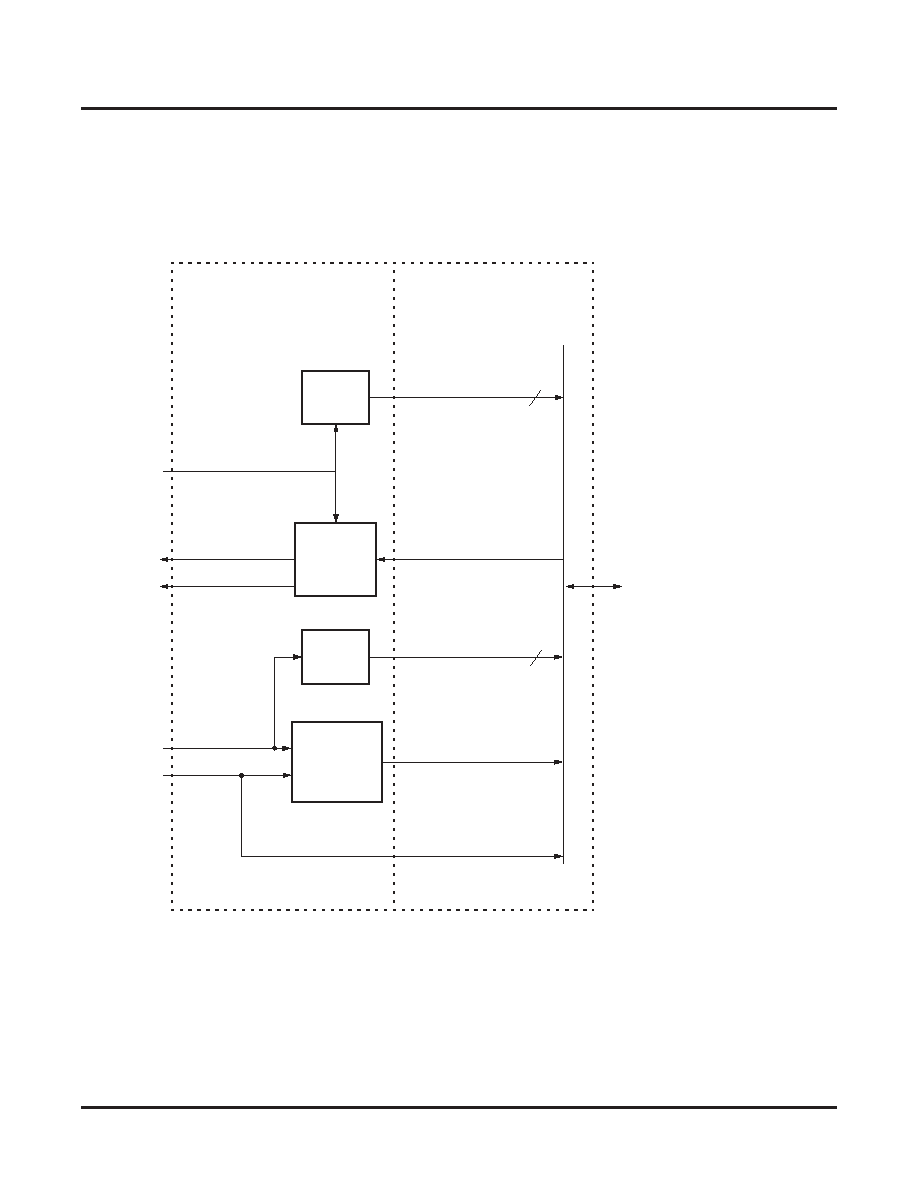
Lattice Semiconductor
ORCA ORLI10G Data Sheet
11
4- to 16-bit deMUX), and each divided clock is passed to the FPGA logic with its associated data bus. All four data
paths act as separate data interfaces that are asynchronous to each other.
The ORLI10G supports transmit and receive data rates up to 850 Mbits/s. Therefore, the total data rate each of the
quad channels is 850 Mbits/s x 4 or 3.4 Gbits/s. Figure 2 shows a representation of the 10G and 2.5G modes in
both transmit and receive directions.
Figure 2. ORCA ORLI10G Block Diagram
EMBEDDED CORE
FPGA LOGIC
(400K GATES)
TRANSMIT
PLLs
REFERENCE CLOCK
TRANSMIT DATA
16 x 622 OR
16 x 645 OR
16 x 667 OR
64:16 MUX
OR
128:16 MUX
TRANSMIT CLOCK
RECEIVE
PLLs
16:64 DEMUX
OR
16:128 DEMUX
RECEIVE DATA
16 x 622 OR
16 x 645 OR
16 x 667 OR
FOUR 2.5 Gbit RXCLKs
64-bit OR 128-bit
RXCLK
64-bit OR 128-bit
TXCLK
(167 MHz--78 MHz)
(167 MHz--78 MHz)
SYSTEM INTERFACE:
-- POS-PHY 4
-- XGMII
-- 156 MHz PECL
(OC-48/STM-16
SONET/SDH)
-- USER DEFINED
16 x 781 Mbits/s
16 x 781 Mbits/s
2
2
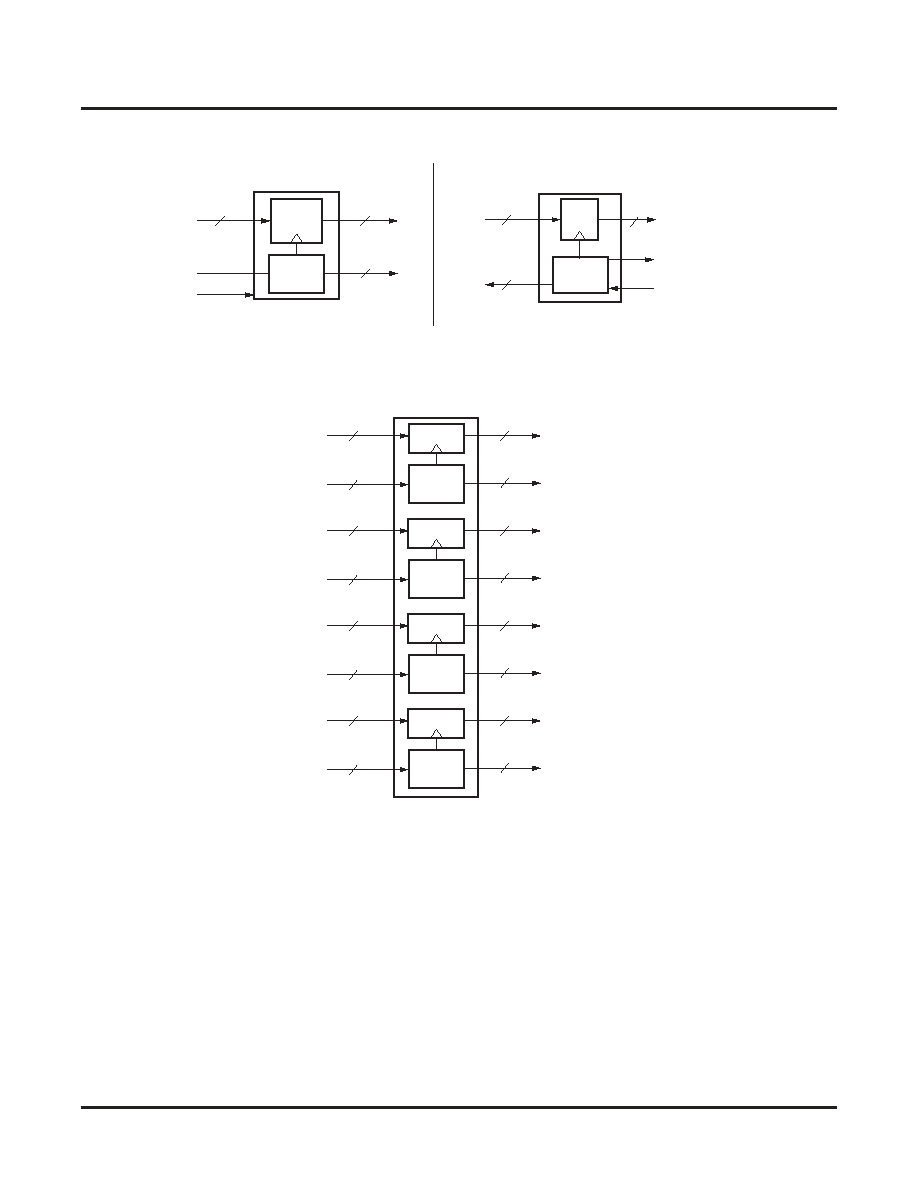
Lattice Semiconductor
ORCA ORLI10G Data Sheet
12
Figure 3. 10G (Single-Channel) and 2.5G (Quad-Channel) Modes
DATA
128 OR 64
2.5G MODE
RECEIVE PATH
LVDS CLOCK
LVDS DATA
CORE
FPGA
RX_CLK8_OUT3
32 OR 16
4
DEMUX
FPGA
CORE
LVDS DATA
16
RX_CLK_IN[0]
RX_CLK_IN[3:1]
RX[1:2]VCOP
4
DATA
10G MODE
DIV BY 8
OR
DIV BY 4
DIV BY 8
MUX
LVDS
16
TX_CLK_IN
CORE
128 OR 64
FPGA
DATA
UNUSED
REFERENCE
DATA
TRANSMIT PATH
DIV BY 8
OR
DIV BY 4
1
1
LVDS CLOCK
LVDS DATA
RX_CLK8_OUT2
32 OR 16
4
DEMUX
DATA
DIV BY 8
OR
DIV BY 4
1
1
LVDS CLOCK
LVDS DATA
RX_CLK8_OUT1
32 OR 16
4
DEMUX
DATA
DIV BY 8
OR
DIV BY 4
1
1
LVDS CLOCK
LVDS DATA
RX_CLK8_OUT0
32 OR 16
4
DEMUX
DATA
DIV BY 8
OR
DIV BY 4
1
1
RECEIVE PATH
DEMUX
CLOCK
DIV BY 4
TX[1:2]VCOP
4
RX[1:2]VCO
TX_CLK_OUT[3:0]
TX[1:2]VCO

Lattice Semiconductor
ORCA ORLI10G Data Sheet
13
Receive Path Details
In the receive path, the ORLI10G embedded core can be broken down into three sections: the high-speed line
interface, the demultiplexer, and the receive-side onboard PLLs. Note that both transmit and receive PLLs are in
addition to the four Programmable PLLs (PPLLs) in the FPGA portion of the ORLI10G.
Line Interface
In the receive path, 16-bit data and associated clocks are inputs to the line interface. Typical data rates are
expected to range from 622 Mbits/s to 850 Mbits/s for most applications. The 16-bit LVDS input data bus is actually
composed of four 4-bit data buses with one clock for each 4-bit data bus. In the 10G mode, all four input clocks are
tied together internal to the device and driven by the lowest-order input clock. In 2.5G mode, the four clocks may be
asynchronous to each other. The ORLI10G uses LVDS (Low-Voltage Differential Signaling) drivers/receivers, which
are intended to provide point-to-point connection between the ORLI10G and optical transceiver (MUX/deMUX)
parts. The LVDS inputs are hot-swap compatible and can connect to other vendor's LVDS I/O buffers. The LVDS
inputs are terminated with a 100
resistor to improve performance.
The receive line interface on the ORLI10G can connect to devices that are compliant to either the XSBI standard or
the SFI-4 standard. The major difference for these standards is that for XSBI (
IEEE
802.3ae version 2.1), the least
significant bit [0] is received first after deserialization by the external deMUX device, whereas SFI-4 receives the
most significant bit first. In some cases, bits [15:0] on the ORLI10G should be connected to bits [0:15] on the
device to which the ORLI10G device interfaces. An example of this is the PCS IP core in the ORLI10G when the
ORLI10G is connected to an XSBI version 2.1 device.
It should be noted that
IEEE
802.3ae version 3.1 to D3.4 (version D3.4 is the latest draft version of this specifica-
tion as of the writing of this data sheet) swaps XSBI so that the most significant bit is received first, thus requiring
that bits [0:15] on the ORLI10G be connected directly to bits [0:15] on the XSBI device.
DeMUX
The demultiplexer takes the high-speed line data and clocks and converts the data and clock to rates appropriate
for transfer to the FPGA logic. The demultiplexer supports two modes of operation:
� Divide-by-8
� 10G (or single channel): The demultiplexer converts the incoming 16 bits of data at 622 Mbits/s to 850
Mbits/s into 128 bits at 78 Mbits/s to 106 Mbits/s. The incoming clocks are divided by 8.
� 2.5G (or quad channel): The demultiplexer converts the incoming four bits of data at 622 Mbits/s to 850
Mbits/s into 32 bits at 78 Mbits/s to 106 Mbits/s. The associated clock is also divided by 8. This is repeated
four times with each 4-bit data/clock group assumed to be asynchronous to the others.
� Divide-by-4
� 10G (or single channel): The demultiplexer converts the incoming 16 bits of data at 622 Mbits/s to
850 Mbits/s into 64 bits at 156 Mbits/s to 212 Mbits/s. The incoming clocks are divided by 4.
� 2.5G (or quad channel): The demultiplexer converts the incoming 4 bits of data at 622 Mbits/s to 850 Mbits/s
into 16 bits at 156 Mbits/s to 212 Mbits/s. The associated clock is also divided by 4. This is repeated four
times with each 4-bit data/clock group assumed to be asynchronous to the others.
Onboard Receive PLLs
The function of the onboard PLLs is to align the system data with the line data, which will be at a slightly higher rate
owing to the addition of the overhead bits. There are two PLLs on the receive path. The input to the first PLL,
RX1_PLL (see Figure 3), is the divided down lowest-order clock from the demultiplexer. The RX1_PLL generates a
clock with a user-defined frequency ratio of M/N to the divided clock. This clock would generally be used to com-
pensate for different data rates due to overhead bits. M and N can independently be set from 1 to 40.
The RX2_PLL also takes its input from the divided down clock and is used to provide a balanced, divided clock
across the FPGA-embedded core interface.

Lattice Semiconductor
ORCA ORLI10G Data Sheet
14
The RX2_PLL has a feedback path that compensates for routing delays to the embedded core/FPGA logic inter-
face for minimum clock skew.
In addition, the user can specify an additional skew on each clock in increments of 1/8 the clock period.
The selection of the deMUX width (and corresponding clock division value), the RX1_PLL M and N values, and the
additional skew for RX1_PLL and RX2_PLL are specified by the user in a GUI interface provided in the ORLI10G
design kit.
A detailed block diagram of the receive path in shown in Figure 4.
Figure 4. ORLI10G Embedded Core Receive Path Diagram
128 TO 16 MUX
OR
64 TO 16 MUX
DATA
RX_DAT_IN
16
CLOCK
RX_CLK_IN
4
FPGA LOGIC
DIVIDE BY 8 MODE
RX_DAT_OUT[127:96]
RX_DAT_OUT[95:64]
RX_DAT_OUT[63:32]
RX_DAT_OUT[31:0]
OR
RX_ENB_OUT[3:0]
DIVIDE BY 4 MODE
RX_DAT_OUT[111:96]
RX_DAT_OUT[79:64]
RX_DAT_OUT[47:32]
RX_DAT_OUT[15:0]
RX_CLK8_OUT[0]
RX_CLK8_OUT[1]
RX_CLK8_OUT[2]
RX_CLK8_OUT[3]
DIV BY 8
OR
DIV BY 4
ORLI10G CORE
RX1_PLL
(M/N)
RX2_PLL
(X1)
RX1_VCOP (X M/N CLOCK)
RX_LOCK
RX2_VCOP (X 1 CLOCK)
DIV BY 8
OR
DIV BY 4
DIV BY 8
OR
DIV BY 4
DIV BY 8
OR
DIV BY 4
RX_ENB_OUT[3:0]
RX1_VCO
RX2_VCO
BOTH MODES
RX2_FBCKI
10G OR
2.5G

Lattice Semiconductor
ORCA ORLI10G Data Sheet
15
Transmit Path Details
In the transmit path, the ORLI10G embedded core can be broken down into three sections: the multiplexer, the
transmit side onboard PLLs, and the high-speed line interface. Note that both transmit and receive PLLs are in
addition to the four Programmable PLLs (PPLLs) in the FPGA portion of the ORLI10G.
MUX
The multiplexer takes data from the FPGA logic and multiplexes the data to rates for transfer by the highspeed line
interface. The multiplexer supports two modes of operation:
� Multiplex-by-8
� The multiplexer converts the incoming 128 bits of data at 78 Mbits/s to 106 Mbits/s into 16 bits at 622 Mbits/s
to 850 Mbits/s. The incoming transmit reference clock is divided by 8 for connection to the internal FPGA
logic.
� Multiplex-by-4
� The multiplexer converts the incoming 64 bits of data at 156 Mbits/s to 212 Mbits/s into 16 bits at 622 Mbits
to 850 Mbits/s. The transmit reference clock is divided by 4 for connection to the internal FPGA logic.
Onboard Transmit PLLs
The function of the onboard PLLs is to align the system data with the line data, which will be at a slightly higher rate
owing to the addition of the overhead bits. There are two PLLs on the transmit path. The input to the first PLL,
TX1_PLL (see Figure 4), is the divided down transmit reference clock from the multiplexer. The TX1_PLL generates
a clock with a user-defined frequency ratio of M/N to the divided clock. This clock would generally be used to com-
pensate for different data rates due to overhead bits. M and N can be independently set from 1 to 40.
The TX2_PLL also takes its input reference from the divided down reference clock and is used to provide a bal-
anced divided clock across the FPGA-embedded core interface.
The TX2_PLL has a feedback path that compensates for routing delays to the embedded core/FPGA logic interface
for minimum clock skew.
In addition, the user can specify an additional skew on each clock in increments of 1/8 the clock period.
The selection of the MUX width (and corresponding clock division value), the TX1_PLL M and N values, and the
additional skew for TX1_PLL and TX2_PLL are specified by the user in a GUI interface provided in the ORLI10G
design kit.
A detailed block diagram of the transmit path in shown in Figure 4. Either TX1_VCOP, TX1_VCO, TX2_VCOP, or
TX2_VCO must be used to clock TX_DAT_IN[127:0] that is transmitted to the embedded block since this interface
must be frequency locked to the divided version of the referance clock. These PLLs can also be bypassed, where
the divided transmit reference clock is sent directly to the FPGA. TX_CLK8_IN[3:0] can be used to clock data trans-
mitted to the embedded block, but the preferred method is to use the internally generated clocks as described
above. If TX_CLK8_IN[3:0] are used, they must also be frequency locked to the reference clock and are thus also
required to be driven by TX1_VCOP, TX1_VCO, TX2_VCOP, or TX2_VCO.
Line Interface
In the transmit path, 16-bit data and associated clocks are outputs from the line interface. Typical data rates are
expected to range from 622 Mbits/s to 850 Mbits/s for most applications. The 16-bit LVDS output data bus is actu-
ally composed of four 4-bit data buses with one clock for each 4-bit data bus. On the transmit side, these clocks will
all be synchronized. The ORLI10G uses LVDS (Low-Voltage Differential Signaling) drivers/receivers, which are
intended to provide point-to-point connection between the ORLI10G and optical transceiver (MUX/deMUX) parts.
The LVDS drivers are hot-swap compatible and can connect to other vendor's LVDS I/O buffers. The LVDS drivers
are terminated with a 100
resistor to improve performance.
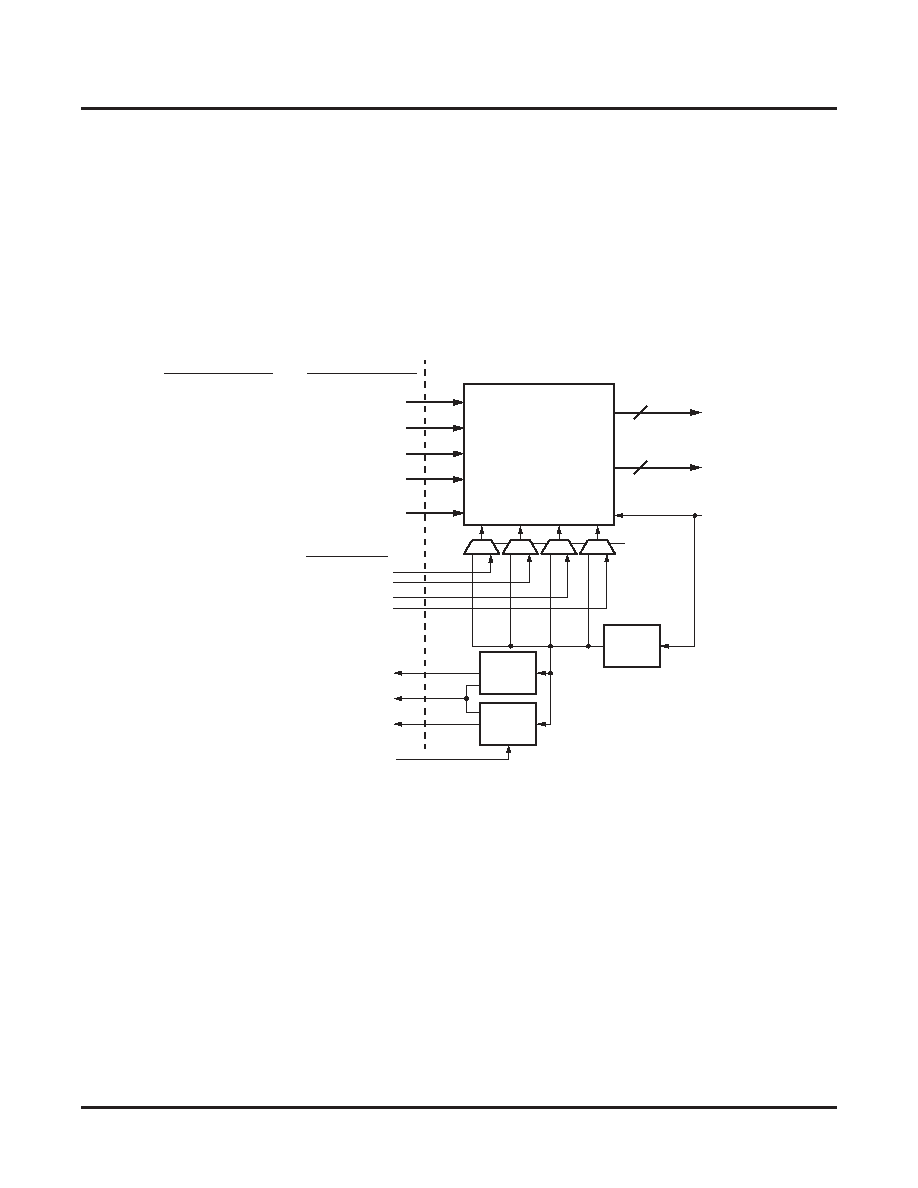
Lattice Semiconductor
ORCA ORLI10G Data Sheet
16
The transmit line interface on the ORLI10G can connect to devices that are compliant to either the XSBI standard
or the SFI-4 standard. The major difference for these standards is that for XSBI, the least significant bit [0] is trans-
ferred first after serialization by the external MUX device, whereas SFI-4 transmits the most significant bit first. In
some cases, bits [15:0] on the ORLI10G should connect to bits [0:15] on the device to which the ORLI10G device
interfaces. An example of this is the PCS IP core in the ORLI10G when the ORLI10G is connected to an XSBI ver-
sion 2.1 device.
It should be noted that
IEEE
802.3ae version 3.1 to D3.4 (version D3.4 is the latest draft version of this specifica-
tion as of the writing of this data sheet) swaps XSBI so that the most significant bit is transferred first, thus requiring
that bits [0:15] on the ORLI10G be connected directly to bits [0:15] on the XSBI device.
Figure 5. ORLI10G Embedded Core Transmit Path Diagram
Note: TX_ENB8_IN[3:0] and TX_CLK8_IN[3:0] are generally not used. See text for explanation.
128 TO 16 MUX
OR
64 TO 16 MUX
DATA
TX_DAT_OUT
16
CLOCK
TX_CLK8_OUT
4
TRANSMIT REFERENCE
CLOCK
FPGA LOGIC
DIVIDE BY 8 MODE
TX_DAT_IN[127:96]
TX_DAT_IN[95:64]
TX_DAT_IN[63:32]
TX_DAT_IN[31:0]
OR
TX_ENB8_IN[3:0]
DIVIDE BY 4 MODE
TX_DAT_IN[111:96]
TX_DAT_IN[79:64]
TX_DAT_IN[47:32]
TX_DAT_IN[15:0]
INTCLK
TX_CLK8_IN[0]
TX_CLK8_IN[1]
TX_CLK8_IN[2]
TX_CLK8_IN[3]
DIV BY 8
OR
DIV BY 4
TX_CLK_IN
ORLI10G CORE
TX1_PLL
(M/N)
TX2_PLL
(X1)
TX1_VCOP (X M/N CLOCK)
TX_LOCK
TX2_VCOP (X 1 CLOCK)
TX_ENB8_IN[3:0]
TX1_VCO
TX2_VCO
BOTH MODES
TX2_FBCKI
EXTCLK

Lattice Semiconductor
ORCA ORLI10G Data Sheet
17
ORLI10G Demultiplexer (Rx) Detail
The demultiplexer module converts the incoming 16 bits of data at 622 MHz/850 MHz into 128 bits of data at 78
MHz/106 MHz or 64 bits of data at 156 MHz/212 MHz and sends it to the FPGA logic. It has been implemented in
two stages; the first stage converts each incoming bit into a byte stream and the second stage bit interleaves these
bytes into 128/64 bits, depending upon the mode of operation. The low-speed clocks are generated by this block.
These clocks are then driven back to this block from the low-speed clock tree network. Functionally, the demulti-
plexer architecture consists of three blocks: the serial to parallel conversion, the counters, and the interleaving.
The first stage of the line interface module (demultiplexer) converts each incoming bit of data into a byte stream on
a divided-by-8 clock. The data is first registered on the rising edge of the clock input. The clock dividers also runs
parallel to data shift (serial to parallel) on the rising edge of the input clock. An enable is created when a complete
byte is taken in. This enable signal is used to register the serial-to-parallel converted data at the high-speed input
clock. This ensures that the data can be safely transferred to the low-speed clock. This data is then transferred to
the divided clock, allowing a timing margin of approximately half the divided clock period.
The high-speed demultiplexer converts the incoming data as blocks of bytes. The byte boundaries of incoming data
are unknown and are irrelevant to this module.
This data is then interleaved to the 128/64 bits of output data, depending on the mode of operation (divide-by-
4/divide-by-8). In 10G mode, the output data is assigned the retimed 128/64 bits of data from the first stage of line
interface registered at the input clock [0]. In 2.5G mode, the output data is assigned four concatenated 32/16 bits of
data from the first stage of line interface registered at input clocks [0 to 3]. The interleaving is done at bit level
because the serial-to-parallel converter operates on bits of incoming data. In 10G mode, it is assumed that all the
incoming 16 bits of data are synchronized to the input clock [0]. This block also generates the clock enables used
by the output line interface (multiplexer) module for registering the data on the high-speed clock. These enables
along with the enables from other clocks are selected through the high-speed clock MUX for the output line inter-
face block.
Figure 6 shows the valid data output bits from the demultiplexer in each of the four modes (divide-by-8, 10G and
2.5G modes, and divide-by-4, 10G and 2.5G modes). Figure 7--Figure 10 show the demultiplexer input data and
clock waveforms and output clock, enable, and data waveforms for all four modes.

Lattice Semiconductor
ORCA ORLI10G Data Sheet
18
Figure 6. Demultiplexer Output Data Structure
4 x 4 TO 32 DEMUX
OR
4 x 4 TO 16 DEMUX
RX_DAT_OUT
16 OR 32
RX_DAT_OUT
16 OR 32
RX_DAT_OUT
16 OR 32
RX_DAT_OUT
16 OR 32
RX_DAT_IN
16
RX_CLK_IN
4
128
112
96
80
64
48
32
16
0
10G 2.5G
�
8 MODE
�
4 MODE
2.5G
10G
UNDEFINED
SINGLE CHANNEL
CHANNEL 3
CHANNEL 2
CHANNEL 1
CHANNEL 0

Lattice Semiconductor
ORCA ORLI10G Data Sheet
19
Figure 7. Demultiplexer Serial-to-Parallel Conversion Divide by 8, 10G Mode
(RX_ENB8_OUT[1:3] = 0)
0 0 4 8 C 1 9 0 8
0
0 1 5 9 D 3 B 2 A 0
0 2 6 A E 5 D 4 C 0
0 3 7 B F 7 F 6 E 0
00000000
01234567
0
00000000
89ABCDEF
0
00000000
13579BDF
0
00000000
02468ACE
0
RX_CLK_IN0
RX_CLK8_OUT0
(RX_CLK8_OUT[1:3] = 0)
RX_DAT_IN
[15:12]
RX_ENB8_OUT0
RX_DAT_IN
[11:8]
RX_DAT_IN
[7:4]
RX_DAT_IN
[3:0]
RX_DAT_OUT
[127:96]
RX_DAT_OUT
[95:64]
RX_DAT_OUT
[63:32]
RX_DAT_OUT
[31:0]

Lattice Semiconductor
ORCA ORLI10G Data Sheet
20
Figure 8. Demultiplexer Serial-to-Parallel Conversion Divide by 4, 10G Mode
0
0
4
8
C
1
9
0
8
0
00000000
01234567
0
(RX_ENB8_OUT[1:3] = 0)
RX_CLK_IN0
RX_CLK8_OUT0
(RX_CLK8_OUT[1:3] = 0)
RX_DAT_IN
[15:12]
RX_ENB8_OUT0
RX_DAT_IN
[11:8]
RX_DAT_IN
[7:4]
RX_DAT_IN
[3:0]
RX_DAT_OUT
[63:32]
RX_DAT_OUT
[31:0]
0
1
5
9
D
3
B
2
A
0
0
2
6
A
E
5
D
4
C
0
0
3
7
B
F
7
F
6
E
0
13579BDF
00000000
89ABCDEF
0
02468ACE

Lattice Semiconductor
ORCA ORLI10G Data Sheet
21
Figure 9. Demultiplexer Serial-to-Parallel Conversion Divide by 8, 2.5G Mode
0 0 1 2 3 4 5 6 7
0
0 8 9 A B C D E F 0
0 1 3 5 7 9 B D F 0
0 0 2 4 6 8 A C E 0
00000000
01234567
0
00000000
89ABCDEF
0
00000000
13579BDF
0
00000000
02468ACE
0
RX_CLK_IN[0:3]
RX_CLK8_OUT[0:3]
RX_DAT_IN
[15:12]
RX_ENB8_OUT[3:0]
RX_DAT_IN
[11:8]
RX_DAT_IN
[7:4]
RX_DAT_IN
[3:0]
RX_DAT_OUT
[127:96]
RX_DAT_OUT
[95:64]
RX_DAT_OUT
[63:32]
RX_DAT_OUT
[31:0]

Lattice Semiconductor
ORCA ORLI10G Data Sheet
22
Figure 10. Demultiplexer Serial-to-Parallel Conversion Divide by 4, 2.5G Mode
0
0
1
2
3
4
5
6
7
0
0000
0123
0
RX_CLK_IN[3:0]
RX_CLK8_OUT[3:0]
RX_DAT_IN
[15:12]
RX_ENB8_OUT[3:0]
RX_DAT_IN
[11:8]
RX_DAT_IN
[7:4]
RX_DAT_IN
[3:0]
RX_DAT_OUT
[111:96]
RX_DAT_OUT
[79:64]
0
8
9
A
B
C
D
E
F
0
0
1
3
5
7
9
B
D
F
0
0
0
2
4
6
8
A
C
E
0
4567
0000
89AB
0
CDEF
0000
1357
0
9BDF
0000
0246
0
8ACE
RX_DAT_OUT
[47:32]
RX_DAT_OUT
[15:0]

Lattice Semiconductor
ORCA ORLI10G Data Sheet
23
ORLI10G Multiplexer (Tx) Detail
The multiplexer module converts the incoming 128 bits of data from the FPGA logic at 78 MHz/106 MHz or
64 bits of data from the FPGA logic at 156 MHz/212 MHz into 16 bits of data at 622 MHz/850 MHz. It has been
implemented as two stages. The first stage deinterleaves each incoming byte into a different byte stream that can
be serially output on the output data pins. The second stage outputs these bytes into 16 bits or four groups of 4 bits,
depending upon the mode of operation. Functionally, the multiplexer architecture consists of three blocks: the par-
allel-to-serial conversion, the counters, and the deinterleaving.
Two options are available for the transmit clocks. The clock signals TX_CLK_IN[3:0] can be used to transfer data to
the internal core or an internal clock can be used. The preferred method is to use the internal clock. Two options
are also available for the enable signals. The enable signals TX_ENB8_IN[3:0] can be used or they can be gener-
ated internally. The preferred method is to use the internal enables.
For divide-by-8 mode, the first stage of the line interface module deinterleaves each incoming byte of data into a
different byte stream on the 78 MHz/106 MHz (TX_CLK8_IN[3:0] or internal) clock. This data is then registered on
the rising edge of the 622 MHz/850 MHz (TX_CLK_IN) clock at the falling edge of the 78 MHz/106 MHz clock. The
enable inputs (TX_ENB8_IN[3:0] or internal) are used to transfer data from the low-speed clock to the high-speed
clock, as well as synchronizing the counters of parallel-to-serial conversion which are running at the high-speed
clock. Generally, these enables are generated in the embedded core and the TX_ENB8_IN[3:0] signals to the
embedded core are not used.
For divide-by-4 mode, the first stage of the line interface module deinterleaves each incoming byte of data into a
different byte stream on the 156 MHz/212 MHz (TX_CLK8_IN[3:0] or internal) clock. This data is then registered on
the rising edge of the 622 MHz/850 MHz (TX_CLK_IN) clock at the falling edge of the 156 MHz/212 MHz clock.
The enable inputs (TX_ENB8_IN[3:0] or internal) are used to transfer data from the low-speed clock to the high-
speed clock, as well as synchronizing the counters of parallel-to-serial conversion which are running at the high-
speed clock. Again, both TX_CLK8_IN[3:0] and TX_ENB8_IN[3:0] are not generally used.
The enable inputs (TX_ENB8_IN[3:0]) are required to be four (divide by 4) or eight (divide by 8) TX_CLK_IN clock
cycles wide. If they are used, they have to be synchronous to their corresponding TX_CLK8_IN[3:0] clock. Each of
these four TX_CLK8_IN[3:0] clocks must also be frequency locked to the TX_CLK_IN signal.
The TX_CLK_OUT[3:0] clock outputs from the ORLI10G are provided for transferring each 4 bits of data per clock.
All data to be transmitted to the embedded core must be frequency locked to the TX_CLK_IN signal. Thus, the
divided version of this clock found at the embedded core interface should always be used to transfer data from the
FPGA logic to the embedded core. These clock signals are available from the TX PLL outputs (TX1_VCO,
TX1_VCOP, TX2_VCO, TX2_VCOP). Figure 11 shows the valid data input bits to the multiplexer in each of the four
modes (divide-by-8 and divide-by-4 modes). Figure 12-- Figure 15 show the multiplexer input transmit reference
clock, data, enable, and clock waveforms and output clock and data waveforms for all four modes.

Lattice Semiconductor
ORCA ORLI10G Data Sheet
24
Figure 11. Multiplexer Input Data Structure
4 x 4 TO 32 MUX
OR
4 x 4 TO 16 MUX
TX_DAT_IN
16 OR 32
TX_DAT_IN
16 OR 32
TX_DAT_IN
16 OR 32
TX_DAT_IN
16 OR 32
TX_DAT_OUT
16
TX_CLK_OUT
4
TRANSMIT
REFERENCE
CLOCK
TX_CLK_IN
128
112
96
80
64
48
32
16
0
�
8 MODE
�
4 MODE
UNDEFINED
SINGLE CHANNEL
CHANNEL 3
CHANNEL 2
CHANNEL 1
CHANNEL 0

Lattice Semiconductor
ORCA ORLI10G Data Sheet
25
Figure 12. Multiplexer Parallel-to-Serial Conversion Divide by 8, 10G Mode
Note: TX_ENB8_IN0 is generally not used because the enable is created internal to the embedded core, but is shown for reference
00000000
TX_CLK_IN
TX_CLK8_OUT[3:0]
TX_DAT_OUT
[15:12]
TX_DAT_OUT
[11:8]
TX_DAT_OUT
[7:4]
TX_DAT_OUT
[3:0]
TX_DAT_IN
[127:96]
TX_DAT_IN
[95:64]
TX_DAT_IN
[63:32]
TX_DAT_IN
[31:0]
TX_ENB8_IN0
01234567
0
00000000
89ABCDEF
0
00000000
13579BDF
0
00000000
02468ACE
0
0 4 8 C 1 9 0 8 0
0
1 5 9 D 3 B 2 A 0
0
2 6 A E 5 D 4 C 0
0
3 7 B F 7 F 6 E 0
0

Lattice Semiconductor
ORCA ORLI10G Data Sheet
26
Figure 13. Multiplexer Parallel-to-Serial Conversion Divide by 4, 10G Mode
Note: TX_ENB8_IN0 is generally not used because the enable is created internal to the embedded core, but is shown for reference
TX_CLK_IN
TX_CLK_OUT[3:0]
TX_DAT_IN
[63:32]
TX_DAT_IN
[31:0]
TX_ENB8_IN0
13579BDF
0 4 8 C 1 9 0 8 0
0
1 5 9 D 3 B 2 A 0
0
2 6 A E 5 D 4 C 0
0
3 7 B F 7 F 6 E 0
0
00000000
01234567
0
02468ACE
00000000
89ABCDEF
0
TX_DAT_OUT
[15:12]
TX_DAT_OUT
[11:8]
TX_DAT_OUT
[3:0]
TX_DAT_OUT
[7:4]

Lattice Semiconductor
ORCA ORLI10G Data Sheet
27
Figure 14. Multiplexer Parallel-to-Serial Conversion Divide by 8, 2.5G Mode
Note: TX_CLK8_IN[3:0] and TX_ENB8_IN[3:0] are generally not used because the clocks and enables are created internal to the embedded
core, but are shown for reference
00000000
TX_CLK_IN
TX_CLK8_OUT[3:0]
TX_DAT_OUT
[15:12]
TX_DAT_OUT
[11:8]
TX_DAT_OUT
[7:4]
TX_DAT_OUT
[3:0]
TX_DAT_IN
[127:96]
TX_DAT_IN
[95:64]
TX_DAT_IN
[63:32]
TX_DAT_IN
[31:0]
TX_CLK8_IN[3:0]
TX_ENB8_IN[3:0]
01234567
0
00000000
89ABCDEF
0
00000000
13579BDF
0
00000000
02468ACE
0
0 1 2 3 4 5 6 7
0
0
8 9 A B C D E F
0
0
1 3 5 7 9 B D F
0
0
0 2 4 6 8 A C E
0
0

Lattice Semiconductor
ORCA ORLI10G Data Sheet
28
Figure 15. Multiplexer Parallel-to-Serial Conversion Divide by 4, 2.5G Mode
Note: TX_CLK8_IN[3:0] and TX_ENB8_IN[3:0] are generally not used because the clocks and enables are created internal to the embedded
core, but are shown for reference
TX_CLK_IN
TX_CLK_OUT[3:0]
TX_DAT_IN
[111:96]
TX_DAT_IN
[79:64]
TX_CLK8_IN[3:0]
TX_ENB8_IN[3:0]
4567
0 1 2 3 4 5 6 7 0
0
8 9 A B C D E F 0
0
1 3 5 7 9 B D F 0
0
0 2 4 6 8 A C E 0
0
0000
0123
0
TX_DAT_IN
[47:32]
TX_DAT_IN
[15:0]
TX_DAT_OUT
[31:0]
TX_DAT_OUT
[63:32]
CDEF
0000
89AB
0
9BDF
0000
1357
0
8ACE
0000
0246
0
TX_DAT_OUT
[63:32]
TX_DAT_OUT
[31:0]
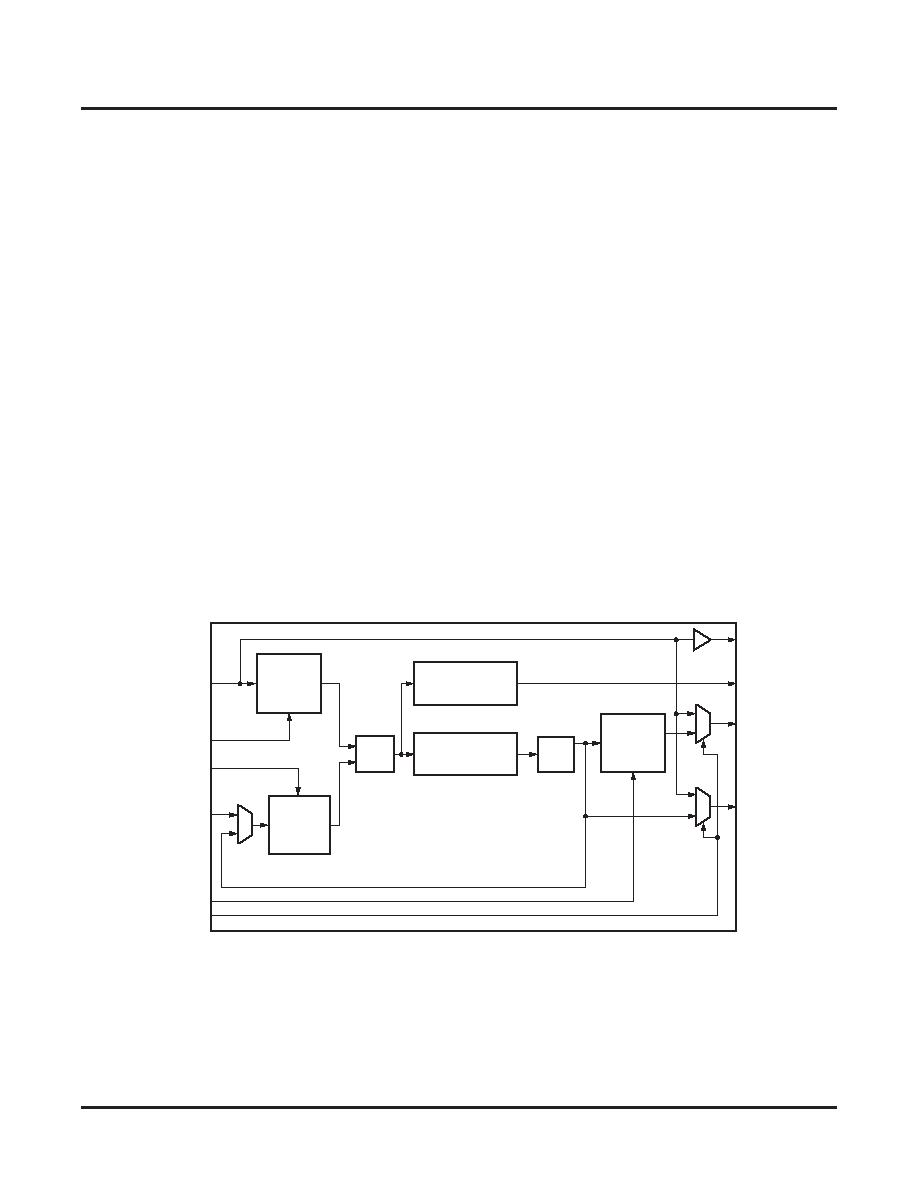
Lattice Semiconductor
ORCA ORLI10G Data Sheet
29
ORLI10G Embedded PLLs
The ORLI10G embedded (transmit and receive) PLLs are based on the 4E series FPGA High-Speed Programma-
ble PLL (HPPLL). The 4E PLL consists of a Phase/Frequency Detector (PFD), a charge pump/filter, a multitap Volt-
age Controlled Oscillator (VCO), a duty cycle synthesis circuitry, a power regulator, two programmable dividers,
phase shift selector multiplexers, a lock signal generator, and a current DAC. A block diagram of the programmable
PLL is shown in Figure 16. The receive path RX1_PLL and transmit path TX1_PLL, which can be programmed to
create a N/M frequency clock, are based on this design.
The receive path RX2_PLL and transmit path TX2_PLL create a X1 clock. This is essentially the same PLL without
the M and N divider.
The RCKI input to the PLLs comes from an input clock to the ORLI10G that has been divided in frequency by either
4 or 8 (programmable). As shown in Figure 4, RX1_PLL and RX2_PLL are driven by the divided version of
RX_CLK_IN0. As shown in Figure 5, TX1_PLL and TX2_PLL are driven by the divided versions of TX_CLK_IN. It
should be noted that the speed of the ORLI10G line interface is therefore either 4x or 8x the operating speed of the
embedded PLLs.
The clock feedback loops for the RX2_PLL and TX2_PLL should be routed from the clock network in the FPGA
core to compensate for the routing delays to the FPGA logic interface. The source to the TX2_FBCKI or
RX2_FBCKI inputs must come from an FPGA clock network driven by the VCO output (otherwise, any phase shift-
ing on VCOP is removed by the feedback loops). In this way, the clock skew at the embedded core/FPGA logic
boundary is zero for the receive and transmit PLLs.
All PLLs include a phase shift selector which allows phase shift adjustments of each clock in increments of 1/8 the
period of the clock. This phase shifted output is available on the VCOP output of the PLL. All functions of the
embedded core PLLs are user controlled through a GUI provided with the ORLI10G design kit software.
Figure 16. ORLI10G Programmable PLL Block Diagram
RCKI
M<5:0>
N<5:0>
SEL<2:0>
BYPASS
M
DIVIDER
N
DIVIDER
PFD
LOCK
GENERATOR
CHARGE PUMP
AND FILTER
VCO
PHASE
SELECT
RCKO
LOCK
VCOP
VCO
TX2_FBCKI
RX2_FBCKI

Lattice Semiconductor
ORCA ORLI10G Data Sheet
30
ORLI10G Embedded Programmable PLLs Specifications
Table 2. Programmable PLL Specifications
Notes:
Multiplication and division values can both be used on one PLL output (example 3/4x).
For more information about the HPPLL, see the Series 4 PLL Application Note.
ORLI10G Reset Requirements
Both the embedded core portion and the FPGA portion are reset at powerup. The embedded core is also reset, as
shown in Table 3, based on other conditions. All resets to the core can either be asynchronous or asynchronous on
with a synchronous release. Asynchronous resets must be held in reset for at least 8 ns. Two signals from the
FPGA logic can also reset the embedded core: the global set/reset (GSRN) which can be inhibited, and a signal
routed from the FPGA general routing (FPGA_RESET). Both of these affect both the TX and RX reset simulta-
neously. Table 3 also shows the conditions upon which the I/O are 3-stated.
Reset of PLL blocks directly affects only the digital logic. For the PLL_RX2 and PLL_TX2 (x1) PLLs, the VCO out-
puts from the PLL should be in the 3-6Mhz range during reset. For PLL_RX1 and PLL_TX1 (xM/N) PLLs using the
M and N counters, the VCO will go to the low state. Coming out of reset will require about 25 microseconds for the
PLLs to become stable.
Table 3. ORLI10G Reset Requirements
Parameters
Min
Nom
Max
Unit
V
DD
15
1.425
1.5
1.575
V
V
DD
33
3.0
3.3
3.6
V
Operating Temperature (T
A
)
�40
--
125
�C
Input Clock Frequency
60
--
420
MHz
Input Duty Cycle
30
--
70
%
Output Clock Frequency
7.5
--
420
MHz
Output Duty Cycle
45
50
55
%
Lock Time
--
<50
--
�s
Frequency Multiplication (TX1_PLL and RX1_PLL)
2x, 3x, 4x, 5x, 6x, 7x, 8x
--
Frequency Division (TX1_PLL and RX1_PLL)
1/8x, 1/7x, 1/6x, 1/5x, 1/4x, 1/3x, 1/2x
--
Duty Cycle Adjust of Output Clock(s)
12.5, 25, 37.5, 50, 62.5, 75, 87.5
%
Delay Adjust of Output Clock
0, 45, 90, 135, 180, 225, 270, 315
degrees
Phase Shift Between VCO and VCOP
0, 45, 90, 135, 180, 225, 270, 315
degrees
Condition
TX MUX Block
TX PLL
RX DeMUX Block
RX PLL
Embedded I/O
Powerup
Reset
Reset
Reset
Reset
3-state
FPGA Configuration
Reset
Reset
Reset
Reset
Active
FPGA GSRN
Reset
Reset
Reset
Reset
Active
FPGA_RESET Signal
Reset
Reset
Reset
Reset
Active
TS_ALL Pin = 1
--
--
--
--
3-state
RESET_TX Pin = 1
Reset
Reset
--
--
Active
RESET_RX Pin = 1
--
--
Reset
Reset
Active
PWRON Pin = 1
--
Powerdown
--
Powerdown
Active

Lattice Semiconductor
ORCA ORLI10G Data Sheet
31
Typically, the following reset sequence should be followed for the ORLI10G:
� Place the device in reset by driving RESET_TX = 1 and RESET_RX = 1 (or FPGA_RESET signal = 1), and by
placing the FPGA portion into reset.
� Release the embedded core from reset by driving RESET_TX = 0 and RESET_RX = 0 and FPGA_RESET
signal = 0).
� Release the FPGA portion from reset.
Line Interface Circuit Specifications
Power Supply Decoupling LC Circuit
The 622 MHz--850 MHz line interface macro contains both analog and digital circuitry. The line interface function,
for example, is implemented as primarily a digital function, but it relies on a conventional analog phase-locked loop
to provide its divided clocks. The internal analog phase-locked loop contains a voltage-controlled oscillator. This cir-
cuit will be sensitive to digital noise generated from the rapid switching transients associated with internal logic
gates and parasitic inductive elements. Generated noise that contains frequency components beyond the band-
width of the internal phase-locked loop (about 3 MHz) will not be attenuated by the phase-locked loop and will
impact bit error rate directly. Thus, separate power supply pins are provided for these critical analog circuit ele-
ments.
Additional power supply filtering in the form of an LC
filter section will be used between the power supply source
and these device pins as shown in Figure 17. The corner frequency of the LC filter is chosen based on the power
supply switching frequency, which is between 100 kHz and 300 kHz in most applications.
Capacitor C1 is a large electrolytic capacitor to provide the basic cut-off frequency of the LC filter. For example, the
cutoff frequency of the combination of these elements might fall between 5 kHz and 50 kHz. Capacitors C2 and C3
are smaller ceramic capacitors designed to provide a low-impedance path for a wide range of high-frequency sig-
nals at the analog power supply pins of the device. The physical location of capacitor C3 must be as close to the
device lead as possible. Multiple instances of capacitors C3 can be used if necessary. The recommended filter for
the HSI macro is shown below: L= 4.7 �H, RL = 1
, C1 = 4.7 �F, C2 = 0.01 �F, C3 = 0.01 �F.
Figure 17. Sample Power Supply Filter Network for Analog LI Power Supply Pins
C2
+
C3
+
TO DEVICE
V
DDA
_[7:4]
V
SSA
_[7:4]
C1
+
FROM POWER
SUPPLY SOURCE
L

Lattice Semiconductor
ORCA ORLI10G Data Sheet
32
XGMII ORCA 4E Receive Analysis
XGMII Considerations
The stringent 10 Gbit Media Independent Interface (XGMII) specifications from the IEEE 802.3ae standards are
met in the FPGA side of the ORLI10G device. This interface is implemented in the PCS IP core and targeted to the
ORLI10G FPSC. Figure 18 shows a simplified block diagram for the XGMII interface. Other I/O standards are also
possible, such as SSTL or HSTL, with a reference voltage of 1.8 V. Further details are available in the Series 4 I/O
application note and the Series 4 Fast Input DDR and Output DDR with Clock Forwarding Application Note.
The ORLI10G device meets the 480 ps input setup time and 480 ps input hold time requirements for the XGMII
receiver inputs into the FPGA side of the FPSC with the embedded I/O DDR cells on the FPGA side of the FPSC.
The PLLs are not used on input because this is a forward clocked interface. The ORLI10G meets the clock-to-out
specification on the XGMII DDR outputs by using the output shift register to produce a non-duty-cycle-dependent
output. An embedded output DDR capability is also available. The output clock is then centered around this data
eye using internal PLLs.
There are two considerations to note about the pinout location of the XGMII input clocks:
1. The XGMII input clocks must be located at the C pad of the programmable I/O cells (PICs). In the pinout tables,
the pads are labeled on a pin-by-pin basis. For example, a pin whose pad is referenced as PL1C can be used
as an XGMII input clock, but pins referenced as PL1A, PL1B, or PL1D cannot be used as an XGMII input clock.
2. The XGMII input data pins can be no further then six PICs away from the XGMII input clock pin.
Figure 18. Simplified XGMII Block Diagram
HSTL
CLOCK
CLOCK
V
DDIO
V
DD15
V
DDIO
= 1.5 V NOM
HSTL
V
DDIO
= 1.5 V NOM
V
REF
V
DDIO
�
2
DDR DATA
DDR DATA
CUSTOMER DEVICE
ORLI10G
SYSTEM INTERFACE
LINE INTERFACE

Lattice Semiconductor
ORCA ORLI10G Data Sheet
33
Absolute Maximum Ratings
Stresses in excess of the absolute maximum ratings can cause permanent damage to the device. These are abso-
lute stress ratings only. Functional operation of the device is not implied at these or any other conditions in excess
of those given in the operations sections of this data sheet. Exposure to absolute maximum ratings for extended
periods can adversely affect device reliability.
The ORCA Series 4 FPSCs include circuitry designed to protect the chips from damaging substrate injection cur-
rents and to prevent accumulations of static charge. Nevertheless, conventional precautions should be observed
during storage, handling, and use to avoid exposure to excessive electrical stress.
Table 4. Absolute Maximum Ratings
Recommended Operating Conditions
Table 5. Recommended Operating Conditions
For FPGA Recommended Operating Conditions and Electrical Characteristics, see the Recommended Operating
Conditions and Electrical Characteristics tables in the ORCA Series 4 FPGA data sheet (OR4E04) and the ORCA
Series 4 I/O Buffer Technical Note. FPSC Standby Currents (I
DD
SB15 and I
DD
SB33) are tested with the Embedded
Core in the powered down state.
Notes:
The maximum recommended junction temperature (TJ) during operation is 125 �C.
Timing parameters in this data sheet are characterized under tighter voltage and temperature conditions than the recommended operating con-
ditions in this table.
The internal PLLs operate from the V
DD
33 and V
DD
33_A power supplies. These power supplies should be well isolated from all other power sup-
plies on the board for proper operation.
Parameter
Symbol
Min
Max
Unit
Storage Temperature
T
STG
�65
150
�C
Power Supply Voltage with Respect to Ground
V
DD
33
�0.3
4.2
V
V
DD
IO
�0.3
4.2
V
V
DD
33, V
DD
33_A
�0.3
4.2
V
V
DD
15
�0.3
2.0
V
Input Signal with Respect to Ground
V
IN
�0.3
V
DD
IO + 0.3
V
Signal Applied to High-impedance Output
--
�0.3
V
DD
IO + 0.3
V
Maximum Package Body (Soldering) Temperature
--
--
220
�C
Parameter
Symbol
Min
Max
Unit
Power Supply Voltage with Respect to Ground
V
DD
33
3.0
3.6
V
V
DD
IO
1.4
3.6
V
V
DD
33, V
DD
33_A
3.0
3.6
V
V
DD
15
1.425
1.575
V
Input Voltages
V
IN
�0.3
V
DD
IO + 0.3
V
Junction Temperature
T
J
�40
125
�C

Lattice Semiconductor
ORCA ORLI10G Data Sheet
34
Embedded Core LVDS I/O
Table 6. Driver dc Data*
* Characterized at V
DD
33 = 3.1 V--3.5 V, V
DD
15 = 1.425 V--1.575 V, T
J
= �40 �C - 125 �C.
External reference, REF10 = 1.0 V � 3%, REF14 = 1.4 V � 3%
.
Table 7. Driver ac Data*
* Characterized at V
DD
33 = 3.1 V--3.5 V, V
DD
15 = 1.425 V--1.575 V, T
J
= �40 �C - 125 �C..
Table 8. Driver Power Consumption*
* Characterized at V
DD
33 = 3.1 V--3.5 V, V
DD
15 = 1.425 V--1.575 V, T
J
= �40 �C - 125 �C.
Parameter
Symbol
Test Conditions
Min
Typ
Max
Unit
Output Voltage High, V
OA
or V
OB
V
OH
R
LOAD
= 100
--
--
1.475
V
Output Voltage Low, V
OA
or V
OB
V
OL
R
LOAD
= 100
0.925
--
--
V
Output Differential Voltage
|
V
OD
|
R
LOAD
= 100
0.25
--
0.45
V
Output Offset Voltage
V
OS
R
LOAD
= 100
1.125*
--
1.275
V
Output Impedance, Differential
R
O
V
CM
= 1.0 V and 1.4 V
80
100
120
R
O
Mismatch Between A and B
R
O
V
CM
= 1.0 V and 1.4 V
--
--
25
mV
Change in Differential Voltage
Between Complementary States
|
V
OD
|
R
LOAD
= 100
--
--
25
mV
Change in Output Offset Voltage
Between Complementary States
V
OS
R
LOAD
= 100
--
--
25
mV
Output Current
ISA, ISB
Driver shorted to GND
--
--
24
mA
Output Current
ISAB
Drivers shorted together
--
--
12
mA
Power-off Output Leakage
|
lxa, lxb
|
V
DD
= 0V
V
PAD
, V
PADN
= 0 V--2.5 V
--
--
10
mA
Parameter
Symbol
Test Conditions
Min
Max
Unit
V
OD
Fall Time, 80% to 20%
t
F
Z
L
= 100
� 1%
C
PAD
= 3.0 pF, C
PAD
= 3.0 pF
100
210
ps
V
OD
Rise Time, 20% to 80%
t
R
Z
L
= 100
� 1%
C
PAD
= 3.0 pF, C
PAD
= 3.0 pF
100
210
ps
Differential Skew:
|
tP
HLA
�t
PLHB
|
or
|
t
PHLB
� t
PLHA
|
t
SKEW1
Any differential pair on package at
50% point of the transition
--
50
ps
Channel-to-channel Skew:
|
tpDIFFm � tpDIFFn
|
t
SKEW2
Any two signals on package at
0 V differential
--
--
ps
Propagation Delay Time
t
PLH
t
PHL
Z
L
= 100
� 1%
C
PAD
= 3.0 pF, C
PAD
= 3.0 pF
0.54
0.55
1.10
1.09
ns
ns
Parameter
Symbol
Test Conditions
Min
Max
Unit
Driver dc Power
PDdc
Z
L
= 100
� 1%
--
26.0
mW
Driver ac Power
PDac
Z
L
= 100
� 1%
C
PAD
= 3.0 pF, C
PAD
= 3.0 pF
--
64
�W/MHz

Lattice Semiconductor
ORCA ORLI10G Data Sheet
35
LVDS Receiver Buffer Requirements
Table 9. Receiver ac Data*
* Characterized at V
DD
33 = 3.1 V--3.5 V, V
DD
15 = 1.425 V--1.575 V, T
J
= �40 �C - 125 �C.
Table 10. Receiver Power Consumption*
* Characterized at V
DD
33 = 3.1 V--3.5 V, V
DD
15 = 1.425 V--1.575 V, T
J
= �40 �C - 125 �C.
Table 11. Receiver dc Data*
* Characterized at V
DD
33 = 3.1 V--3.5 V, V
DD
15 = 1.425 V--1.575 V, T
J
= �40 �C - 125 �C.
External reference, REF10 = 1.0 V � 3%, REF14 = 1.4 V � 3%.
Table 12. LVDS Operating Parameters
Note: Under worst-case operating condition, the LVDS driver will withstand a disabled or unpowered receiver for an unlimited period of time
without being damaged. Similarly, when outputs are short-circuited to each other or to ground, the LVDS will not suffer permanent dam-
age. The LVDS driver supports hot insertion. Under a well-controlled environment, the LVDS I/O can drive backplane as well as cable.
Parameter
Symbol
Test Conditions
Min
Max
Unit
Pulse-width Distortion
t
PWD
VIDTH = 100 mV, 311 MHz
--
160
ps
Propagation Delay Time
t
PLH
t
PHL
C
L
= 0.5 pF
0.60
0.60
1.42
1.47
ns
ns
With Common-mode Variation (0 V to 2.4 V)
t
PD
C
L
= 0.5 pF
--
50
ps
Output Rise Time, 20% to 80%
t
R
C
L
= 0.5 pF
150
350
ps
Output Fall Time, 80% to 20%
t
F
C
L
= 0.5 pF
150
350
ps
Parameter
Symbol
Test Conditions
Min
Max
Unit
Receiver dc Power
PRdc
dc
--
20.4
mW
Receiver ac Power
PRac
ac
C
L
= 1.5 pF
--
4.5
�W/MHz
Parameter
Symbol
Test Conditions
Min
Typ
Max
Unit
Input Voltage Range, V
IA
or V
IA
V
I
|
V
GPD
|
< 925 mV
dc � 1 MHz
0.0
1.2
2.4
V
Input Differential Threshold
V
IDTH
|
V
GPD
|
< 925 mV
400 MHz
�100
--
100
mV
Input Differential Hysteresis
V
HYST
(+V
IDTHH
) � (�V
IDTHL
)
25
--
--
mV
Receiver Differential Input Impedance
R
IN
With build-in termination, center-
tapped
80
100
120
W
Parameter
Test Conditions
Min
Normal
Max
Unit
Transmit Termination Resistor
--
80
100
120
W
Receiver Termination Resistor
--
80
100
120
W
Temperature Range (T
J
)
--
� 40
--
125
�C
Power Supply V
DD
33
--
3.1
--
3.5
V
Power Supply V
DD
15
--
1.4
--
1.6
V
Power Supply V
SS
--
--
0
--
V
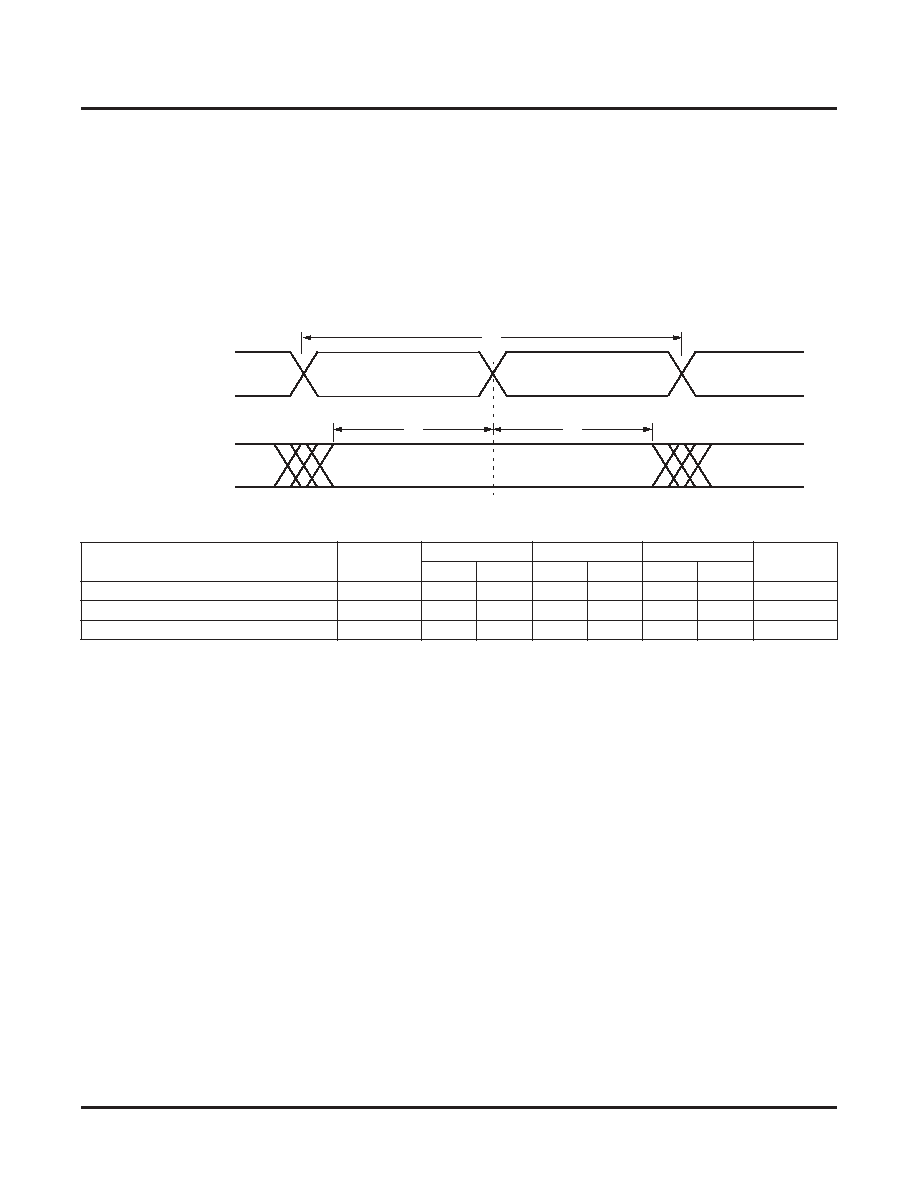
Lattice Semiconductor
ORCA ORLI10G Data Sheet
36
Timing Characteristics
Receive Input Data Interface
Receive STS-48/STS-192 (2.5G/10G) Data Inputs
Figure 19 illustrates the timing for the receive STS-48/STS-192 data stream. Both the clock and data pins are Low-
Voltage Differential Signal (LVDS) input buffers. The expected clock rate is 622 MHz--850 MHz, and the receive
data is clocked on the rising edge of the clock. In 2.5G mode, each of the four channels uses one set of one
RX_CLK_INn and four RX_DAT_INn data pins. In 10G mode, only RX_CLK_IN0 is used, along with the
RX_DAT_IN[15:0] pins. The timing values for the diagram in Figure 19 are given in Table 13.
Figure 19. Receive Input Data Timing
Table 13. Receive Data Input Timing
� It is recommended that the Rx clock be inverted by crossing the LVDS pin pair, that is, connect the
RX_CLK_IN_P[3:0] input signal on the ORLI10G to the N (i.e., complement) clock output from the transmitting
device and connect the RX_CLK_IN_N[3:0] input on the ORLI10G to the P (i.e., true) clock output from the trans-
mitting device. This is because the embedded line interface on the ORLI10G requires the Rx data to be centered
on the Rx clock, and typically the devices that drive the ORLI10G transmit clock and data on the same clock
edge.
Parameter
Symbol
�1
�2
�3
Unit
Min
Max
Min
Max
Min
Max
Clock Frequency
t1
--
667
--
790
--
850
MHz
Data Setup Time Required
t2
300
--
225
--
210
--
pS
Data Hold Time Required
t3
300
--
225
--
210
--
pS
RX_CLK_IN_P[3:0]
RX_DAT_IN_N[15:0]
t1
t3
t2
RX_CLK_IN_N[3:0]
RX_DAT_IN_P[15:0]

Lattice Semiconductor
ORCA ORLI10G Data Sheet
37
Transmit STS-48/STS-192 (2.5G/10G) Data Outputs
Figure 20 illustrates the timing for the transmit STS-48/STS-192 data stream. Both the clock and data pins are
driven with Low-Voltage Differential Signal (LVDS) output buffers. The expected clock rate is 622 MHz-850 MHz
and the transmit data is clocked out on the rising edge of the clock. In 2.5G mode, each of the four channels uses
one set of TX_CLK_OUTn with four TX_DAT_OUTn data pins. In 10G mode, only TX_CLK_OUT[0] is used with the
16 TX_DAT_OUT[15:0] pins. The timing values for the diagram in Figure 20 are given in Table 14.
Figure 20. Transmit Output Data Timing
Table 14. Transmit Data Output Timing
Note: This requirement is for all sources of the output clocks (e.g., RCLKSI, etc.).
It is recommended that the Tx clock be inverted by crossing the LVDS pin pair, that is, connect the
TX_CLK_OUT_P[3:0] output on the ORLI10G to the N (i.e., complement) clock input on the receiving device and
connect the TX_CLK_OUT_N[3:0] output on the ORLI10G to the P (i.e., true) clock input on the receiving device.
This is because the receiving device that will be driven by the ORLI10G typically requires that data be centered
around the clock, but the ORLI10G drives both the clock and data from the same clock edge.
Parameter
Symbol
�1
�2
�3
Unit
Min
Max
Min
Max
Min
Max
Clock Frequency
t4
--
667
--
790
--
850
MHz
Duty Cycle
--
45
55
45
55
45
55
%
Data Delay from Clock Edge
t5
�300
300
�225
225
�210
210
pS
Data Rise Time: 20%--80%
t6
100
200
100
200
100
200
pS
Data Fall Time: 80%--20%
t7
100
200
100
200
100
200
pS
t5
TX_DAT_OUT_P[15:0]
t6
t7
TX_CLK_OUT_N[3:0]
t4
TX_CLK_OUT_P[3:0]
TX_DAT_OUT_N[15:0]
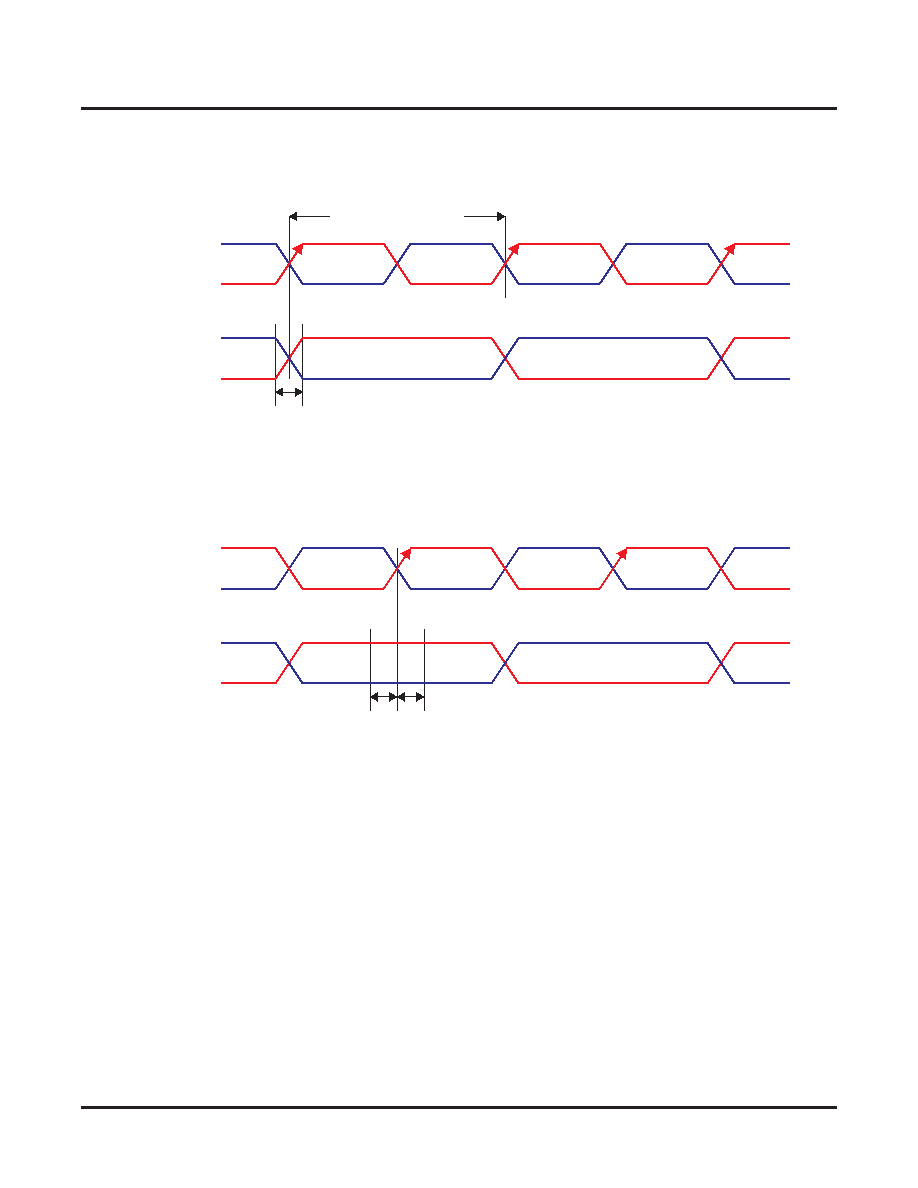
Lattice Semiconductor
ORCA ORLI10G Data Sheet
38
Recommended Board Level Routing For ORLI10G XSBI 10G Interface
The Transmit XSBI port sends clock and data simultaneously as shown in Figure 21.
Figure 21. Clock and Data signals from the TX
The correct clock and data relation required for the XSBI receiver is to have the clock centered in the data eye (as
shown in Figure 22).
Figure 22. Clock and Data Signals at the Receiver
In order to achieve the needed clock and data relationship at the receiver as shown in Figure 21, it is necessary to
swap the P and N clock terminals on the board. This is illustrated in Figure 23. The board level signal swap on the
receiver clock pins effectively inverts the clock phase at the receiving chip creating the correct clock data relation-
ship shown in Figure 22.
N
P
CLOCK
N
P
DATA
t
period
1500pS
=
t
prop
300pS
�
=
N
P
CLOCK
N
DATA
P
t
setup
300pS
=
t
hold
300pS
=

Lattice Semiconductor
ORCA ORLI10G Data Sheet
39
Figure 23. Implementing Clock Wire Swap
The above describes standard practice for XSBI 10G Interfaces.
TX
RX
P
N
P
N
CLOCK
DATA
P
N
P
N
Wire swap
implemented on
customer board
CLOCK
DATA
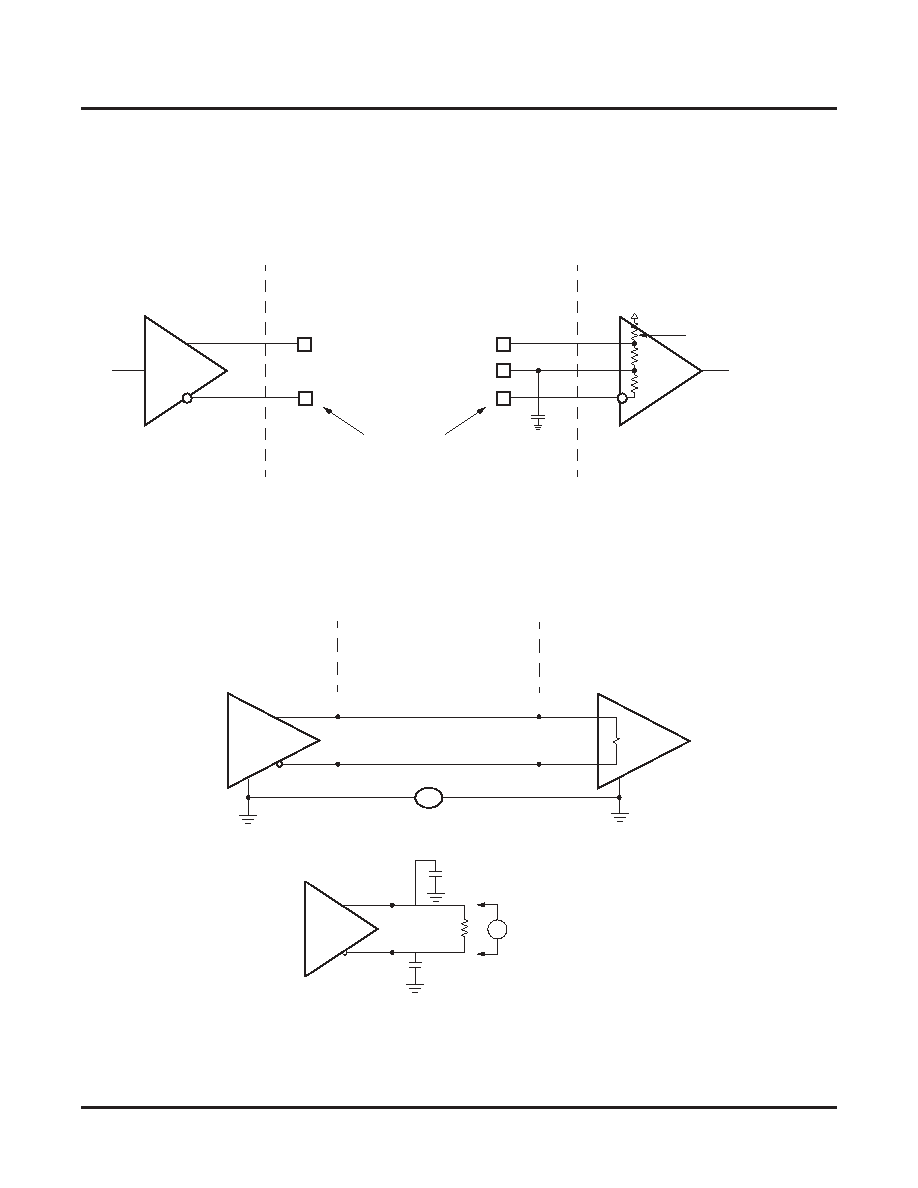
Lattice Semiconductor
ORCA ORLI10G Data Sheet
40
LVDS Buffer Characteristics
Termination Resistor
The LVDS drivers and receivers operate on a 100
differential impedance, as shown below. External resistors are
not required. The differential receiver buffers include termination resistors inside the device package, as shown in
Figure 24.
Figure 24. LVDS Driver and Receiver and Associated Internal Components
LVDS Driver Buffer Capabilities
Under worst-case operating condition, the LVDS driver must withstand a disabled or unpowered receiver for an
unlimited period of time without being damaged. Similarly, when its outputs are short-circuited to each other or to
ground, the LVDS driver will not suffer permanent damage. Figure 25 illustrates the terms associated with LVDS
driver and receiver pairs.
Figure 25. LVDS Driver and Receiver
Figure 26. LVDS Driver
LVDS DRIVER
50
50
LVDS RECEIVER
CENTER TAP
DEVICE PINS
EXTERNAL
V
DDD
= 3.3 V
~ 14 k
.01 �F
V
GPD
V
OA
V
OB
V
IA
V
IB
A
B
AA
BB
DRIVER INTERCONNECT
RECEIVER
V
OA
A
V
OB
B
C
A
C
B
R
LOAD
V
OD
= (V
OA
� V
OB
)
V
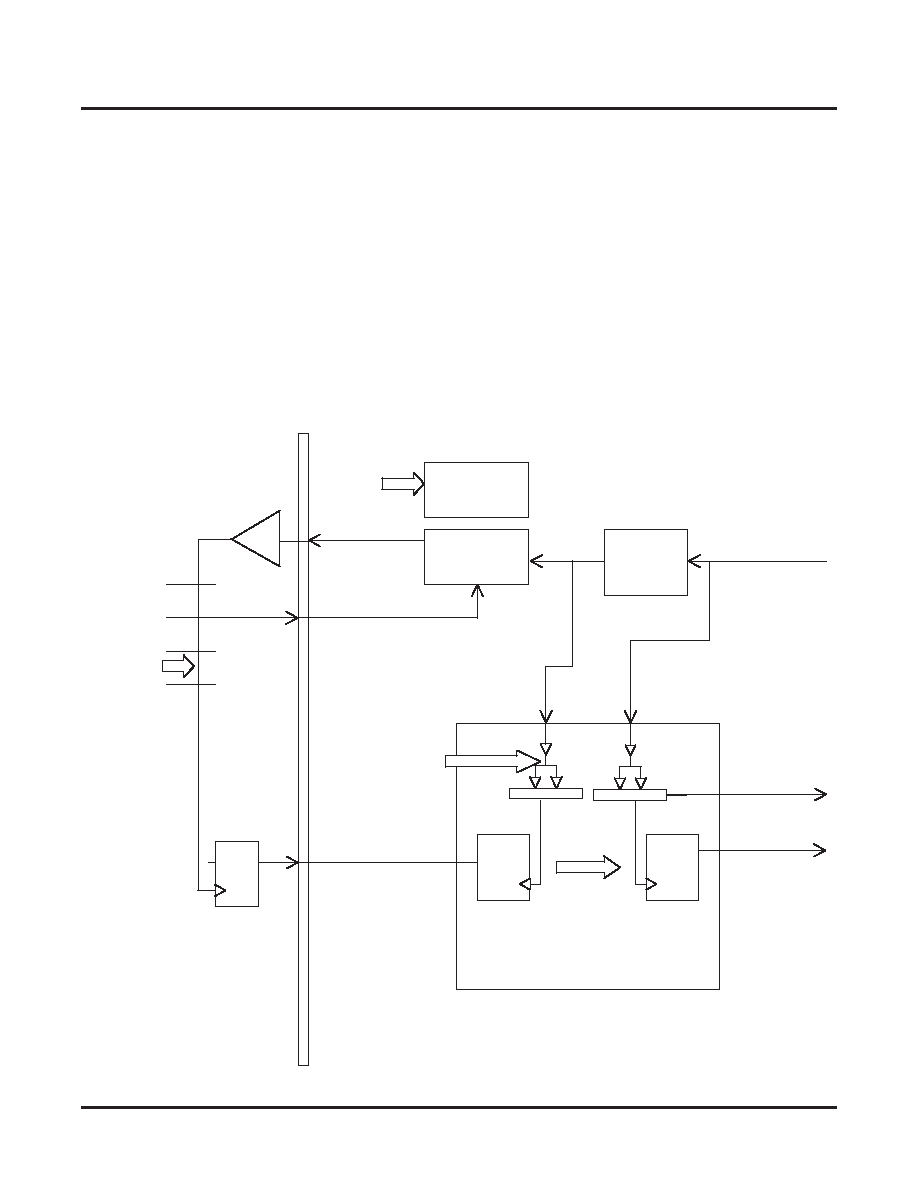
Lattice Semiconductor
ORCA ORLI10G Data Sheet
41
ORLI10G Interface Timing Diagrams
This section describes the timing at the FPGA � Core boundary. There are 4 distinct timing modes available for use
with the ORLI10G device (note that for TX, 10G mode can be used for either 10G or 2.5G operation):
� 10G RX and TX with PLL used across the interface.
� 10G RX and TX with NO PLL used across the interface.
� Quad 2.5G RX with NO PLL used across the interface plus 10G TX with PLL used across the interface.
� Quad 2.5G RX with NO PLL used across the interface plus 10G TX with NO PLL used across the interface.
Figure 27 shows a simplified, single channel view of the transmit path in divide-by-four mode. The divide-by-8
mode timing is similar, where the slow speed clocks are 1/8th the fast clock speed. PLL_TX2 is used to align clocks
across the Embedded Line Interface � FPGA boundary. The PLL_TX1 macro is not used as it is unneeded. The
PLLs in the embedded line interface can be bypassed via the PLL_BYPASS external FPSC pin. The feedback loop
shown is connected up automatically by the design kit software.
Figure 27. Single Channel Tx Divide-by-4 Diagram (-1 Speed Grade)
161 MHz
Unused
PLL_TX2
PLL_TX1
TX2_VCOP
TX2_FBCKI
644MHz
TX_DAT_IN[15:0]
3ns
data
Core Clock
Trees
TX_DAT_OUT
[3:0][P/N]
TX_CLK_OUT
[0][P/N]
Primary
FPGA Clock
Tree
High Speed
Multiplexer Block
Clock
Divider
/4
D
Q
TX_CLK_IN[P/N]
Embedded Line Interface Core
FPGA
Q
Low Speed

Lattice Semiconductor
ORCA ORLI10G Data Sheet
42
Figure 28 shows the Transmit (FPGA to embedded Line Interface) timing for 10G mode where PLL_TX2 is used to
align clocks across the FPGA - Core boundary. The 1.9 ns hold time shown is an approximate hold time value for
the embedded line interface. Consult the ispLEVER software, via the static timing analysis tool TRACE, for the
exact timing values. Figure 28. shows a full cycle transfer. Designers should make sure to satisfy the hold require-
ment.
Figure 28. Transmit Timing for 10G Mode with PLL for Clock Alignment (-1 Speed Grade)
0.0ns Setup
Launch
Capture
TX_CLK8_IN_BUF
1.6ns
3ns
TX_DAT_IN
Primary
FPGA Clock
Tree
Clock
Divider
PLL_TX2
Q
TX2_VCOP
TX2_FBCKI
Embedded Line Interface Core
FPGA
D
TX_CLK_IN
(644 MHz)
0.0ns
3.1ns
6.2ns
9.3ns
12.4ns
TX2_FBCKI
(Reference Clock)
3.1ns
9.3ns
FPGA Clock
1.1ns
4.2ns
7.3ns
10.4ns
13.5ns
TX_CLK8_IN_BUF
Data
Valid Data Window
0.0ns
6.2ns
12.4ns
1.9ns Hold
0.5ns

Lattice Semiconductor
ORCA ORLI10G Data Sheet
43
Figure 29 shows the Transmit (FPGA to embedded Line Interface) timing for 10G mode where PLL_TX2 is
bypassed via the PLL_BYPASS external FPSC pin. The 0.4 ns setup time and the 1.1 ns hold time shown are
approximate values for the embedded line interface. Consult the ispLEVER software, via the static timing analysis
tool TRACE, for the exact timing values. Figure 29 shows a half cycle transfer. Designers should make sure to sat-
isfy the hold requirement. A full cycle transfer is also possible for this scenario when the clock period is 10 ns or
longer (< 100 MHz).
Figure 29. Transmit Timing for 10G Mode with PLL Bypassed (-1 Speed Grade)
0.4ns Setup
Launch
Capture
TX_CLK8_IN_BUF
1.3ns
1.6ns
3ns
TX_DAT_IN
Primary
FPGA Clock
Tree
Clock
Divider
PLL_TX2
(Bypass Mode)
Q
TX2_VCOP
Embedded Line Interface Core
FPGA
D
TX_CLK_IN
(644 MHz)
0.0ns
3.1ns
6.2ns
9.3ns
12.4ns
TX2_VCOP
(Reference Clock)
3.0ns
9.2ns
FPGA Clock
0.3ns
3.4ns
6.5ns
9.6ns
12.7ns
TX_CLK8_IN_BUF
Data
-0.1ns
6.1ns
12.3ns
1.1ns Hold

Lattice Semiconductor
ORCA ORLI10G Data Sheet
44
Figure 30 shows a simplified, single channel view of the recieve path in divide-by-four mode. The divide-by-8 mode
timing is similar, where the slow speed clocks are 1/8th the fast clock speed. If a primary clock is used in the FPGA,
PLL_RX2 is used to align clocks across the embedded ASIC � FPGA boundary. If the secondary clock is used in
the FPGA, PLL_RX2 is not and there is a 1.0 ns to 3.5 ns clock insertion delay incurred on the secondary clocks.
The quad 2.5 G mode requires four secondary clocks to be used, one for each 2.5 G channel. The PLL_RX1 macro
is not used as it is unneeded. The PLLs in the embedded line interface can be bypassed via the PLL_BYPASS
external FPSC pin. The feedback loop shown is connected up automatically by the design kit software. The Mode
select on the clock multiplexer in the embedded line interface is also connected up automatically by the design kit
software. If in 10G mode, one clock is used and corresponds to the RX_CLK_IN[0] external device pin.
Figure 30. Single-Channel Rx Divide-by-4 Diagram (-1 Speed Grade)
Quad 2.5G or
Single 10G
Mode
RX_DAT_IN
[3:0][P/N]
Secondary
FPGA Clock
1.0 ns
to 3.5 ns
4
Unused
161 MHz
644 MHz
RX_DAT_IN[15:0]
3ns
data
Core Clock
Trees
Primary
FPGA Clock
Tree
High Speed Low Speed
Demultiplexer Block
Clock
Divider
/4
PLL_RX2
Q
D
PLL_RX1
RX2_VCOP
RX_CLK_IN
[3:0] [P/N]
RX2_FBCKI
Embedded Line Interface Core
FPGA
D

Lattice Semiconductor
ORCA ORLI10G Data Sheet
45
Figure 31 shows the Receive (Embedded Line Interface to FPGA) timing for 10G mode where PLL_RX2 is used to
align clocks across the FPGA - Core boundary. The 0.9 ns minimum propagation delay and 2.7 ns maximum prop-
agation delay shown are approximate values for the embedded line interface. In the waveform shown, data will be
time shifted at the FPGA capture register due to FPGA data path delay. Consult the ispLEVER software, via the
static timing analysis tool TRACE, for the exact timing values. Figure 31 shows a full cycle transfer.
Figure 31. Receive Timing for 10G Mode with PLL for Clock Alignment (-1 Speed Grade)
2.7 ns Tpd_max
1.4ns
RX2_FBCKI
0.9 ns Tpd_min
Launch
Capture
RX_CLK8_IN_MUX1
1.4ns
3ns
RX_DAT_IN
Primary
FPGA Clock
Tree
Clock
Divider
PLL_RX2
D
RX2_VCOP
Embedded Line Interface Core
FPGA
Q
RX_CLK_IN[0]
(644 MHz)
0.0ns
3.1ns
6.2ns
9.3ns
12.4ns
RX2_FBCKI
(Reference Clock)
3.1ns
9.3ns
FPGA Clock
4.5ns
7.6ns
10.7ns
13.8ns
RX_CLK8_IN_MUX1
Data
0.0ns
6.2ns
12.4ns
Hold
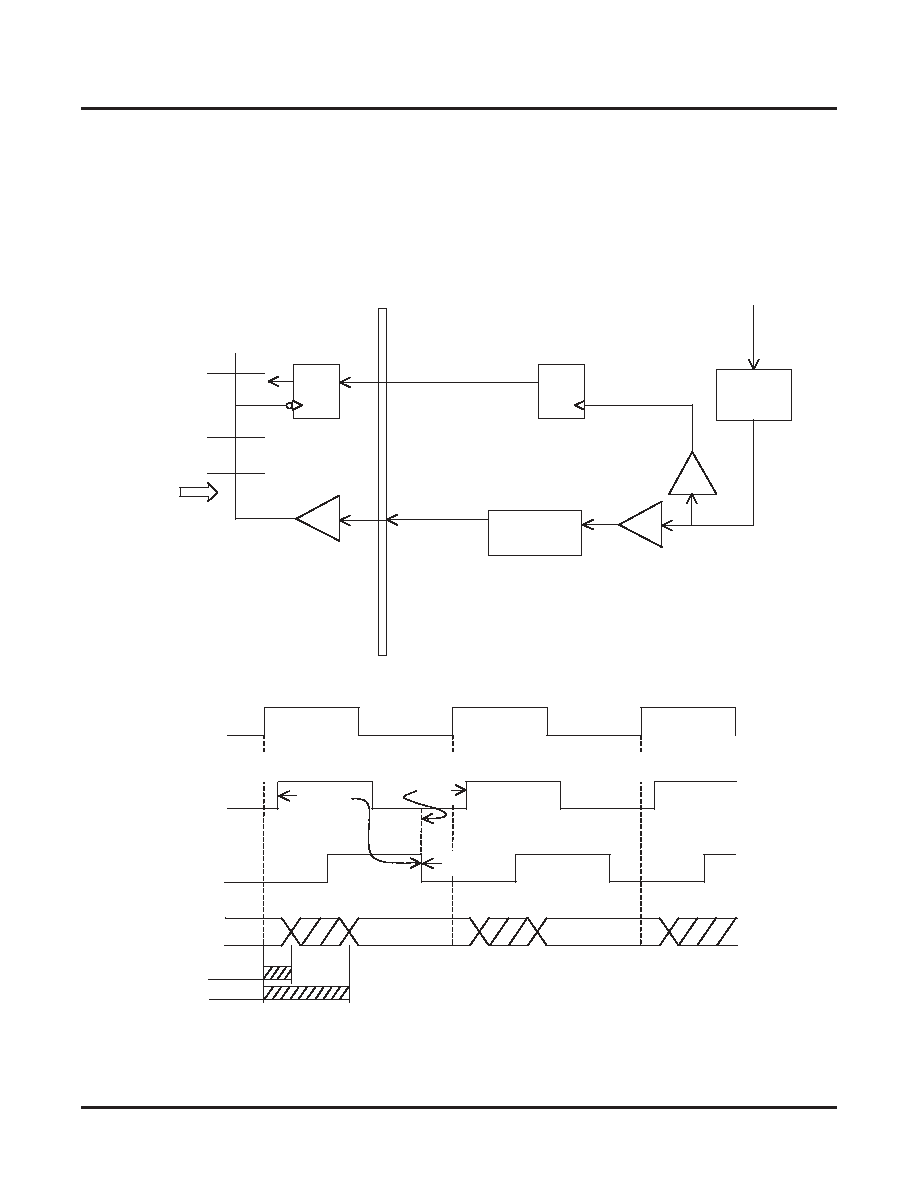
Lattice Semiconductor
ORCA ORLI10G Data Sheet
46
Figure 32 shows the Receive (Embedded Line Interface to FPGA) timing for 10G mode where PLL_RX2 is
bypassed via the PLL_BYPASS external FPSC pin. The 0.7 ns minimum propagation delay and 1.9 ns maximum
propagation delay shown are approximate values for the embedded line interface in this scenario. In the waveform
shown, data will be time shifted at the FPGA capture register due to FPGA data path delay. Consult the ispLEVER
software, via the static timing analysis tool TRACE, for the exact timing values. Figure 32 shows a half cycle trans-
fer; note the inversion bubble on the FPGA capture register. This half cycle transfer negates possible hold timing
issues. If a full cycle transfer is used with the receive PLL bypassed, check for hold violations with the static timing
analysis tool TRACE.
Figure 32. Receive Timing for 10G Mode with PLL Bypassed (-1 Speed Grade)
1.9 ns Tpd_max
3.0ns
0.7 ns Tpd_min
Launch
RX_CLK8_IN_MUX1
1.4ns
3ns
RX_DAT_IN
Primary
FPGA Clock
Tree
Clock
Divider
PLL_RX2
(Bypass Mode)
D
RX2_VCOP
Embedded Line Interface Core
FPGA
Q
RX_CLK_IN[0]
(100 MHz)
0.0ns
5.0ns
10.0ns
15.0ns
20.0ns
RX2_VCOP
(Reference Clock)
5.6ns
15.6ns
RX_CLK8_IN_MUX1
13.0ns
18.0ns
FPGA Clock
Data
0.6ns
10.6ns
20.6ns
Hold
0.8ns
Capture
8.0ns

Lattice Semiconductor
ORCA ORLI10G Data Sheet
47
Figure 33 shows the Receive (Embedded Line Interface to FPGA) timing for 2.5G mode where PLL_RX2 is
bypassed via the PLL_BYPASS external FPSC pin. The 0.9 ns minimum propagation delay and 2.7 ns maximum
propagation delay shown are approximate values for the embedded line interface in this scenario. In the waveform
shown, data will be time shifted at the FPGA capture register due to FPGA data path delay. Consult the ispLEVER
software, via the static timing analysis tool TRACE, for the exact timing values. The FPGA data path delay needs to
increase together with clock skew to avoid hold issues. The FPGA design should be checked for hold violations
with TRACE.
Figure 33. Receive Timing for 2.5G Mode with PLL Bypassed (-1 Speed Grade)
6.7ns
12.9ns
7.1ns
10.2ns
13.3ns
4.0ns
FPGA Clock
Short Skew
FPGA Clock
Long Skew
3.5ns
2.7 ns Tpd_max
0.9 ns Tpd_min
RX_CLK8_IN_MUX1
RX_DAT_IN
RX_CLK_IN_BUF
Clock
Divider
D
Embedded Line Interface Core
FPGA
Q
RX_CLK_IN[0]
(644 MHz)
0.0ns
3.1ns
6.2ns
9.3ns
12.4ns
RX_CLK_IN_BUF
(Reference Clock)
RX_CLK8_IN_MUX1
FPGA Clock
Short Skew
Data
1.4ns
Q
Secondary
Clock
0.5ns
D
Launch
Capture
4.5ns
10.7ns
0.5ns
3.6ns
9.8ns
1.4ns
7.6ns
13.8ns
Hold
FPGA Clock Long Skew
Capture
Hold
Potential hold violation.

Lattice Semiconductor
ORCA ORLI10G Data Sheet
48
Pin Information
Pin Descriptions
This section describes the pins found on the Series 4 FPGAs. Any pin not described in this table is a user-program-
mable I/O. During configuration, the user-programmable I/Os are 3-stated with an internal pull-up resistor enabled.
If any pin is not used (or not bonded to a package pin), it is also 3-stated with an internal pull-up resistor enabled
after configuration. The pin descriptions in Table 15 and throughout this data sheet show active-low signals with an
overscore. The package pinout tables that follow show this as a signal ending with _N. Therefore, LDC and LDC_N
are equivalent.
Table 15. Pin Descriptions
Symbol
I/O
Description
Dedicated Pins
V
DD
33
--
3.3 V positive power supply. This power supply is used for 3.3 V configuration RAMs and internal
PLLs. When using PLLs, this power supply should be well isolated from all other power supplies on
the board for proper operation.
V
DD
15
--
1.5 V positive power supply for internal logic.
V
DD
IO
--
Positive power supply used by I/O banks.
V
SS
--
Ground.
PTEMP
I
Temperature sensing diode pin. Dedicated input.
RESET
I
During configuration, RESET forces the restart of configuration and a pull-up is enabled. After con-
figuration, RESET can be used as a general FPGA input or as a direct input, which causes all PLC
latches/Flip-Flops to be asynchronously set/reset.
CCLK
O
In the master and asynchronous peripheral modes, CCLK is an output which strobes configuration
data in.
I
In the slave or readback after configuration, CCLK is input synchronous with the data on DIN or
D[7:0]. CCLK is an output for daisy-chain operation when the lead device is in master, peripheral, or
system bus modes.
DONE
I
As an input, a low level on DONE delays FPGA start-up after configuration.*
O
As an active-high, open-drain output, a high level on this signal indicates that configuration is com-
plete. DONE has an optional pull-up resistor.
PRGM
I
PRGM
is an active-low input that forces the restart of configuration and resets the boundary-scan
circuitry. This pin always has an active pull-up.
RD_CFG
I
This pin must be held high during device initialization until the INIT pin goes high. This pin always
has an active pull-up.
During configuration, RD_CFG is an active-low input that activates the TS_ALL function and 3-states
all of the I/O.
After configuration, RD_CFG can be selected (via a bit stream option) to activate the TS_ALL func-
tion as described above, or, if readback is enabled via a bit stream option, a high-to-low transition on
RD_CFG
will initiate readback of the configuration data, including PFU output states, starting with
frame address 0.
RD_DATA/TDO
O
RD_DATA/TDO is a dual-function pin. If used for readback, RD_DATA provides configuration data
out. If used in boundary-scan, TDO is test data out.
CFG_IRQ/MPI_IR
Q
O
During JTAG, slave, master, and asynchronous peripheral configuration, assertion on this
CFG_IRQ
(active-low) indicates an error or errors for block RAM or FPSC initialization.
MPI
active-low interrupt
request output, when the MPI is used.
*The timing of DONE release is controlled by one set of bit stream options, and the timing of the simultaneous release of all
other configuration pins (and the activation of all user I/Os) is controlled by a second set of options.

Lattice Semiconductor
ORCA ORLI10G Data Sheet
49
Pin Information
(continued)
Table 15. Pin Descriptions (continued)
Symbol
I/O
Description
Special-Purpose Pins
M[3:0]
I
During powerup and initialization, M0--M3 are used to select the configuration mode with their val-
ues latched on the rising edge of INIT. During configuration, a pull-up is enabled.
I/O After configuration, these pins are user-programmable I/O.*
PLL_CK[0:7][TC]
I
Semidedicated PLL clock pins. During configuration they are 3-stated with a pull-up.
I/O These pins are user-programmable I/O pins if not used by PLLs after configuration.
P[TBLR]CLK[1:0][T
C]
I
Pins dedicated for the primary clock. Input pins on the middle of each side with differential pairing.
I/O After configuration, these pins are user-programmable I/O, if not used for clock inputs.
TDI, TCK, TMS
I
If boundary-scan is used, these pins are test data in, test clock, and test mode select inputs. If
boundary-scan is not selected, all boundary-scan functions are inhibited once configuration is com-
plete. Even if boundary-scan is not used, either TCK or TMS must be held at logic 1 during configu-
ration. Each pin has a pull-up enabled during configuration.
I/O After configuration, these pins are user-programmable I/O if boundary scan is not used.*
RDY/BUSY/RCLK
O
During configuration in asynchronous peripheral mode, RDY/RCLK indicates another byte can be
written to the FPGA. If a read operation is done when the device is selected, the same status is also
available on D7 in asynchronous peripheral mode.
During the master parallel configuration mode, RCLK is a read output signal to an external memory.
This output is not normally used.
I/O After configuration, this pin is a user-programmable I/O pin.*
HDC
O
High during configuration is output high until configuration is complete. It is used as a control output,
indicating that configuration is not complete.
I/O After configuration, this pin is a user-programmable I/O pin.*
LDC
O
Low during configuration is output low until configuration is complete. It is used as a control output,
indicating that configuration is not complete.
I/O After configuration, this pin is a user-programmable I/O pin.*
INIT
I/O
INIT
is a bidirectional signal before and during configuration. During configuration, a pull-up is
enabled, but an external pull-up resistor is recommended. As an active-low open-drain output, INIT
is held low during power stabilization and internal clearing of memory. As an active-low input, INIT
holds the FPGA in the wait-state before the start of configuration.
After configuration, this pin is a user-programmable I/O pin.*
CS0, CS1
I
CS0
and CS1 are used in the asynchronous peripheral, slave parallel, and microprocessor configu-
ration modes. The FPGA is selected when CS0 is low and CS1 is high. During configuration, a pull-
up is enabled.
I/O After configuration, if MPI is not used, these pins are user-programmable I/O pins.*
RD/MPI_STRB
I
RD
is used in the asynchronous peripheral configuration mode. A low on RD changes D[7:3] into a
status output. WR and RD should not be used simultaneously. If they are, the write strobe overrides.
This pin is also used as the
MPI
data transfer strobe. As a status indication, a high indicates ready,
and a low indicates busy.
I/O After configuration, if the
MPI
is not used, this pin is a user-programmable I/O pin.*
* The timing of DONE release is controlled by one set of bit stream options, and the timing of the simultaneous release of all
other configuration pins (and the activation of all user I/Os) is controlled by a second set of options.

Lattice Semiconductor
ORCA ORLI10G Data Sheet
50
Pin Information
(continued)
Table 15. Pin Descriptions (continued)
Symbol
I/O
Description
Special-Purpose Pins (continued)
WR/MPI_RW
I
WR is used in asynchronous peripheral mode. A low on WR transfers data on D[7:0] to the FPGA.
In MPI mode, a high on MPI_RW allows a read from the data bus, while a low causes a write transfer
to the FPGA.
I/O After configuration, if the MPI is not used, WR/MPI_RW is a user-programmable I/O pin.*
PPC_A[14:31]
I
During MPI mode, the PPC_A[14:31] are used as the address bus driven by the PowerPC bus master
utilizing the least-significant bits of the PowerPC 32-bit address.
MPI_BURST
I
MPI_BURST is driven low to indicate a burst transfer is in progress in MPI mode. Driven high indicates
that the current transfer is not a burst.
MPI_BDIP
I
MPI_BDIP is driven by the PowerPC processor in MPI mode. Assertion of this pin indicates that the
second beat in front of the current one is requested by the master. Negated before the burst transfer
ends to abort the burst data phase.
MPI_TSZ[0:1]
I
MPI_TSZ[0:1] signals are driven by the bus master in MPI mode to indicate the data transfer size for
the transaction. Set 01 for byte, 10 for half-word, and 00 for word.
A[21:0]
O
During master parallel mode, A[21:0] address the configuration EPROMs up to 4 Mbytes.
I/O If not used for MPI, these pins are user-programmable I/O pins after configuration.*
MPI_ACK
O
In
MPI
mode, this is driven low indicating the MPI received the data on the write cycle or returned data
on a read cycle.
I/O If not used for MPI, these pins are user-programmable I/O pins after configuration.*
MPI_CLK
I
This is the PowerPC synchronous, positive-edge bus clock used for the
MPI
interface. It can be a
source of the clock for the embedded system bus. If MPI is used, this will be the AMBA bus clock.
I/O If not used for MPI, these pins are user-programmable I/O pins after configuration.*
MPI_TEA
O
A low on the MPI transfer error acknowledge indicates that the MPI detects a bus error on the internal
system bus for the current transaction.
I/O If not used for MPI, these pins are user-programmable I/O pins after configuration.*
MPI_RTRY
O
This pin requests the MPC860 relinquish the bus and retry the cycle.
I/O If not used for MPI, these pins are user-programmable I/O pins after configuration.*
D[0:31]
I/O
Selectable data bus width from 8-, 16-, 32-bit in MPI mode. Driven by the bus master in a write transac-
tion and driven by MPI in a read transaction.
I
D[7:0] receive configuration data during master parallel, peripheral, and slave parallel configuration
modes when WR is low and each pin has a pull-up enabled. During serial configuration modes, D0 is
the DIN input.
O
D[7:3] output internal status for asynchronous peripheral mode when RD is low.
I/O After configuration, if MPI is not used, the pins are user-programmable I/O pins.*
DP[0:3]
I/O
Selectable parity bus width in MPI mode from 1-, 2-, 4-bit, DP[0] for D[0:7], DP[1] for D[8:15], DP[2] for
D[16:23], and DP[3] for D[24:31].
After configuration, if MPI is not used, the pins are user-programmable I/O pin.*
* The timing of DONE release is controlled by one set of bit stream options, and the timing of the simultaneous release of all other configuration
pins (and the activation of all user I/Os) is controlled by a second set of options.

Lattice Semiconductor
ORCA ORLI10G Data Sheet
51
Pin Information
(continued)
Table 15. Pin Descriptions (continued)
Symbol
I/O
Description
Special-Purpose Pins
(continued)
DIN
I
During slave serial or master serial configuration modes, DIN accepts serial configuration data syn-
chronous with CCLK. During parallel configuration modes, DIN is the D0 input. During configuration, a
pull-up is enabled.
I/O After configuration, this pin is a user-programmable I/O pin.*
DOUT
O
During configuration, DOUT is the serial data output that can drive the DIN of daisy-chained slave
devices. Data out on DOUT changes on the rising edge of CCLK.
I/O After configuration, DOUT is a user-programmable I/O pin.*
TESTCFG
I
During configuration this pin should be held high, to allow configuration to occur. A pull-up is enabled
during configuration.
I/O After configuration, TESTCFG is a user-programmable I/O pin.*
* The timing of DONE release is controlled by one set of bit stream options, and the timing of the simultaneous release of all other configuration
pins (and the activation of all user I/Os) is controlled by a second set of options.

Lattice Semiconductor
ORCA ORLI10G Data Sheet
52
Pin Information
(continued)
This table describes the I/O signal ports on the embedded core portion of the device.
Table 16. FPSC Function Pin Description
Symbol
I/O
Description
Control and Global Pins
PLL_BYPASS
I
3.3 V active-high. Enables the bypass mode for both receive and both transmit
PLLs.
PWRDN
I
3.3 V active-high. Power down all LVDS links and both receive and both trans-
mit PLLs.
RESET_RX
I
3.3 V active-high. Resets the receive PLLs and the demultiplexer block.
RESET_TX
I
3.3 V active-high. Resets the transmit PLLs and the multiplexer block.
Receive I/O Pins
RX_DAT_IN_N<15:0>
I
LVDS data input for receive side.
RX_DAT_IN_P<15:0>
I
LVDS data input for receive side.
RX_CLK_IN_N<3:0>
I
LVDS clock inputs for receive side.
RX_CLK_IN_P<3:0>
I
LVDS clock inputs for receive side.
Transmit I/O Pins
TX_DAT_OUT_N<15:0>
O
LVDS data outputs on transmit side.
TX_DAT_OUT_P<15:0>
O
LVDS data outputs on transmit side.
TX_CLK_OUT_N<3:0>
O
LVDS clock outputs on transmit side.
TX_CLK_OUT_P<3:0>
O
LVDS clock outputs on transmit side.
TX_CLK_IN_N
I
LVDS transmit reference clock input.
TX_CLK_IN_P
I
LVDS transmit reference clock input.
LVDS Input Reference Pins
LV_REF10
--
LVDS reference voltage: 1.0 V � 3%.
LV_REF14
--
LVDS reference voltage: 1.4 V � 3%.
LV_RESHI
--
LVDS resistor high pin (use 100
to LV_RESLO pin).
LV_RESLO
--
LVDS resistor low pin (use 100
to LV_RESHI pin).
LVCTAP_[6:1]
--
LVDS input centertap (use 0.01 �F to GRD).

Lattice Semiconductor
ORCA ORLI10G Data Sheet
53
Pin Information
(continued)
In Table 17, an output refers to a signal flowing into the FGPA logic (out of the embedded core) and an input refers
to a signal flowing out of the FPGA logic (into the embedded core).
Table 17. Embedded Core/FPGA Interface Signal Description
Symbol
I/O
Description
Receive Signals
RX_DAT_OUT<127:0>
O
Data from demultiplexer on receive side.
RX_CLK8_OUT<3:0>
O
Divided down clocks on receive side.
RX_ENB8_OUT<3:0>
O
Data enables on receive side.
RX1_VCOP
O
RX1_PLL output clock on receive side (M/N clock) after phase select.
RX1_VCO
O
RX1_PLL output clock on receive side (M/N clock) before phase select.
RX2_VCOP
O
RX2_PLL output clock on receive side (x1 clock) before phase select.
RX2_VCO
O
RX2_PLL output clock on receive side (x1 clock) before phase select.
RX2_FBCKI
I
PLL feedback input to RX2_PLL. This allows for the removal of the FPGA clock
routing delay.
RX1_BYPASS
I
Set to 1 to bypass the RX1 PLL.
RX2_BYPASS
I
Set to 1 to bypass the RX2 PLL
RX_LOCK
O
Lock the signal for RX1_PLL and RX2_PLL. This signal is a logical OR of the
lock signal from both PLLs. It is not integrated; thus, small glitches can occur
on this signal during normal PLL operation.
Transmit Signals
TX_DAT_IN<127:0>
I
Data to multiplexer on transmit side.
TX_CLK8_IN<3:0>
I
Clocks to multiplexer on transmit side.
TX_ENB8_IN<3:0>
I
Data enables on transmit side.
TX1_VCOP
O
TX1_PLL output clock on transmit side (M/N clock) after phase select.
TX1_VCO
O
TX1_PLL output clock on transmit side (M/N clock) before phase select.
TX2_VCOP
O
TX2_PLL output clock on transmit side (x1 clock) after phase select.
TX2_VCO
O
TX2_PLL output clock on transmit side (x1 clock) before phase select.
TX2_FBCKI
I
PLL feedback input to TX2 PLL. This allows for the removal of the FPGA clock
routing delay.
TX1_BYPASS
I
Set to 1 to bypass the TX1 PLL.
TX2_BYPASS
I
Set to 1 to bypass the TX2 PLL.
TX_LOCK
O
Lock signal for TX1_PLL and TX2_PLL. This signal is a logical OR of the lock
signal from both PLLs. It is not integrated; thus, small glitches can occur on
this signal during normal operation.
VSS_A<7:4>
--
Analog ground for the embedded line interface PLLs.
VDD33_A<7:4>
--
Analog power supply for the embedded line interface PLLs.
Miscellaneous Signals
FPGA_RESET
I
A logic 1 resets all receive and transmit logic, including PLLs.

Lattice Semiconductor
ORCA ORLI10G Data Sheet
54
Package Pinouts
Table 18 provides the number of user-programmable I/Os available for each available package. Table 19 provides
the package pin and pin function for the ORLI10G FPSC and packages. The bond pad name is identified in the PIO
nomenclature used in the ispLEVER design editor. The bank column provides information as to which output volt-
age level bank the given pin is in. The group column provides information as to the group of pins the given pin is in.
This is used to show which VREF pin is used to provide the reference voltage for single-ended limited-swing I/Os. If
none of these buffer types (such as SSTL, GTL, HSTL) are used in a given group, then the VREF pin is available as
an I/O pin.
When the number of FPGA bond pads exceeds the number of package pins, bond pads are unused. When the
number of package pins exceeds the number of bond pads, package pins are left unconnected (no connects).
When a package pin is to be left as a no connect for a specific die, it is indicated as a note in the device column for
the FPGA. The tables provide no information on unused pads.
Table 18. ORCA Programmable I/Os Summary
The built-in MicroProcessor Interface (MPI) cannot be fully utilized in the 680-pin PBGA package because the
implementation of the XGMII interface limits the number of available address and data pins.
As shown in the Pair columns in Table 19, differential pairs and physical locations are numbered within each bank
(e.g., L19C_A0 is the nineteenth pair in an associated bank). A C indicates complementary differential, whereas a
T indicates true differential. An _A0 indicates the physical location of adjacent balls in either the horizontal or verti-
cal direction. Other physical indicators are as follows:
� _A1 indicates one ball between pairs.
� _A2 indicates two balls between pairs.
� _D0 indicates balls are diagonally adjacent.
� _D1 indicates balls are diagonally adjacent separated by one physical ball.
VREF pins, shown in the Pin Description column in Table 19, are associated to the bank and group
(e.g., VREF_TL_01 is the VREF for group one of the Top Left (TL) bank).
Device
680 PBGAM
User programmable I/O
316
Available programmable differential pair
pins
272
FPGA configuration pins
7
FPGA dedicated function pins
2
Core function pins
86
V
DD
15
86
V
DD
33_A
4
V
DD
33
28
V
DD
IO
44
V
SS
95
V
SS
_A
4
LVCTAP for dedicated differential chan-
nels
6
Core LV_REF pins
4
Total package pins
680

Lattice Semiconductor
ORCA ORLI10G Data Sheet
55
Pin Configuration
Table 19. PBGA Pinout Table
BM68
0
V
DD
IO
Bank
VREF
Group
I/O
Pin Description
Additional Function
BM680 Pair
A1
--
--
V
SS
V
SS
--
--
E5
--
--
V
DD
33
V
DD
33
--
--
E4
--
--
O
PRD_DATA
RD_DATA/TDO
--
--
--
--
V
DD
15
V
DD
15
--
--
C1
--
--
I
PRESET_N
RESET_N
--
D1
--
--
I
PRD_CFG_N
RD_CFG_N
--
E2
--
--
I
PPRGRM_N
PRGRM_N
--
A2
0 (TL)
--
V
DD
IO0
V
DD
IO0
--
--
F4
0 (TL)
7
IO
PL2D
PLL_CK0C/HPPLL
L21C_A0
F3
0 (TL)
7
IO
PL2C
PLL_CK0T/HPPLL
L21T_A0
A3
0 (TL)
--
V
DD
IO0
V
DD
IO0
--
--
G5
0 (TL)
7
IO
PL3D
--
L22C_A0
F5
0 (TL)
7
IO
PL3C
VREF_0_07
L22T_A0
A18
--
--
V
SS
V
SS
--
--
G4
0 (TL)
7
IO
PL4D
D5
L23C_D1
F2
0 (TL)
7
IO
PL4C
D6
L23T_D1
B1
0 (TL)
--
V
DD
IO0
V
DD
IO0
--
--
H5
0 (TL)
8
IO
PL4B
--
L24C_D1
G3
0 (TL)
8
IO
PL4A
VREF_0_08
L24T_D1
F1
0 (TL)
8
IO
PL5D
HDC
L25C_A0
G2
0 (TL)
8
IO
PL5C
LDC_N
L25T_A0
A33
--
--
V
SS
V
SS
--
--
H4
0 (TL)
8
IO
PL5B
--
L26C_A0
J5
0 (TL)
8
IO
PL5A
--
L26T_A0
H3
0 (TL)
9
IO
PL6D
TESTCFG
L27C_D1
G1
0 (TL)
9
IO
PL6C
D7
L27T_D1
B3
0 (TL)
--
V
DD
IO0
V
DD
IO0
--
--
J4
0 (TL)
9
IO
PL7D
VREF_0_09
L28C_D1
H2
0 (TL)
9
IO
PL7C
A17/PPC_A31
L28T_D1
A34
--
--
V
SS
V
SS
--
--
K5
0 (TL)
9
IO
PL8D
CS0_N
L29C_D1
J3
0 (TL)
9
IO
PL8C
CS1
L29T_D1
C2
0 (TL)
--
V
DD
IO0
V
DD
IO0
--
--
H1
0 (TL)
10
IO
PL9D
--
L30C_A0
J2
0 (TL)
10
IO
PL9C
--
L30T_A0
B2
--
--
V
SS
V
SS
--
--
K4
0 (TL)
10
IO
PL9A
--
--
L5
0 (TL)
10
IO
PL10D
INIT_N
L31C_D1
K3
0 (TL)
10
IO
PL10C
DOUT
L31T_D1
--
--
--
V
DD
15
V
DD
15
--
--
J1
0 (TL)
10
IO
PL11D
VREF_0_10
L32C_A0
K2
0 (TL)
10
IO
PL11C
A16/PPC_A30
L32T_A0

Lattice Semiconductor
ORCA ORLI10G Data Sheet
56
B33
--
--
V
SS
V
SS
--
--
K1
0 (TL)
10
IO
PL11A
--
--
M5
7 (CL)
1
IO
PL12D
A15/PPC_A29
L1C_A0
L4
7 (CL)
1
IO
PL12C
A14/PPC_A28
L1T_A0
L1
7 (CL)
--
V
DD
IO7
V
DD
IO7
--
--
M4
7 (CL)
1
IO
PL12B
--
L2C_A0
N5
7 (CL)
1
IO
PL12A
--
L2T_A0
L3
7 (CL)
1
IO
PL13D
VREF_7_01
L3C_A0
L2
7 (CL)
1
IO
PL13C
D4
L3T_A0
B34
--
--
V
SS
V
SS
--
--
N4
7 (CL)
2
IO
PL13B
--
L4C_A0
P5
7 (CL)
2
IO
PL13A
--
L4T_A0
M2
7 (CL)
2
IO
PL14D
RDY/BUSY_N/RCLK
L5C_A0
M1
7 (CL)
2
IO
PL14C
VREF_7_02
L5T_A0
M3
7 (CL)
--
V
DD
IO7
V
DD
IO7
--
--
N3
7 (CL)
2
IO
PL15D
A13/PPC_A27
L6C_A0
N2
7 (CL)
2
IO
PL15C
A12/PPC_A26
L6T_A0
C3
--
--
V
SS
V
SS
--
--
P4
7 (CL)
3
IO
PL16D
--
L7C_A0
P3
7 (CL)
3
IO
PL16C
--
L7T_A0
R3
7 (CL)
--
V
DD
IO7
V
DD
IO7
--
--
R5
7 (CL)
3
IO
PL16A
--
--
N1
7 (CL)
3
IO
PL17D
A11/PPC_A25
L8C_A0
P2
7 (CL)
3
IO
PL17C
VREF_7_03
L8T_A0
C13
--
--
V
SS
V
SS
--
--
R4
7 (CL)
3
IO
PL17A
--
--
P1
7 (CL)
3
IO
PL18D
--
L9C_A0
R2
7 (CL)
3
IO
PL18C
--
L9T_A0
--
--
--
V
DD
15
V
DD
15
--
--
T2
7 (CL)
3
IO
PL18B
--
L10C_A0
R1
7 (CL)
3
IO
PL18A
--
L10T_A0
T5
7 (CL)
4
IO
PL19D
RD_N/MPI_STRB_N
L11C_A0
T4
7 (CL)
4
IO
PL19C
VREF_7_04
L11T_A0
C22
--
--
V
SS
V
SS
--
--
U5
7 (CL)
4
IO
PL19B
--
L12C_D1
T3
7 (CL)
4
IO
PL19A
--
L12T_D1
T1
7 (CL)
4
IO
PL20D
PLCK0C
L13C_D1
U3
7 (CL)
4
IO
PL20C
PLCK0T
L13T_D1
U1
7 (CL)
--
V
DD
IO7
V
DD
IO7
--
--
U4
7 (CL)
4
IO
PL20B
--
L14C_A1
Table 19. PBGA Pinout Table
BM68
0
V
DD
IO
Bank
VREF
Group
I/O
Pin Description
Additional Function
BM680 Pair

Lattice Semiconductor
ORCA ORLI10G Data Sheet
57
U2
7 (CL)
4
IO
PL20A
--
L14T_A1
--
--
--
V
DD
15
V
DD
15
--
--
C32
--
--
V
SS
V
SS
--
--
V1
7 (CL)
5
IO
PL21D
A10/PPC_A24
L15C_A0
V2
7 (CL)
5
IO
PL21C
A9/PPC_A23
L15T_A0
D4
--
--
V
SS
V
SS
--
--
V3
7 (CL)
5
IO
PL21B
--
L16C_A0
V4
7 (CL)
5
IO
PL21A
--
L16T_A0
V5
7 (CL)
5
IO
PL22D
A8/PPC_A22
L17C_A0
W4
7 (CL)
5
IO
PL22C
VREF_7_05
L17T_A0
--
--
--
V
DD
15
V
DD
15
--
--
W3
7 (CL)
5
IO
PL23D
--
L18C_A0
W2
7 (CL)
5
IO
PL23C
--
L18T_A0
D30
--
--
V
SS
V
SS
--
--
Y1
7 (CL)
5
IO
PL23A
--
--
W5
7 (CL)
6
IO
PL24D
PLCK1C
L19C_A0
Y4
7 (CL)
6
IO
PL24C
PLCK1T
L19T_A0
W1
7 (CL)
--
V
DD
IO7
V
DD
IO7
--
--
Y2
7 (CL)
6
IO
PL24A
--
--
Y5
7 (CL)
6
IO
PL25D
VREF_7_06
L20C_D1
AA3
7 (CL)
6
IO
PL25C
A7/PPC_A21
L20T_D1
D31
--
--
V
SS
V
SS
--
--
AA2
7 (CL)
6
IO
PL25A
--
--
AA1
7 (CL)
6
IO
PL26D
A6/PPC_A20
L21C_A0
AB1
7 (CL)
6
IO
PL26C
A5/PPC_A19
L21T_A0
Y3
7 (CL)
--
V
DD
IO7
V
DD
IO7
--
--
AA4
7 (CL)
7
IO
PL26B
--
--
AB2
7 (CL)
7
IO
PL27D
WR_N/MPI_RW
L22C_A0
AB3
7 (CL)
7
IO
PL27C
VREF_7_07
L22T_A0
AA5
7 (CL)
7
IO
PL27B
--
L23C_A0
AB4
7 (CL)
7
IO
PL27A
--
L23T_A0
AC2
7 (CL)
8
IO
PL28D
A4/PPC_A18
L23C_A0
AC1
7 (CL)
8
IO
PL28C
VREF_7_08
L23T_A0
AC3
7 (CL)
--
V
DD
IO7
V
DD
IO7
--
--
AB5
7 (CL)
8
IO
PL29D
A3/PPC_A17
L23C_A0
AC4
7 (CL)
8
IO
PL29C
A2/PPC_A16
L23T_A0
D33
--
--
V
SS
V
SS
--
--
AD2
7 (CL)
8
IO
PL29A
--
--
AC5
7 (CL)
8
IO
PL30D
A1/PPC_A15
L24C_D1
AD3
7 (CL)
8
IO
PL30C
A0/PPC_A14
L24T_D1
Table 19. PBGA Pinout Table
BM68
0
V
DD
IO
Bank
VREF
Group
I/O
Pin Description
Additional Function
BM680 Pair

Lattice Semiconductor
ORCA ORLI10G Data Sheet
58
AE1
7 (CL)
8
IO
PL31D
DP0
L25C_A0
AE2
7 (CL)
8
IO
PL31C
DP1
L25T_A0
E34
--
--
V
SS
V
SS
--
--
AF1
7 (CL)
8
IO
PL31A
--
--
AD5
6 (BL)
1
IO
PL32D
D8
L1C_A0
AD4
6 (BL)
1
IO
PL32C
VREF_6_01
L1T_A0
AK4
6 (BL)
--
V
DD
IO6
V
DD
IO6
--
--
AE3
6 (BL)
1
IO
PL32A
--
--
AE5
6 (BL)
1
IO
PL33D
D9
L2C_A0
AE4
6 (BL)
1
IO
PL33C
D10
L2T_A0
F33
--
--
V
SS
V
SS
--
--
AF2
6 (BL)
2
IO
PL34D
--
L3C_A0
AG1
6 (BL)
2
IO
PL34C
VREF_6_02
L3T_A0
AK5
6 (BL)
--
V
DD
IO6
V
DD
IO6
--
--
AF3
6 (BL)
2
IO
PL34B
--
L4C_A1
AF5
6 (BL)
2
IO
PL34A
--
L4T_A1
H34
--
--
V
SS
V
SS
--
--
AG2
6 (BL)
3
IO
PL35B
D11
L5C_D1
AF4
6 (BL)
3
IO
PL35A
D12
L5T_D1
AH1
6 (BL)
3
IO
PL36D
--
L6C_D1
AG3
6 (BL)
3
IO
PL36C
--
L6T_D1
AL1
6 (BL)
--
V
DD
IO6
V
DD
IO6
--
--
AH2
6 (BL)
3
IO
PL36B
VREF_6_03
L7C_A0
AJ1
6 (BL)
3
IO
PL36A
D13
L7T_A0
AG4
6 (BL)
4
IO
PL37D
--
--
J33
--
--
V
SS
V
SS
--
--
AH3
6 (BL)
4
IO
PL37B
--
L8C_D1
AG5
6 (BL)
4
IO
PL37A
VREF_6_04
L8T_D1
AJ2
6 (BL)
4
IO
PL38C
--
--
AL3
6 (BL)
--
V
DD
IO6
V
DD
IO6
--
--
AK1
6 (BL)
4
IO
PL38B
--
--
AH4
6 (BL)
4
IO
PL38A
--
--
AJ3
6 (BL)
4
IO
PL39D
PLL_CK7C/HPPLL
L9C_A0
AK2
6 (BL)
4
IO
PL39C
PLL_CK7T/HPPLL
L9T_A0
L34
--
--
V
SS
V
SS
--
--
AH5
6 (BL)
4
IO
PL39B
--
L10C_A0
AJ4
6 (BL)
4
IO
PL39A
--
L10T_A0
N13
--
--
V
SS
V
SS
--
--
AK3
--
--
I
PTEMP
PTEMP
--
AM1
6 (BL)
--
V
DD
IO6
V
DD
IO6
--
--
Table 19. PBGA Pinout Table
BM68
0
V
DD
IO
Bank
VREF
Group
I/O
Pin Description
Additional Function
BM680 Pair

Lattice Semiconductor
ORCA ORLI10G Data Sheet
59
--
--
--
V
DD
15
V
DD
15
--
--
AN1
--
--
IO
LVDS_R
LVDS_R
--
AJ5
--
--
V
DD
33
V
DD
33
--
--
N14
--
--
V
SS
V
SS
--
--
AL5
--
--
V
DD
33
V
DD
33
--
--
--
--
--
V
DD
15
V
DD
15
--
--
AM5
6 (BL)
5
IO
PB2A
DP2
L11T_A0
AN4
6 (BL)
5
IO
PB2B
--
L11C_A0
AM2
6 (BL)
--
V
DD
IO6
V
DD
IO6
--
--
AK6
6 (BL)
5
IO
PB2C
PLL_CK6T/PPLL
L12T_A0
AL6
6 (BL)
5
IO
PB2D
PLL_CK6C/PPLL
L12C_A0
AK7
6 (BL)
5
IO
PB3A
--
--
N15
--
--
V
SS
V
SS
--
--
AN5
6 (BL)
5
IO
PB3C
--
L13T_A0
AM6
6 (BL)
5
IO
PB3D
--
L13C_A0
AN6
6 (BL)
5
IO
PB4A
VREF_6_05
L14T_A0
AP5
6 (BL)
5
IO
PB4B
DP3
L14C_A0
AM4
6 (BL)
--
V
DD
IO6
V
DD
IO6
--
--
AL7
6 (BL)
6
IO
PB4C
--
L15T_A0
AM7
6 (BL)
6
IO
PB4D
--
L15C_A0
N20
--
--
V
SS
V
SS
--
--
AN7
6 (BL)
6
IO
PB5C
VREF_6_06
L16T_A0
AP6
6 (BL)
6
IO
PB5D
D14
L16C_A0
AK8
6 (BL)
6
IO
PB6A
--
L17T_A0
AL8
6 (BL)
6
IO
PB6B
--
L17C_A0
AN3
6 (BL)
--
V
DD
IO6
V
DD
IO6
--
--
AM8
6 (BL)
7
IO
PB6C
D15
L18T_D1
AK9
6 (BL)
7
IO
PB6D
D16
L18C_D1
AP7
6 (BL)
7
IO
PB7A
--
--
N21
--
--
V
SS
V
SS
--
--
AL9
6 (BL)
7
IO
PB7C
D17
L19T_A0
AK10
6 (BL)
7
IO
PB7D
D18
L19C_A0
AN8
6 (BL)
7
IO
PB8A
--
--
AP2
6 (BL)
--
V
DD
IO6
V
DD
IO6
--
--
AM9
6 (BL)
7
IO
PB8C
VREF_6_07
L20T_A0
AL10
6 (BL)
7
IO
PB8D
D19
L20C_A0
AP8
6 (BL)
8
IO
PB9A
--
--
N22
--
--
V
SS
V
SS
--
--
AL11
6 (BL)
8
IO
PB9C
D20
L21T_A0
AK11
6 (BL)
8
IO
PB9D
D21
L21C_A0
Table 19. PBGA Pinout Table
BM68
0
V
DD
IO
Bank
VREF
Group
I/O
Pin Description
Additional Function
BM680 Pair

Lattice Semiconductor
ORCA ORLI10G Data Sheet
60
AM10
6 (BL)
8
IO
PB10A
--
--
--
--
--
V
DD
15
V
DD
15
--
--
AN9
6 (BL)
8
IO
PB10C
VREF_6_08
L22T_A0
AP9
6 (BL)
8
IO
PB10D
D22
L22C_A0
AM11
6 (BL)
9
IO
PB11A
--
L23T_D1
AK12
6 (BL)
9
IO
PB11B
--
L23C_D1
P13
--
--
V
SS
V
SS
--
--
AN10
6 (BL)
9
IO
PB11C
D23
L24T_A0
AP10
6 (BL)
9
IO
PB11D
D24
L24C_A0
AL12
6 (BL)
9
IO
PB12A
--
L25T_A0
AK13
6 (BL)
9
IO
PB12B
--
L25C_A0
AP3
6 (BL)
--
V
DD
IO6
V
DD
IO6
--
--
AN11
6 (BL)
9
IO
PB12C
VREF_6_09
L26T_A0
AN12
6 (BL)
9
IO
PB12D
D25
L26C_A0
AK14
6 (BL)
9
IO
PB13A
--
L27T_A0
AL13
6 (BL)
9
IO
PB13B
--
L27C_A0
P14
--
--
V
SS
V
SS
--
--
AP12
6 (BL)
10
IO
PB13C
D26
L28T_A0
AN13
6 (BL)
10
IO
PB13D
D27
L28C_A0
AL14
6 (BL)
10
IO
PB14A
--
L29T_A0
AK15
6 (BL)
10
IO
PB14B
--
L29C_A0
--
6 (BL)
--
V
DD
IO6
V
DD
IO6
--
--
AP13
6 (BL)
10
IO
PB14C
VREF_6_10
L30T_A0
AP14
6 (BL)
10
IO
PB14D
D28
L30C_A0
AN14
6 (BL)
11
IO
PB15A
--
--
P15
--
--
V
SS
V
SS
--
--
AM14
6 (BL)
11
IO
PB15C
D29
L31T_A0
AL15
6 (BL)
11
IO
PB15D
D30
L31C_A0
AN15
6 (BL)
11
IO
PB16A
--
--
AM16
6 (BL)
11
IO
PB16C
VREF_6_11
L32T_A0
AL16
6 (BL)
11
IO
PB16D
D31
L32C_A0
AP15
5 (BC)
1
IO
PB17A
--
--
P20
--
--
V
SS
V
SS
--
--
AN16
5 (BC)
1
IO
PB17C
--
L1T_A0
AP16
5 (BC)
1
IO
PB17D
--
L1C_A0
AK16
5 (BC)
1
IO
PB18A
--
--
--
--
--
V
DD
15
V
DD
15
--
--
AL17
5 (BC)
1
IO
PB18C
VREF_5_01
L2T_A0
AK17
5 (BC)
1
IO
PB18D
--
L2C_A0
--
--
--
V
DD
15
V
DD
15
--
--
Table 19. PBGA Pinout Table
BM68
0
V
DD
IO
Bank
VREF
Group
I/O
Pin Description
Additional Function
BM680 Pair

Lattice Semiconductor
ORCA ORLI10G Data Sheet
61
P21
--
--
V
SS
V
SS
--
--
AM17
5 (BC)
2
IO
PB19A
--
L3T_A0
AN17
5 (BC)
2
IO
PB19B
--
L3C_A0
P22
--
--
V
SS
V
SS
--
--
AP18
5 (BC)
2
IO
PB19C
PBCK0T
L4T_A1
AM18
5 (BC)
2
IO
PB19D
PBCK0C
L4C_A1
AN18
5 (BC)
2
IO
PB20A
--
L5T_A1
AL18
5 (BC)
2
IO
PB20B
--
L5C_A1
AM12
5 (BC)
--
V
DD
IO5
V
DD
IO5
--
--
AN19
5 (BC)
2
IO
PB20C
VREF_5_02
L6T_D2
AK18
5 (BC)
2
IO
PB20D
--
L6C_2
AM19
5 (BC)
2
IO
PB21A
--
L7T_D1
AP20
5 (BC)
2
IO
PB21B
--
L7C_D1
--
--
--
V
DD
15
V
DD
15
--
--
AL19
5 (BC)
3
IO
PB21C
--
L8T_D1
AN20
5 (BC)
3
IO
PB21D
VREF_5_03
L8C_D1
AP21
5 (BC)
3
IO
PB22A
--
--
P34
--
--
V
SS
V
SS
--
--
AL20
5 (BC)
3
IO
PB22C
--
L9T_A0
AK19
5 (BC)
3
IO
PB22D
--
L9C_A0
AN21
5 (BC)
3
IO
PB23A
--
--
AM15
5 (BC)
--
V
DD
IO5
V
DD
IO5
--
--
AK20
5 (BC)
3
IO
PB23C
PBCK1T
L10T_D1
AM21
5 (BC)
3
IO
PB23D
PBCK1C
L10C_D1
AP22
5 (BC)
3
IO
PB24A
--
--
R13
--
--
V
SS
V
SS
--
--
AL21
5 (BC)
4
IO
PB24C
--
L11T_D1
AN22
5 (BC)
4
IO
PB24D
--
L11C_D1
AP23
5 (BC)
4
IO
PB25A
--
--
AM20
5 (BC)
--
V
DD
IO5
V
DD
IO5
--
--
AN23
5 (BC)
4
IO
PB25C
--
L12T_A0
AN24
5 (BC)
4
IO
PB25D
VREF_5_04
L12C_A0
AK21
5 (BC)
4
IO
PB26A
--
L13T_A0
AL22
5 (BC)
4
IO
PB26B
--
L13C_A0
R14
--
--
V
SS
V
SS
--
--
AP25
5 (BC)
5
IO
PB26C
--
L14T_D1
AM24
5 (BC)
5
IO
PB26D
VREF_5_05
L14C_D1
AK22
5 (BC)
5
IO
PB27A
--
L15T_A0
AL23
5 (BC)
5
IO
PB27B
--
L15C_A0
AM23
5 (BC)
--
V
DD
IO5
V
DD
IO5
--
--
Table 19. PBGA Pinout Table
BM68
0
V
DD
IO
Bank
VREF
Group
I/O
Pin Description
Additional Function
BM680 Pair

Lattice Semiconductor
ORCA ORLI10G Data Sheet
62
AN25
5 (BC)
5
IO
PB27C
--
L16T_D1
AL24
5 (BC)
5
IO
PB27D
--
L16T_D1
AP26
5 (BC)
6
IO
PB28A
--
--
R15
--
--
V
SS
V
SS
--
--
AM25
5 (BC)
6
IO
PB28C
--
L17T_D1
AK23
5 (BC)
6
IO
PB28D
VREF_5_06
L17C_D1
AN26
5 (BC)
6
IO
PB29A
--
--
AL25
5 (BC)
6
IO
PB29C
--
L18T_A0
AK24
5 (BC)
6
IO
PB29D
--
L18C_A0
AP27
5 (BC)
7
IO
PB30A
--
--
R20
--
--
V
SS
V
SS
--
--
AM26
5 (BC)
7
IO
PB30C
--
L19T_A0
AN27
5 (BC)
7
IO
PB30D
--
L19C_A0
AP11
5 (BC)
--
V
DD
IO5
V
DD
IO5
--
--
AP28
5 (BC)
7
IO
PB31C
VREF_5_07
L20T_D1
AM27
5 (BC)
7
IO
PB31D
--
L20C_D1
R21
--
--
V
SS
V
SS
--
--
AL26
5 (BC)
7
IO
PB32C
--
L21T_A0
AK25
5 (BC)
7
IO
PB32D
--
L21C_A0
AP17
5 (BC)
--
V
DD
IO5
V
DD
IO5
--
--
AN28
5 (BC)
8
IO
PB33C
--
L22T_A0
AP29
5 (BC)
8
IO
PB33D
VREF_5_08
L22C_A0
R22
--
--
V
SS
V
SS
--
--
AP19
5 (BC)
--
V
DD
IO5
V
DD
IO5
--
--
T16
--
--
V
SS
V
SS
--
--
T17
--
--
V
SS
V
SS
--
--
A31
--
--
V
DD
15
V
DD
15
--
--
AL27
--
--
I
RX_DAT_IN_10_P/RX_DAT_IN_0_
P
--
L1_A0
AM28
--
--
I
RX_DAT_IN_10_N/RX_DAT_IN_0_
N
--
L1_A0
C30
--
--
V
DD
15
V
DD
15
--
--
AN29
--
--
I
RX_DAT_IN_11_P/RX_DAT_IN_1_
P
--
L2_A0
AP30
--
--
I
RX_DAT_IN_11_N/RX_DAT_IN_1_
N
--
L2_A0
--
--
--
V
DD
33
V
DD
33
--
--
AL28
--
--
I
RX_DAT_IN_12_P/RX_DAT_IN_2_
P
--
L3_A0
AM29
--
--
I
RX_DAT_IN_12_N/RX_DAT_IN_2_
N
--
L3_A0
Y34
--
--
V
SS
V
SS
--
--
Table 19. PBGA Pinout Table
BM68
0
V
DD
IO
Bank
VREF
Group
I/O
Pin Description
Additional Function
BM680 Pair

Lattice Semiconductor
ORCA ORLI10G Data Sheet
63
AN30
--
--
V
DD
33
V
DD
33
--
--
AK27
--
--
I
RX_DAT_IN_13_P/RX_DAT_IN_3_
P
--
L4_A0
AK28
--
--
I
RX_DAT_IN_13_N/RX_DAT_IN_3_
N
--
L4_A0
AL29
--
--
I
RX_CLK_IN_0_P
--
L5_A0
AM30
--
--
I
RX_CLK_IN_0_N
--
L5_A0
AN31
--
--
I
LVCTAP_1
--
--
AP32
--
--
V
SS
A_4
V
SS
A_4
--
--
AK30
--
--
V
DD
33A_4
V
DD
33A_4
--
--
AA13
--
--
V
SS
V
SS
--
--
AA14
--
--
V
SS
V
SS
--
--
C33
--
--
V
DD
15
V
DD
15
--
--
AK31
--
--
V
DD
33A_5
V
DD
33A_5
--
--
AJ30
--
--
V
DD
33
V
DD
33
--
--
AK32
--
--
V
SS
A_5
V
SS
A_5
--
--
AJ31
--
--
I
LVCTAP_2
--
--
AA15
--
--
V
SS
V
SS
--
--
AH30
--
--
V
DD
33
V
DD
33
--
--
C34
--
--
V
DD
15
V
DD
15
--
--
AK33
--
--
I
RX_DAT_IN_20_P/RX_DAT_IN_4_
P
--
L6_A0
AJ32
--
--
I
RX_DAT_IN_20_N/RX_DAT_IN_4_
N
--
L6_A0
AH31
--
--
I
RX_DAT_IN_21_P/RX_DAT_IN_5_
P
--
L7_A0
AG30
--
--
I
RX_DAT_IN_21_N/RX_DAT_IN_5_
N
--
L7_A0
AA20
--
--
V
SS
V
SS
--
--
AF30
--
--
I
RX_DAT_IN_22_P/RX_DAT_IN_6_
P
--
L8_A0
AG31
--
--
I
RX_DAT_IN_22_N/RX_DAT_IN_6_
N
--
L8_A0
AK34
--
--
I
RX_DAT_IN_23_P/RX_DAT_IN_7_
P
--
L9_A0
AJ33
--
--
I
RX_DAT_IN_23_N/RX_DAT_IN_7_
N
--
L9_A0
D28
--
--
V
DD
15
V
DD
15
--
--
AA21
--
--
V
SS
V
SS
--
--
AH32
--
--
V
DD
33
V
DD
33
--
--
AE30
--
--
I
LVCTAP_3
--
--
AA22
--
--
V
SS
V
SS
--
--
D32
--
--
V
DD
15
V
DD
15
--
--
AG32
--
--
I
RX_CLK_IN_1_P
--
L10_A0
Table 19. PBGA Pinout Table
BM68
0
V
DD
IO
Bank
VREF
Group
I/O
Pin Description
Additional Function
BM680 Pair

Lattice Semiconductor
ORCA ORLI10G Data Sheet
64
AF31
--
--
I
RX_CLK_IN_1_N
--
L10_A0
AF32
--
--
V
DD
33
V
DD
33
--
--
AB13
--
--
V
SS
V
SS
--
--
AC30
--
--
I
RX_DAT_IN_30_P/RX_DAT_IN_8_
P
--
L11_A0
AD30
--
--
I
RX_DAT_IN_30_N/RX_DAT_IN_8_
N
--
L11_A0
D34
--
--
V
DD
15
V
DD
15
--
--
AE31
--
--
I
RX_DAT_IN_31_P/RX_DAT_IN_9_
P
--
L12_A0
AE32
--
--
I
RX_DAT_IN_31_N/RX_DAT_IN_9_
N
--
L12_A0
AB14
--
--
V
SS
V
SS
--
--
AF33
--
--
V
DD
33
V
DD
33
--
--
AD31
--
--
I
RX_DAT_IN_32_P/RX_DAT_IN_10
_P
--
L13_A0
AD32
--
--
I
RX_DAT_IN_32_N/RX_DAT_IN_10
_N
--
L13_A0
F34
--
--
V
DD
15
V
DD
15
--
--
AB30
--
--
I
LVCTAP_4
--
--
AC31
--
--
I
RX_DAT_IN_33_P/RX_DAT_IN_11
_P
--
L14_A0
AC32
--
--
I
RX_DAT_IN_33_N/RX_DAT_IN_11
_N
--
L14_A0
AC33
--
--
V
DD
33
V
DD
33
--
--
AB15
--
--
V
SS
V
SS
--
--
AB31
--
--
I
RX_CLK_IN_2_P
--
L15_A0
AB32
--
--
I
RX_CLK_IN_2_N
--
L15_A0
AA30
--
--
I
LVCTAP_5
--
--
G33
--
--
V
DD
15
V
DD
15
--
--
AB33
--
--
V
DD
33
V
DD
33
--
--
AB20
--
--
V
SS
V
SS
--
--
AA31
--
--
I
RX_CLK_IN_3_P
--
L16_A0
Y30
--
--
I
RX_CLK_IN_3_N
--
L16_A0
AA32
--
--
I
RX_DAT_IN_40_P/RX_DAT_IN_12
_P
--
L17_A0
AA33
--
--
I
RX_DAT_IN_40_N/RX_DAT_IN_12
_N
--
L17_A0
AB21
--
--
V
SS
V
SS
--
--
G34
--
--
V
DD
15
V
DD
15
--
--
Y31
--
--
I
RX_DAT_IN_41_P/RX_DAT_IN_13
_P
--
L18_A0
Y32
--
--
I
RX_DAT_IN_41_N/RX_DAT_IN_13
_N
--
L18_A0
Table 19. PBGA Pinout Table
BM68
0
V
DD
IO
Bank
VREF
Group
I/O
Pin Description
Additional Function
BM680 Pair

Lattice Semiconductor
ORCA ORLI10G Data Sheet
65
W30
--
--
V
DD
33
V
DD
33
--
--
AB22
--
--
V
SS
V
SS
--
--
Y33
--
--
V
DD
33
V
DD
33
--
--
J34
--
--
V
DD
15
V
DD
15
--
--
W31
--
--
I
RX_DAT_IN_42_P/RX_DAT_IN_14
_P
--
L19_A0
W32
--
--
I
RX_DAT_IN_42_N/RX_DAT_IN_14
_N
--
L19_A0
AC34
--
--
V
SS
V
SS
--
--
K33
--
--
V
DD
15
V
DD
15
--
--
V30
--
--
I
RX_DAT_IN_43_P/RX_DAT_IN_15
_P
--
L20_A0
V31
--
--
I
RX_DAT_IN_43_N/RX_DAT_IN_15
_N
--
L20_A0
W33
--
--
V
DD
33
V
DD
33
--
--
AE33
--
--
V
SS
V
SS
--
--
V32
--
--
I
LV_REF10
--
--
V33
--
--
I
LV_REF14
--
--
U33
--
--
I
LV_RESHI
--
--
U31
--
--
I
LV_RESLO
--
--
AF34
--
--
V
SS
V
SS
--
--
U30
--
--
V
DD
33
V
DD
33
--
--
K34
--
--
V
DD
15
V
DD
15
--
--
U32
--
--
O
TX_CLK_OUT_0_P
--
L21_A0
T33
--
--
O
TX_CLK_OUT_0_N
--
L21_A0
AH33
--
--
V
SS
V
SS
--
--
T32
--
--
V
DD
33
V
DD
33
--
--
T31
--
--
O
TX_DAT_OUT_10_P/TX_DAT_OUT_0_
P
--
L22_A0
T30
--
--
O
TX_DAT_OUT_10_N/TX_DAT_OUT_0_
N
--
L22_A0
AJ34
--
--
V
SS
V
SS
--
--
R33
--
--
O
TX_DAT_OUT_11_P/TX_DAT_OUT_1_
P
--
L23_A0
R32
--
--
O
TX_DAT_OUT_11_N/TX_DAT_OUT_1_
N
--
L23_A0
M34
--
--
V
DD
15
V
DD
15
--
--
R31
--
--
O
TX_DAT_OUT_12_P/TX_DAT_OUT_2_
P
--
L24_A0
R30
--
--
O
TX_DAT_OUT_12_N/TX_DAT_OUT_2_
N
--
L24_A0
AL2
--
--
V
SS
V
SS
--
--
--
--
--
V
DD
33
V
DD
33
--
--
P33
--
--
V
DD
33
V
DD
33
--
--
Table 19. PBGA Pinout Table
BM68
0
V
DD
IO
Bank
VREF
Group
I/O
Pin Description
Additional Function
BM680 Pair

Lattice Semiconductor
ORCA ORLI10G Data Sheet
66
N33
--
--
O
TX_DAT_OUT_13_P/TX_DAT_OUT_3_
P
--
L25_A0
P32
--
--
O
TX_DAT_OUT_13_N/TX_DAT_OUT_3_
N
--
L25_A0
P30
--
--
O
TX_CLK_OUT_1_P
--
L26_A0
P31
--
--
O
TX_CLK_OUT_1_N
--
L26_A0
AL4
--
--
V
SS
V
SS
--
--
N32
--
--
O
TX_DAT_OUT_20_P/TX_DAT_OUT_4_
P
--
L27_A0
N31
--
--
O
TX_DAT_OUT_20_N/TX_DAT_OUT_4_
N
--
L27_A0
N16
--
--
V
DD
15
V
DD
15
--
--
N30
--
--
V
DD
33
V
DD
33
--
--
M33
--
--
O
TX_DAT_OUT_21_P/TX_DAT_OUT_5_
P
--
L28_A0
M32
--
--
O
TX_DAT_OUT_21_N/TX_DAT_OUT_5_
N
--
L28_A0
AL30
--
--
V
SS
V
SS
--
--
M31
--
--
O
TX_DAT_OUT_22_P/TX_DAT_OUT_6_
P
--
L29_A0
M30
--
--
O
TX_DAT_OUT_22_N/TX_DAT_OUT_6_
N
--
L29_A0
L33
--
--
V
DD
33
V
DD
33
--
--
N17
--
--
V
DD
15
V
DD
15
--
--
L32
--
--
O
TX_DAT_OUT_23_P/TX_DAT_OUT_7_
P
--
L30_A0
K32
--
--
O
TX_DAT_OUT_23_N/TX_DAT_OUT_7_
N
--
L30_A0
AL31
--
--
V
SS
V
SS
--
--
L30
--
--
O
TX_CLK_OUT_2_P
--
L31_A0
L31
--
--
O
TX_CLK_OUT_2_N
--
L31_A0
N18
--
--
V
DD
15
V
DD
15
--
--
J31
--
--
O
TX_DAT_OUT_30_P/TX_DAT_OUT_8_
P
--
L32_A0
K31
--
--
O
TX_DAT_OUT_30_N/TX_DAT_OUT_8_
N
--
L32_A0
K30
--
--
V
DD
33
V
DD
33
--
--
AM3
--
--
V
SS
V
SS
--
--
H33
--
--
O
TX_DAT_OUT_31_P/TX_DAT_OUT_9_
P
--
L33_A0
J32
--
--
O
TX_DAT_OUT_31_N/TX_DAT_OUT_9_
N
--
L33_A0
H32
--
--
V
DD
33
V
DD
33
--
--
H31
--
--
I
TX_CLK_IN_P
--
L34_A0
J30
--
--
I
TX_CLK_IN_N
--
L34_A0
N19
--
--
V
DD
15
V
DD
15
--
--
G32
--
--
I
LVCTAP_6
--
--
Table 19. PBGA Pinout Table
BM68
0
V
DD
IO
Bank
VREF
Group
I/O
Pin Description
Additional Function
BM680 Pair

Lattice Semiconductor
ORCA ORLI10G Data Sheet
67
AM13
--
--
V
SS
V
SS
--
--
G31
--
--
O
TX_DAT_OUT_32_P/TX_DAT_OUT_10
_P
--
L35_A0
F32
--
--
O
TX_DAT_OUT_32_N/TX_DAT_OUT_10
_N
--
L35_A0
N34
--
--
V
DD
15
V
DD
15
--
--
H30
--
--
V
DD
33
V
DD
33
--
--
E33
--
--
O
TX_DAT_OUT_33_P/TX_DAT_OUT_11
_P
--
L36_A0
E32
--
--
O
TX_DAT_OUT_33_N/TX_DAT_OUT_11
_N
--
L36_A0
AM22
--
--
V
SS
V
SS
--
--
F31
--
--
O
TX_CLK_OUT_3_P
--
L37_A0
E31
--
--
O
TX_CLK_OUT_3_N
--
L37_A0
G30
--
--
V
DD
33
V
DD
33
--
--
P16
--
--
V
DD
15
V
DD
15
--
--
F30
--
--
V
DD
33
V
DD
33
--
--
E30
--
--
V
SS
A_6
V
SS
A_6
--
--
B32
--
--
V
DD
33
V
DD
33
--
--
C31
--
--
V
DD
33A_6
V
DD
33A_6
--
--
AM32
--
--
V
SS
V
SS
--
--
AN2
--
--
V
SS
V
SS
--
--
E29
--
--
V
DD
33A_7
V
DD
33A_7
--
--
E28
--
--
V
SS
A_7
V
SS
A_7
--
--
A32
--
--
O
TX_DAT_OUT_40_N/TX_DAT_OUT_12
_N
--
L38_A0
B31
--
--
O
TX_DAT_OUT_40_P/TX_DAT_OUT_12
_P
--
L38_A0
E27
--
--
O
TX_DAT_OUT_41_N/TX_DAT_OUT_13
_N
--
L39_A0
E26
--
--
O
TX_DAT_OUT_41_P/TX_DAT_OUT_13
_P
--
L39_A0
B30
--
--
V
DD
33
V
DD
33
--
--
P17
--
--
V
DD
15
V
DD
15
--
--
D29
--
--
O
TX_DAT_OUT_42_N/TX_DAT_OUT_14
_N
--
L40_A0
C29
--
--
O
TX_DAT_OUT_42_P/TX_DAT_OUT_14
_P
--
L40_A0
AN33
--
--
V
SS
V
SS
--
--
C28
--
--
O
TX_DAT_OUT_43_N/TX_DAT_OUT_15
_N
--
L41_A0
D27
--
--
O
TX_DAT_OUT_43_P/TX_DAT_OUT_15
_P
--
L41_A0
A30
--
--
I
PWRDN
--
--
E25
--
--
I
RESET_RX
--
--
B29
--
--
I
RESET_TX
--
--
Table 19. PBGA Pinout Table
BM68
0
V
DD
IO
Bank
VREF
Group
I/O
Pin Description
Additional Function
BM680 Pair

Lattice Semiconductor
ORCA ORLI10G Data Sheet
68
A29
--
--
I
PLL_BYPASS
--
--
T18
--
--
V
SS
V
SS
--
--
T19
--
--
V
SS
V
SS
--
--
A11
1 (TC)
--
V
DD
IO1
V
DD
IO1
--
--
U16
--
--
V
SS
V
SS
--
--
A17
1 (TC)
--
V
DD
IO1
V
DD
IO1
--
--
C27
1 (TC)
9
IO
PT32D
--
--
D26
1 (TC)
9
IO
PT32C
--
--
U17
--
--
V
SS
V
SS
--
--
B28
1 (TC)
10
IO
PT31D
--
L1C_A0
A28
1 (TC)
10
IO
PT31C
VREF_1_10
L1T_A0
A19
1 (TC)
--
V
DD
IO1
V
DD
IO1
--
--
B27
1 (TC)
10
IO
PT30D
--
--
U18
--
--
V
SS
V
SS
--
--
C26
1 (TC)
10
IO
PT30A
--
--
B26
1 (TC)
10
IO
PT29D
--
L2C_A0
A27
1 (TC)
10
IO
PT29C
--
L2T_A0
--
--
--
V
DD
15
V
DD
15
--
--
E24
1 (TC)
10
IO
PT29B
--
L3C_A0
D25
1 (TC)
10
IO
PT29A
--
L3T_A0
D24
1 (TC)
1
IO
PT28D
--
L4C_A0
C25
1 (TC)
1
IO
PT28C
--
L4T_A0
U19
--
--
V
SS
V
SS
--
--
B25
1 (TC)
1
IO
PT28B
--
L5C_A0
A26
1 (TC)
1
IO
PT28A
--
L5T_A0
E23
1 (TC)
1
IO
PT27D
VREF_1_01
L6C_A0
D23
1 (TC)
1
IO
PT27C
--
L6T_A0
A24
1 (TC)
--
V
DD
IO1
V
DD
IO1
--
--
C24
1 (TC)
1
IO
PT27B
--
L7C_D1
A25
1 (TC)
1
IO
PT27A
--
L7T_D1
E22
1 (TC)
2
IO
PT26D
--
L8C_A0
E21
1 (TC)
2
IO
PT26C
VREF_1_02
L8T_A0
U34
--
--
V
SS
V
SS
--
--
B24
1 (TC)
2
IO
PT26B
--
L9C_D1
D22
1 (TC)
2
IO
PT26A
--
L9T_D1
B23
1 (TC)
2
IO
PT25D
--
L10C_A0
A23
1 (TC)
2
IO
PT25C
--
L10T_A0
C12
1 (TC)
--
V
DD
IO1
V
DD
IO1
--
--
D21
1 (TC)
3
IO
PT24D
--
L11C_D1
B22
1 (TC)
3
IO
PT24C
VREF_1_03
L11T_D1
Table 19. PBGA Pinout Table
BM68
0
V
DD
IO
Bank
VREF
Group
I/O
Pin Description
Additional Function
BM680 Pair

Lattice Semiconductor
ORCA ORLI10G Data Sheet
69
V16
--
--
V
SS
V
SS
--
--
A22
1 (TC)
3
IO
PT24A
--
--
D20
1 (TC)
3
IO
PT23D
--
L12C_A0
E20
1 (TC)
3
IO
PT23C
--
L12T_A0
C15
1 (TC)
--
V
DD
IO1
V
DD
IO1
--
--
C21
1 (TC)
3
IO
PT23A
--
--
B21
1 (TC)
3
IO
PT22D
--
L13C_A0
A21
1 (TC)
3
IO
PT22C
--
L13T_A0
V17
--
--
V
SS
V
SS
--
--
B20
1 (TC)
3
IO
PT22A
--
--
C19
1 (TC)
4
IO
PT21D
--
L14C_D1
A20
1 (TC)
4
IO
PT21C
--
L14T_D1
--
--
--
V
DD
15
V
DD
15
--
--
D19
1 (TC)
4
IO
PT20D
--
L15C_A0
E19
1 (TC)
4
IO
PT20C
--
L15T_A0
V18
--
--
V
SS
V
SS
--
--
B19
1 (TC)
4
IO
PT19D
--
L16C_A0
B18
1 (TC)
4
IO
PT19C
VREF_1_04
L16T_A0
C20
1 (TC)
--
V
DD
IO1
V
DD
IO1
--
--
D18
1 (TC)
4
IO
PT19B
--
L17C_A0
E18
1 (TC)
4
IO
PT19A
--
L17T_A0
V19
--
--
V
SS
V
SS
--
--
--
--
--
V
DD
15
V
DD
15
--
--
B17
1 (TC)
5
IO
PT18D
PTCK1C
L18C_A0
C17
1 (TC)
5
IO
PT18C
PTCK1T
L18T_A0
W16
--
--
V
SS
V
SS
--
--
D17
1 (TC)
5
IO
PT18B
--
L19C_A0
C18
1 (TC)
5
IO
PT18A
--
L19T_A0
A16
1 (TC)
5
IO
PT17D
PTCK0C
L20C_A0
B16
1 (TC)
5
IO
PT17C
PTCK0T
L20T_A0
E17
1 (TC)
5
IO
PT17A
--
--
C16
1 (TC)
5
IO
PT16D
VREF_1_05
L21C_A0
D16
1 (TC)
5
IO
PT16C
--
L21T_A0
W17
--
--
V
SS
V
SS
--
--
A15
1 (TC)
5
IO
PT16A
--
--
B15
1 (TC)
6
IO
PT15D
--
L22C_A1
D15
1 (TC)
6
IO
PT15C
--
L22T_A1
C23
1 (TC)
--
V
DD
IO1
V
DD
IO1
--
--
A14
1 (TC)
6
IO
PT15A
--
--
E16
1 (TC)
6
IO
PT14D
--
L23C_D1
Table 19. PBGA Pinout Table
BM68
0
V
DD
IO
Bank
VREF
Group
I/O
Pin Description
Additional Function
BM680 Pair

Lattice Semiconductor
ORCA ORLI10G Data Sheet
70
C14
1 (TC)
6
IO
PT14C
VREF_1_06
L23T_D1
W18
--
--
V
SS
V
SS
--
--
B14
1 (TC)
6
IO
PT14A
--
--
E15
0 (TL)
1
IO
PT13D
MPI_RTRY_N
L1C_A0
D14
0 (TL)
1
IO
PT13C
MPI_ACK_N
L1T_A0
C4
0 (TL)
--
V
DD
IO0
V
DD
IO0
--
--
A13
0 (TL)
1
IO
PT13B
--
L2C_A0
B13
0 (TL)
1
IO
PT13A
VREF_0_01
L2T_A0
A12
0 (TL)
1
IO
PT12D
M0
L3C_A0
B12
0 (TL)
1
IO
PT12C
M1
L3T_A0
W19
--
--
V
SS
V
SS
--
--
D13
0 (TL)
2
IO
PT12B
MPI_CLK
L4C_A0
E14
0 (TL)
2
IO
PT12A
A21/MPI_BURST_N
L4T_A0
B11
0 (TL)
2
IO
PT11D
M2
L5C_A0
A10
0 (TL)
2
IO
PT11C
M3
L5T_A0
D2
0 (TL)
--
V
DD
IO0
V
DD
IO0
--
--
E13
0 (TL)
2
IO
PT11B
VREF_0_02
L6C_A0
D12
0 (TL)
2
IO
PT11A
MPI_TEA_N
L6T_A0
C11
0 (TL)
3
IO
PT10D
--
L7C_A0
B10
0 (TL)
3
IO
PT10C
--
L7T_A0
--
--
--
V
DD
15
V
DD
15
--
--
A9
0 (TL)
3
IO
PT10A
--
--
D11
0 (TL)
3
IO
PT9D
VREF_0_03
L8C_D1
B9
0 (TL)
3
IO
PT9C
--
L8T_D1
Y13
--
--
V
SS
V
SS
--
--
A8
0 (TL)
3
IO
PT9A
--
--
E12
0 (TL)
3
IO
PT8D
D0
L9C_D1
C10
0 (TL)
3
IO
PT8C
TMS
L9T_D1
D3
0 (TL)
--
V
DD
IO0
V
DD
IO0
--
--
D10
0 (TL)
4
IO
PT7D
A20/MPI_BDIP_N
L10C_A0
C9
0 (TL)
4
IO
PT7C
A19/MPI_TSZ1
L10T_A0
Y14
--
--
V
SS
V
SS
--
--
E11
0 (TL)
4
IO
PT6D
A18/MPI_TSZ0
L11C_D1
D9
0 (TL)
4
IO
PT6C
D3
L11T_D1
E1
0 (TL)
--
V
DD
IO0
V
DD
IO0
--
--
A7
0 (TL)
4
IO
PT6B
VREF_0_04
L12C_A0
B8
0 (TL)
4
IO
PT6A
--
L12T_A0
E10
0 (TL)
5
IO
PT5D
D1
L13C_D1
C8
0 (TL)
5
IO
PT5C
D2
L13T_D1
Y15
--
--
V
SS
V
SS
--
--
Table 19. PBGA Pinout Table
BM68
0
V
DD
IO
Bank
VREF
Group
I/O
Pin Description
Additional Function
BM680 Pair

Lattice Semiconductor
ORCA ORLI10G Data Sheet
71
B7
0 (TL)
5
IO
PT5B
--
L14C_A0
A6
0 (TL)
5
IO
PT5A
VREF_0_05
L14T_A0
D8
0 (TL)
5
IO
PT4D
TDI
L15C_D1
B6
0 (TL)
5
IO
PT4C
TCK
L15T_D1
E3
0 (TL)
--
V
DD
IO0
V
DD
IO0
--
--
C7
0 (TL)
5
IO
PT4B
--
L16C_D1
A5
0 (TL)
5
IO
PT4A
--
L16T_D1
C6
0 (TL)
6
IO
PT3D
--
L17C_A0
B5
0 (TL)
6
IO
PT3C
VREF_0_06
L17T_A0
Y20
--
--
V
SS
V
SS
--
--
E9
0 (TL)
6
IO
PT3B
--
L18C_D1
D7
0 (TL)
6
IO
PT3A
--
L18T_D1
C5
0 (TL)
6
IO
PT2D
PLL_CK1C/PPLL
L19C_A0
D6
0 (TL)
6
IO
PT2C
PLL_CK1T/PPLL
L19T_A0
E8
0 (TL)
6
IO
PT2B
--
L20C_A0
E7
0 (TL)
6
IO
PT2A
--
L20T_A0
A4
--
--
O
PCFG_MPI_IRQ
CFG_IRQ_N/MPI_IRQ_N
--
B4
--
--
IO
PCCLK
CCLK
--
--
--
--
V
DD
15
V
DD
15
--
--
E6
--
--
IO
PDONE
DONE
--
D5
--
--
V
DD
33
V
DD
33
--
--
Y21
--
--
V
SS
V
SS
--
--
AK26
--
--
V
DD
33
V
DD
33
--
--
P18
--
--
V
DD
15
V
DD
15
--
--
--
--
--
V
DD
15
V
DD
15
--
--
P19
--
--
V
DD
15
V
DD
15
--
--
R16
--
--
V
DD
15
V
DD
15
--
--
R17
--
--
V
DD
15
V
DD
15
--
--
R18
--
--
V
DD
15
V
DD
15
--
--
R19
--
--
V
DD
15
V
DD
15
--
--
R34
--
--
V
DD
15
V
DD
15
--
--
T13
--
--
V
DD
15
V
DD
15
--
--
T14
--
--
V
DD
15
V
DD
15
--
--
T15
--
--
V
DD
15
V
DD
15
--
--
T20
--
--
V
DD
15
V
DD
15
--
--
T21
--
--
V
DD
15
V
DD
15
--
--
T22
--
--
V
DD
15
V
DD
15
--
--
T34
--
--
V
DD
15
V
DD
15
--
--
U13
--
--
V
DD
15
V
DD
15
--
--
U14
--
--
V
DD
15
V
DD
15
--
--
Table 19. PBGA Pinout Table
BM68
0
V
DD
IO
Bank
VREF
Group
I/O
Pin Description
Additional Function
BM680 Pair

Lattice Semiconductor
ORCA ORLI10G Data Sheet
72
U15
--
--
V
DD
15
V
DD
15
--
--
U20
--
--
V
DD
15
V
DD
15
--
--
U21
--
--
V
DD
15
V
DD
15
--
--
U22
--
--
V
DD
15
V
DD
15
--
--
V13
--
--
V
DD
15
V
DD
15
--
--
V14
--
--
V
DD
15
V
DD
15
--
--
V15
--
--
V
DD
15
V
DD
15
--
--
V20
--
--
V
DD
15
V
DD
15
--
--
V21
--
--
V
DD
15
V
DD
15
--
--
V22
--
--
V
DD
15
V
DD
15
--
--
V34
--
--
V
DD
15
V
DD
15
--
--
W13
--
--
V
DD
15
V
DD
15
--
--
W14
--
--
V
DD
15
V
DD
15
--
--
W15
--
--
V
DD
15
V
DD
15
--
--
W20
--
--
V
DD
15
V
DD
15
--
--
W21
--
--
V
DD
15
V
DD
15
--
--
W22
--
--
V
DD
15
V
DD
15
--
--
W34
--
--
V
DD
15
V
DD
15
--
--
Y16
--
--
V
DD
15
V
DD
15
--
--
Y17
--
--
V
DD
15
V
DD
15
--
--
Y18
--
--
V
DD
15
V
DD
15
--
--
Y19
--
--
V
DD
15
V
DD
15
--
--
AA16
--
--
V
DD
15
V
DD
15
--
--
AA17
--
--
V
DD
15
V
DD
15
--
--
AA18
--
--
V
DD
15
V
DD
15
--
--
AA19
--
--
V
DD
15
V
DD
15
--
--
AA34
--
--
V
DD
15
V
DD
15
--
--
AB16
--
--
V
DD
15
V
DD
15
--
--
AB17
--
--
V
DD
15
V
DD
15
--
--
AB18
--
--
V
DD
15
V
DD
15
--
--
AB19
--
--
V
DD
15
V
DD
15
--
--
AB34
--
--
V
DD
15
V
DD
15
--
--
AD33
--
--
V
DD
15
V
DD
15
--
--
AD34
--
--
V
DD
15
V
DD
15
--
--
AE34
--
--
V
DD
15
V
DD
15
--
--
AG33
--
--
V
DD
15
V
DD
15
--
--
AG34
--
--
V
DD
15
V
DD
15
--
--
AH34
--
--
V
DD
15
V
DD
15
--
--
AK29
--
--
V
DD
15
V
DD
15
--
--
AL32
--
--
V
DD
15
V
DD
15
--
--
Table 19. PBGA Pinout Table
BM68
0
V
DD
IO
Bank
VREF
Group
I/O
Pin Description
Additional Function
BM680 Pair

Lattice Semiconductor
ORCA ORLI10G Data Sheet
73
Note: The pin descriptions for RX_DAT_IN* and TX_DAT_OUT show both the naming conventions, 2.5 Gbit/10 Gbit, where only one is valid
depending on the mode of operation.
AL33
--
--
V
DD
15
V
DD
15
--
--
AL34
--
--
V
DD
15
V
DD
15
--
--
AM31
--
--
V
DD
15
V
DD
15
--
--
AM33
--
--
V
DD
15
V
DD
15
--
--
AM34
--
--
V
DD
15
V
DD
15
--
--
AN32
--
--
V
DD
15
V
DD
15
--
--
AP31
--
--
V
DD
15
V
DD
15
--
--
AN34
--
--
V
SS
V
SS
--
--
AP1
--
--
V
SS
V
SS
--
--
AP4
--
--
V
SS
V
SS
--
--
AP33
--
--
V
SS
V
SS
--
--
AP34
--
--
V
SS
V
SS
--
--
Y22
--
--
V
SS
V
SS
--
--
AP24
5 (BC)
--
V
DD
IO5
V
DD
IO5
--
--
AD1
7 (CL)
--
V
DD
IO7
V
DD
IO7
--
--
Table 19. PBGA Pinout Table
BM68
0
V
DD
IO
Bank
VREF
Group
I/O
Pin Description
Additional Function
BM680 Pair

Lattice Semiconductor
ORCA ORLI10G Data Sheet
74
Package Thermal Characteristics Summary
There are three thermal parameters that are in common use:
JA
,
JC, and
JC
. It should be noted that all the
parameters are affected, to varying degrees, by package design (including paddle size) and choice of materials,
the amount of copper in the test board or system board, and system airflow.
JA
This is the thermal resistance from junction to ambient (theta-JA, R-theta, etc.):
Where T
J
is the junction temperature, T
A,
is the ambient air temperature, and Q is the chip power.
Experimentally,
JA
is determined when a special thermal test die is assembled into the package of interest, and
the part is mounted on the thermal test board. The diodes on the test chip are separately calibrated in an oven. The
package/board is placed either in a JEDEC natural convection box or in the wind tunnel, the latter for forced con-
vection measurements. A controlled amount of power (Q) is dissipated in the test chip's heater resistor, the chip's
temperature (T
J
) is determined by the forward drop on the diodes, and the ambient temperature (T
A
) is noted. Note
that
JA
is expressed in units of �C/W.
JC
This JEDEC designated parameter correlates the junction temperature to the case temperature. It is generally
used to infer the junction temperature while the device is operating in the system. It is not considered a true thermal
resistance, and it is defined by:
Where T
C
is the case temperature at top dead center, T
J
is the junction temperature, and Q is the chip power. Dur-
ing the
JA
measurements described above, besides the other parameters measured, an additional temperature
reading, T
C
, is made with a thermocouple attached at top-dead-center of the case.
JC
is also expressed in units of
�C/W.
JC
This is the thermal resistance from junction to case. It is most often used when attaching a heat sink to the top of
the package. It is defined by:
The parameters in this equation have been defined above. However, the measurements are performed with the
case of the part pressed against a water-cooled heat sink to draw most of the heat generated by the chip out the
top of the package. It is this difference in the measurement process that differentiates
JC
from
JC.
JC
is a true
thermal resistance and is expressed in units of �C/W.
JB
This is the thermal resistance from junction to board (
JL
). It is defined by:
Where T
B
is the temperature of the board adjacent to a lead measured with a thermocouple. The other parameters
on the right-hand side have been defined above. This is considered a true thermal resistance, and the measure-
ment is made with a water-cooled heat sink pressed against the board to draw most of the heat out of the leads.
Note that
JB
is expressed in units of �C/W, and that this parameter and the way it is measured are still in JEDEC
committee.
JA
T
J
T
A
�
Q
-------------------
=
JC
T
J
T
C
�
Q
-------------------
=
JC
T
J
T
C
�
Q
-------------------
=
JB
T
J
T
B
�
Q
-------------------
=

Lattice Semiconductor
ORCA ORLI10G Data Sheet
75
FPSC Maximum Junction Temperature
Once the power dissipated by the FPSC has been determined (see the Estimating Power Dissipation section), the
maximum junction temperature of the FPSC can be found. This is needed to determine if speed derating of the
device from the 85 �C junction temperature used in all of the delay tables is needed. Using the maximum ambient
temperature, TAmax, and the power dissipated by the device, Q (expressed in �C), the maximum junction tempera-
ture is approximated by:
TJmax = TAmax + (Q *
JA
)
Table 20 lists the thermal characteristics for all packages used with the ORCA ORLI10G FPSC.
Package Thermal Characteristics
Table 20. ORCA ORLI10G Plastic Package Thermal Guidelines
The ORLI10G in a 680 PBGAM1T package has
JC
of 3.5 deg C/W.
Heat Sink Vendors for BGA Packages
The estimated worst-case power requirements for the ORLI10G with a programmable XGMII to XSBI interface for
10 Gbits/s Ethernet applications is 4 W to 5 W. Consequently, for most applications an external heat sink will be
required. Below, in alphabetical order, is a list of heat sink vendors who advertise heat sinks aimed at the BGA mar-
ket.
Table 21. Heat Sink Vendors
Package Coplanarity
The coplanarity limits of the packages are as follows:
� PBGAM: 8.0 mils
Package
JA (�C/W)
Max Power
0 fpm
200 fpm
500 fpm
T = 70 �C Max
T
J
= 125 �C Max
0 fpm (W)
680-Pin PBGAM
13.4
11.5
10.5
4.10
Note: The 680-Pin PBGAM package includes a 2 oz. copper plate.
Vendor
Location
Phone
Aavid Thermalloy
Concord, NH
(603) 224-9988
Chip Coolers (Tyco Electronics)
Harrisburg, PA
(800) 468-2023
IERC (CTS Corp.)
Burbank, CA
(818) 842-7277
R-Theta
Buffalo, NY
(800) 388-5428
Sanyo Denki
Torrance, CA
(310) 783-5400
Wakefield Thermal Solutions
Pelham, NH
(603) 635-2800

Lattice Semiconductor
ORCA ORLI10G Data Sheet
76
Package Parasitics
The electrical performance of an IC package, such as signal quality and noise sensitivity, is directly affected by the
package parasitics. Table 22 lists eight parasitics associated with the ORCA packages. These parasitics represent
the contributions of all components of a package, which include the bond wires, all internal package routing, and
the external leads.
Four inductances in nH are listed: LSW and LSL, the self-inductance of the lead; and LMW and LML, the mutual
inductance to the nearest neighbor lead. These parameters are important in determining ground bounce noise and
inductive crosstalk noise. Three capacitances in pF are listed: CM, the mutual capacitance of the lead to the near-
est neighbor lead; and C1 and C2, the total capacitance of the lead to all other leads (all other leads are assumed
to be grounded). These parameters are important in determining capacitive crosstalk and the capacitive loading
effect of the lead. Resistance values are in m
.
The parasitic values in Table 22 are for the circuit model of bond wire and package lead parasitics. If the mutual
capacitance value is not used in the designer's model, then the value listed as mutual capacitance should be
added to each of the C1 and C2 capacitors.
Table 22. ORCA ORLI10G Package Parasitics
Figure 34. Package Parasitics
Package Outline Diagrams
Terms and Definitions
Basic Size (BSC): The basic size of a dimension is the size from which the limits for that dimension are derived by
the application of the allowance and the tolerance.
Design Size: The design size of a dimension is the actual size of the design, including an allowance for fit and toler-
ance.
Typical (TYP): When specified after a dimension, this indicates the repeated design size if a tolerance is specified
or repeated basic size if a tolerance is not specified.
Reference (REF): The reference dimension is an untoleranced dimension used for informational purposes only. It is
a repeated dimension or one that can be derived from other values in the drawing.
Minimum (MIN) or Maximum (MAX): Indicates the minimum or maximum allowable size of a dimension.
Package Type
L
SW
L
MW
R
W
C
1
C
2
C
M
L
SL
L
ML
680-Pin PBGAM
3.80
1.30
250
0.50
1.0
0.30
2.8--5.0
0.5--1.50
PAD N
L
SW
R
W
CIRCUIT
BOARD PAD
C
M
C
1
L
SW
R
W
L
SL
L
MW
C
2
C
1
L
ML
C
2
L
SL
PAD N + 1

Lattice Semiconductor
ORCA ORLI10G Data Sheet
77
Package Outline Diagrams
(continued)
680-Pin PBGAM
Dimensions are in millimeters.
5-4406(F)
SEATING PLANE
SOLDER BALL
0.50 � 0.10
0.20
35.00
T
D
H
AL
F
K
B
P
M
L
J
AH
R
C
E
Y
N
U
AN
G
AD
V
AM
AJ
AG
AE
AC
AA
W
AP
AK
AF
AB
A
19
30
26 28
24
32
22
20
18
4
6
8
10 12 14 16
2
34
5
23 25
7
31
29
15
21
3
27
11
17
9
13
1
33
33 SPACES @ 1.00 = 33.00
33 SPACES
A1 BALL
0.64 � 0.15
A1 BALL
@ 1.00 = 33.00
CORNER
30.00
1.170
+ 0.70
� 0.00
35.00
30.00
+ 0.70
� 0.00
IDENTIFIER ZONE
2.51 MAX
0.61 � 0.08

Lattice Semiconductor
ORCA ORLI10G Data Sheet
78
Ordering Information
Figure 35. Part Number Description
Table 23. Device Type Options
Table 24. Temperature Range
Table 25. Commercial Ordering Information
1
Table 26. Industrial Ordering Information
1
1. For all but the slowest commercial speed grade, the speed grades on these devices are dual marked. For example, the commercial speed
grade -2XXXXXC is also marked with the industrial grade -1XXXXXI. The commercial grade is always one speed grade faster than the associ-
ated dual mark industrial grade. The slowest commercial speed grade is marked as commercial grade only.
Device
Voltage
ORLI10G
1.5 V internal
3.3 V/2.5 V/1.8 V/1.5 V I/O
Symbol
Description
Ambient Temperature
Junction Temperature
C
Commercial
0 �C to +70 �C
0 �C to +85 �C
I
Industrial
�40 �C to +85 �C
�40 �C to +100 �C
Device Family
Part Number
Speed
Grade
Package
Type
Ball
Count
Grade
ORLI10G
ORLI10G-3BM680C
3
PBGAM
680
C
ORLI10G-2BM680C
2
PBGAM
680
C
ORLI10G-1BM680C
1
PBGAM
680
C
Device Family
Part Number
Speed
Grade
Package
Type
Ball
Count
Grade
ORLI10G
ORLI10G-2BM680I
2
PBGAM
680
I
ORLI10G-1BM680I
1
PBGAM
680
I
Device Family
ORLI10G
ORLI10G
X
X
XX
XXX
Speed Grade
3 = Fastest
2 =
1 = Slowest
Package Type
BM = Fine-Pitch Plastic Ball Grid Array (PBGAM)
Ball Count
Grade
C = Commercial
I = Industrial
-













































































